





Coming Soon, 9015 Je erson Highway, Baton Rouge
Since 1978, we have been the cornerstone of St. Francisville, serving our friends and neighbors with a winning combination of community vision and relationship banking. For nearly a decade we’ve been steadily growing in Baton Rouge, always mindful of maintaining the same level of exceptional personalized service. Soon we will break ground on a new Baton Rouge location, and with the help of Cockfield Jackson Architects, Cangelosi-Ward General Contractors and Kenneth Brown Design we will endeavor to duplicate the Bank of St. Francisville aura, elegance and charm that so many know and love.
REFLECTIONS
Spring chickens by James Fox-Smith
Creating a historical record of Afton Villa, seeds at the library & the business of biochar
PLANTING SEEDS
‘tis the season for garden geeks, lucky Irishmen & competitive cooks

Publisher
At Ninth Ward Nursery, bamboo grows as “art you can walk through” by Jacqueline DeRobertis-Braun
FLEUR D’EDEN
Jeanette Bell’s secret garden in the middle of the city by Kristy Christiansen
TAKE ME TO “LA TERRE”
Building a flower farm from scratch by Mimi Greenwood Knight 28 A LITTLE OASIS

“CATCHING SOME Z’S,” AUGUST 2021. Artwork by Wyatt Waters
There’s nothing quite like fresh-cut flowers, especially when you can get them “grown, not flown,” as the folks at La Terre Flower Farm in Kiln, Mississippi (page 34) put it—that is to say, grown locally. In this year’s “Into the Garden” issue, we spotlight three entrepreneurs meeting their communities’ needs for flora, its beauty as well as its capacity to inspire. We step into Jeannette Bell’s secret rose garden, which has kept New Orleans restaurants flush with flowers for decades now. We wander through the jungle paths of Mark Sanders’ tropical oasis in the Ninth Ward. And we follow the journey of mother-son duo Teri and Connor Wyly, who started their flower farm by watching YouTube videos. Of course, beauty is just the beginning. At Ernie Foundas’s Tiki Food Lab, starfruit grows in the greenhouse and invasive duckweed is fermented into soy sauce. Pollinators flit and fly between all of these verdant sites, some of them ultimately finding a home in Luke Wagner’s hives, where they’ll make the sweet stuff found in the honey houses across Baton Rouge neighborhoods, sparking joy in the wonder of things naturally-made, lovingly-cultivated.
SUIS GENERIS
Home to a food lab, a Tiki farm, and a record label by Beth D’Adonno

BEYOND NATIVES
exotics that belong in your garden
Jess Cole
OF
Why milkweed is no longer the answer by Donna Bush
BLEU PERDU An indigo revival in Louisiana by Jordan LaHaye Fontenot THE HOT SAUCE LEAGUE
For more than twenty years, Acadiana was the wild west of the minor leagues by Brian Altobello
CHASING THE LOUISIANA IRIS A wildflower road trip by Jordan LaHaye Fontenot
BONTANICA COLLECTANEA
Printmaker Leslie Koptcho is making art from the ecological enemy by Jordan LaHaye Fontenot
James Fox-Smith
Associate
Publisher
Ashley Fox-Smith
Managing Editor
Jordan LaHaye Fontenot
Arts & Entertainment
Editor
Jacqueline DeRobertis-Braun
Creative Director
Kourtney Zimmerman
Contributors:
Brian Altobello, Donna Bush, Kristy Christiansen, Paul Christiansen, Ed Cullen, Beth D’Addono, Jess Cole, Mimi Greenwood Knight, Stephanie Tarrant
Cover Artist
Wyatt Waters
Advertising
SALES@COUNTRYROADSMAG.COM
Sales Team
Heather Gammill & Heather Gibbons
Operations Coordinator Molly McNeal
President Dorcas Woods Brown Country Roads Magazine P.O. Box 490 St. Francisville, LA 70775 Phone (225) 343-3714 Fax (815) 550-2272
EDITORIAL@COUNTRYROADSMAG.COM WWW.COUNTRYROADSMAG.COM

All this talk about America’s egg crisis reminds me that we haven’t talked about hchickens in a minute. With bird flu pushing egg prices to record heights, articles about keeping backyard chickens—usually with dewy photos of plump hens tiptoeing through garden settings—are everywhere. “Doesn’t look that hard,” I imagine America’s omelet-fanciers muttering.
Case in point: last week, Country Roads’ Jordan LaHaye Fontenot revealed that her husband, Julien, had come home with not one but two chicken coops he’d found on Facebook Marketplace. Then, Julien promptly fell down the online chicken rabbit hole, which I know is deep because I’ve been keeping chickens since our kids were small. Our cooking and gardening activities have benefited from the fresh eggs and enhanced compost, and, on warm spring evenings, we’ve loved the simple pleasure of watching the social antics of our ragtag flock from plastic lawn chairs, gin and tonics in hand. We’ve also encouraged a lot of carnivorous wildlife to develop a taste for chicken. So, before the price of eggs has you following Julien down the chicken rabbit hole, I offer six rules of chicken-keeping for your consideration.
Rule 1: Everybody likes chicken. I do mean “everybody.” The variety of wildlife attracted by the prospect of a chicken dinner is matched by the inability of chickens to defend themselves against anything with teeth (or fangs, or a beak). Over fifteen years we’ve lost chickens to raccoons, possums, foxes, coyotes, hawks, owls, snakes, weasels, gnats, our dogs, other people’s dogs, and stupidity—both my own and that of the chickens themselves.
Rule 2: Chickens are stupid. At night, coerced by the sound of something snuffling about outside the coop, a chicken is apt to poke its head out through the wire for a closer look. Raccoons know this, are patient, and will eat whatever they can reach. You can see where this is going.
Rule 3: Don’t name them. When we started out, our kids were little. Our first batch of hens got nursery-rhyme names like “Big Bird” and “Henny-Penny.” After the first few massacres, their replacements got names like “Coq-au-Vin” and “Chicken Nuggets.” Eventually, the kids stopped naming them entirely.
Rule 4: Your coop must be impregnable. Let your chickens free-range at your own (okay, their own) risk. But once the coop door is shut, unless you’re planning to sleep in it with a shotgun, the place needs to be impenetrable. Through years of trial and error, my coop has acquired the layered defenses of a medium security prison, including heavy-gauge floor-toceiling mesh, high perches situated more

from a male one means my flock includes three roosters, and they’re making my hens’ lives miserable. This needs to change. When you get one with a mean streak, make a gumbo. It won’t be very good, because in addition to their other bad character traits, roosters are stringy and tough. But at least you’ll have gotten rid of the problem.
than a paw’s reach from the perimeter
ken-glass-filled trenches to discourage tunnelling. None of this is worth a damn if the predator is already inside. Last spring I got six baby chicks and put them in the special “nursery” coop that you’ll need for raising defenseless things to egg-laying age. Since this boxed-in coop sits on stilts, is screened with layers of wire, and had never been breached, I was confident they’d be fine. In the morning there wasn’t a chick to be found. It took a while to discover the culprit. In a laying box beneath the straw was a sleepy, fivefoot rat snake … with six sad little bumps along the length of its body.
Rule 5: Avoid Roosters. It seems reasonable to assume that for your hens to lay eggs, they’ll require the services of a rooster. This is wrong; hens will lay happily without one, and the feminine energy will make your coop a nicer place. Roosters are handsome, but they’re also noisy, belligerent, violent rapists. Currently, my inability to tell a female chick




Rule 6: Eggs are expensive, but not as expensive as chickens. Sure, the secondhand coop you’ve found online doesn’t cost much. And yes, the adorable chicks at the feed ‘n seed are just a few bucks apiece. But for chicks to survive a single night they’ll need a special coop, special feed, and a heat lamp. You need to keep them alive for six months to get any eggs. Once they do start laying, they eat prodigiously. My eleven chickens get through a 50 lb sack of layer’s pellets ($24) each week. Do the math. It never made sense to me that you could buy a dozen eggs for a dollar, anyway.
If you still long for chickens, then bravo! In my experience, chicken-keeping is neither low-maintenance nor for the squeamish, but if you enjoy cooking, gardening, caring for creatures, and building things, I can’t think of a more rewarding pastime. And if it doesn’t work out, you can always put the coop back on Facebook Marketplace. There’s a chicken-fancier born every minute.
—James Fox-Smith, publisher james@countryroadsmag.com




When she gets home from a day of work at Pennington Biomedical Research Center, the first thing Catherine Carmichael does is visit her garden. “It’s what I do. I’ll always check on it, see what is ready to be picked, what needs to be weeded,” she said. “Sometimes I’ll get my kids to come join me out there.”
As a registered dietitian, Carmichael spends a lot of time thinking about what motivates people to seek out and create more nutritionally dense meals. During National Nutrition Month, which this year explores the theme “Food Connects Us,” Carmichael is highlighting the ways gardening can help us to build direct connections with our food, enabling us to invest in the process, before we enjoy the bounty.
“You see how long it takes to grow, what is required—sun, soil, and water,” she said. “Having a garden can be very inspiring when it comes to changing your way of eating.”
It is also a great way of connecting with others, she pointed out. “It’s an opportunity for a family or group of friends to come and work together.”
Why Grow My Own Food When I Can Find It at the Store?
According to Carmichael, one of the principal benefits to eating from one’s own garden comes from minimizing the distance traveled between your plate and where the food was grown. The greater the distance (and time) a food spends in transit, the higher the likelihood that its nutritional value will have been diminished—by preservatives, chemicals, and other additives required to help it survive the long journey and appear appetizing in a grocery store setting. “If you want more control over what you are putting into your body, then growing some of your favorite fruits and vegetables is a great option to reduce your reliance on the store,” she said.
(Pro tip: If you can’t grow something on your own, or would simply prefer not to, another great way to reduce distance between field and fork is to source your fruits and vegetables from growers at your local farmers’ market.)
Beyond the nutritional benefits, gardening is good for you, too. “It can be terrific for stress relief,” said Carmichael. “And it’s also fun! Gardening can be incredibly satisfying.
We spend so much time looking at screens, it’s an opportunity to put technology down for a minute and step into nature.”
Planning Your Garden
When setting out to establish a garden, the first thing new gardeners should consider is space. “You need space for the plants to grow, you need soil, you need sun, and you need water,” said Carmichael.

Options like container gardening and raised beds can offer more flexibility for people with limited yard space, or limited access to sunlight. Today, she grows her vegetables in raised cinder block beds. “I think a lot of people get overwhelmed by gardening and think you need all this space,” she said. “But you can grow a tomato plant in a five-gallon bucket. And herbs and spices are great, even for apartment dwellers—and can really change the way you prepare your food and eat.”
Once the space is prepped, Carmichael advises sketching out a plan before planting. “I always do that, because I tend to plant more stuff than the amount of space I have will allow. Then it gets crowded and messy. And that can attract pests.”
What Should I Grow?
“I think the thing with being a gardener, whether you’re new or seasoned, is that it all depends on how patient you are,” said Carmichael. There are some plants— like radishes, for instance, or green beans, that produce quickly. Others, like lettuce, should be planted early in the spring, so that you can enjoy the harvest before it gets too hot.
Some of Carmichael’s favorite crops to grow include Tuscan kale, Swiss chard, green beans, cherry tomatoes, and eggplant. You want to plant things you’ll actually eat, Carmichael advised, and things that are versatile. Tomatoes, for instance, can be used in a salad, a tomato sauce, or salsa. Green beans can be cooked or blanched or eaten fresh.
Some great local resources that Carmichael regularly relies on when planning her garden include the LSU AgCenter’s Vegetable Planting Guide and the seed libraries at Central Branch Library, Greenwell Springs Road Regional Branch Library, and the Main Library at Goodwood—which not only share free seeds, but provide information on how to use them, too.
From Seed to Plate
Carmichael’s garden feeds directly into her work as a dietitian at Pennington Biomedical Research Center. The seeds she’s planting inspire the healthy, balanced, and nutritious meals she educates on, and the research she conducts motivates her to get back into the garden as soon as she gets home.
Integrating a garden into your life can be a huge first step in making healthier choices, and Pennington Biomedical has the resources to help you along the journey.
Learn more about the research and initiatives conducted at Pennington Biomedical Research Center at www.pbrc.edu/getinvolved.

THE ST. FRANCISVILLE SPRING GARDEN TOUR IS GOING TO BE BIGGER AND BETTER THAN EVER
“Thhere’s nothing like spring in St. Francisville,” says David Parker, professional florist and chairman of St. Francisville Beautiful.
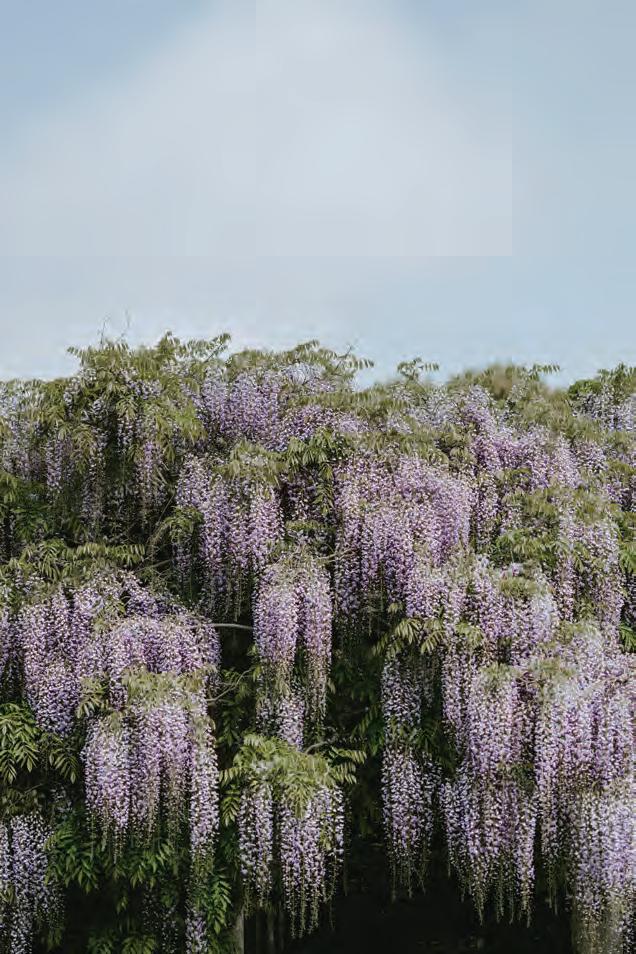
To celebrate the small town’s historic place as a pinnacle of Louisiana garden-making, Parker and the Feliciana Master Gardeners are expanding St. Francisville’s annual Spring Garden Tour event with a new partnership.
A NEW SEED LIBRARY OPENS IN WEST FELICIANA PARISH

Thhis spring, the West Feliciana Parish Library has announced the launch of its new Seed Library, funded through an LSU AgCenter Healthy Communities Grant. The program allows patrons to share and “borrow” seeds suited to our local climate, to enjoy their fruits at home, and then to bring back more seeds produced from the food or flowers thriving in their gardens. The West Fel Library joins other libraries across the state participating in the seed-sharing trend—an initiative that not only cultivates local plant life and gardens, but also community support. Other seed libraries can be found in libraries of Orleans Parish, Ascension Parish, Livingston Parish, Terrebonne Parish, Lafayette Parish, and East Baton Rouge Parish—which just announced its newest seed library location at the Main Library at Goodwood.
—Jordan LaHaye Fontenot
IN LAKELAND, LOUISIANA, AN EFFORT TO MOVE A MOUNTAIN
In Lakeland, Louisiana, the highest point of land isn’t actually land at all. Covering forty acres at its base hand rising seventy feet above the flatlands, “Mount Bagasse,” as it’s colloquially known, is a monumental pile of sugarcane bagasse generations in the making. Bagasse—the fibrous material left over after cane juice extraction—is the residue of more than a century of sugar production at Alma Sugarcane Mill, which has been processing raw sugar from cane grown at Alma Cane Farm since 1859. Each year the mill processes two million tons of Alma-grown cane to produce around 500 million pounds of
sugar, and generates 600,000 tons of bagasse. Around 250,000 tons are burned to power the mill. The rest goes on the pile. Mount Bagasse is growing by two to three acres per year.
But one industry’s waste is another’s opportunity. Enter Lakeland Biochar, a startup partnering with Alma to turn sugarcane bagasse into high-quality biochar. Biochar is a stable form of charcoal that, when added to soil, enhances fertility, increases moisture and nutrient retention, and promotes beneficial microbial activity while reducing soil emissions of greenhouse gases. Biochar is made in a gasifier, a high-tech process in which
“When you’ve got beautiful homes, beautiful gardens, and you’ve got passionate groups [like St. Francisville Beautiful and the Master Gardeners], it’s kind of a win-win for the community,” said Parker.
The longstanding tradition will continue—opening the front doors and garden gates to some of the town’s most opulent homes and gardens. But this year, the celebration extends into the afternoon, where guests can take advantage of an exclusive plant sale, lectures from master gardeners on topics like “Year-Round Color in Your Garden,” and hands-on workshops. Parker himself will host a lesson in building bouquets “from the grocery store to your dining room table.”
“I want to show people how to easily bring flowers back into the home, which I think has become a dying art,” he said. And it all culminates in a grand, Bridgerton-style coursed feast at the newly renovated home of St. Francisville’s hostswith-the-most, Brandon Branch and Jim Johnson—owners of the St. Francisville Inn.
“Brandon is known for his beautiful gardens and his décor,” said Parker. “This will be an open house, with a special garden tour leading up to the dinner,” which will be prepared by newly returned St.
bagasse feedstock is heated in an oxygen-starved environment. Gasification produces biochar plus a carbon-monoxide-rich syngas, which is burned to power the system—a virtuous cycle that produces very little exhaust. According to Lakeland Biochar founder and CEO Tyler Kerrigan, this makes gasification both efficient and environmentally beneficial, since sugarcane bagasse biochar is not only prized by farmers, gardeners, and soil remediation specialists, but also locks up significant quantities of carbon. So, biochar production generates carbon credits. Kerrigan explained that initially, Lakeland Biochar will build a gasification unit capable of turning 60,000 tons of bagasse into 6,500 tons of biochar while generating 15,000 carbon credits, which the company will sell. Eventually, the goal is to scale the operation to the point at which all the bagasse Alma
Francisville Inn chef, Michael Dardenne. “There will be candles, flowers, a quartet playing pop songs with the strings. It’s going to be a great party.”
Taking place on Mother’s Day weekend, the day-long event is also expanding its philanthropic reach—funding not one scholarship for West Feliciana High students this year, but three. “I think if we plant these seeds with them at a young age, that’s something they’ll carry on for a lifetime,” said Parker. Proceeds will also benefit local school gardens, the 4-H club, and beautification projects around town.
“We in St. Francisville love having people up in town,” said Parker. “The town is really becoming a destination for good restaurants and shopping. But we don’t want to forget what put us on the map, our homes and gardens.”
—Jordan LaHaye Fontenot
The St. Francisville Home & Garden Stroll will take place May 10. The open house & garden tour will take place from 8 am–1 pm ($40); lectures, workshops, and plant sale will take place from 1 pm–5 pm ($40); and the private dinner from 6 pm–9 pm ($250). Purchase your tickets at bontempstix.com.
produces is converted into commercially viable biochar while eliminating a costly waste product. In a state where 550,000 acres of sugarcane is harvested annually, it’s not hard to see the potential. Olivia Stewart, fifth generation owner of Alma Sugar Mill and President of Oxbow Rum Distillery, sees it. “My hope is that this can not only stop the [Alma] pile from growing, but also to begin to eat into the pile,” she said, “and that it can expand beyond Alma to help other mills as well. Because the problem of ever-increasing bagasse is everyone’s problem.” If coming up with a solution to a persistent problem for Louisiana’s sugar industry creates a sustainable, lucrative new state industry into the bargain, everyone wins. And perhaps, after more than 150 years, Mount Bagasse can begin to shrink at last.
—James Fox-Smith
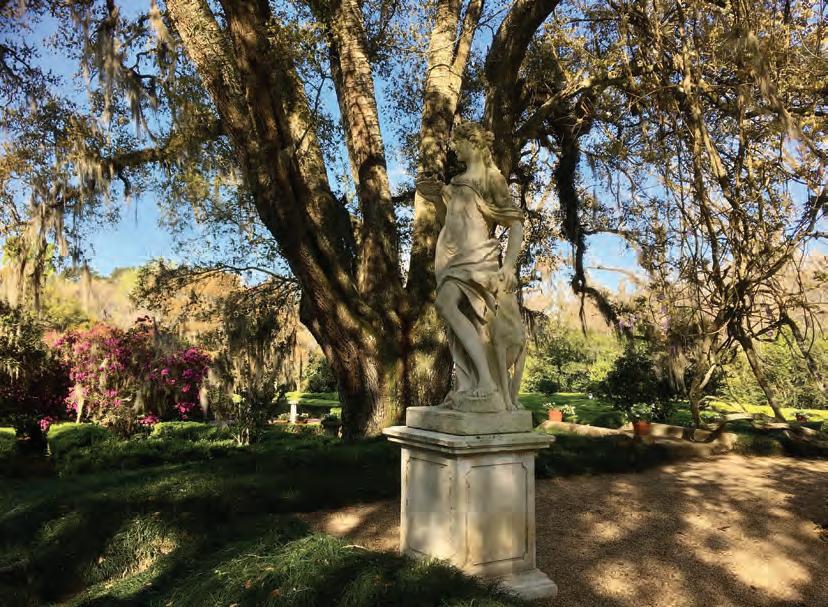
One of St. Francisville’s most enchanting attractions during spring, h Afton Villa Gardens has recently received a federal grant to hfund the continued preservation of the famed nineteenth century garden.
A competitive Historic Preservation Fund Award will enable a team to conduct a Historic America Landscape Survey (HALS) on the gardens, providing a record of the site in decades to come. Awarded by the U.S. Department of the Interior’s National Park Service, the federal funds totalling $58,935 will be used to document the site under the direction of Dr. Lake Douglas, professor emeritus in the LSU Robert Reich School of Landscape Architecture.
Douglas, whose background lies in historic landscapes, and who served as editor for Genevieve Trimble’s Afton Villa: The Birth and Rebirth of a Nineteenth-Century Louisiana Garden (LSU Press, 2016), has spent years researching and publishing on historic gardens in Louisiana. So, when he was approached with the opportunity to participate in the survey, he already possessed an abundance of knowledge about Afton Villa and its history. “I was acquainted with a lot of the work, just because of my interest,” Douglas said.
The historic garden, dating from the mid-nineteenth century, is the only element of the Afton Villa estate to have remained intact after the forty-room Gothic Revival mansion burned to the ground in 1963. Trimble and her husband purchased the property in 1972 and spent the next forty years restoring the once-legendary gardens, breathing new life into a formerly derelict landmark. By 2023, the gardens were ranked as the second most beautiful in Louisiana.
HALS is charged with creating a lasting, permanent record of significant cultural and designed landscapes in the country using interpretive drawings, written histories, and images. A team composed of Douglas and Duplantis Design Group of Baton Rouge began late last fall working on the two components of the project: Douglas on the historical narrative portion, and Duplantis on the technical drawings section.
“I thought it was a wonderful opportunity to get this property a little more substantially documented for the record, for future generations, so all of the information is in one place,” Douglas said.
The twelve-month project, when complete, will reside in the Library of Congress. Douglas sees the survey as a reckoning of relevance, noting people often take landscapes for granted and fail to understand the transformative process that created a certain site.
“The evolution of landscapes is an important thing for people to know about. You know, the garden there just didn’t happen. It represents a lot of layers of historically important things,” Douglas said. “I think it tells us a lot about how people responded to the land, and how people were involved with the land.”
Afton Villa’s Spring Season begins March 1 and lasts through June 30. Learn more about the gardens at aftonvillagardens.com.

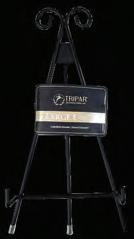







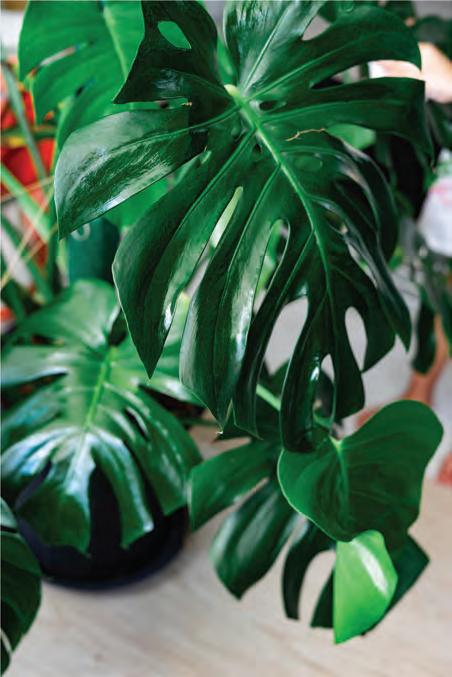
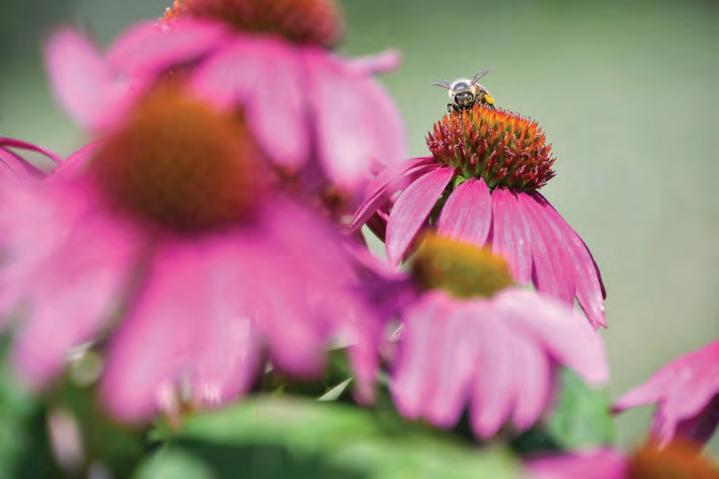



'TIS THE SEASON FOR FLOWERING,BLOSSOMING, AND OPENING UP—FROM PLANT SALES AND GARDENS TO SPRING FESTIVALS AND FUNDRAISERS • MARCH 2025

HISTORICAL FIGURES

THE BIGGEST CELEBRITY OF HIS TIME: GENERAL LAFAYETTE
Baton Rouge, Louisiana
Presented by members of Associated Women in the Arts, this exhibition at the Old State Capitol features art inspired by the Marquis de Lafayette—the first foreign general of the Revolutionary War. This exhibition, fittingly, highlights Lafayette's time in Louisiana in 1825. Find more information at the Associated Women in the Arts Facebook Page. 1
REWILDING
PRAIRIE STORIES: ART AND ECOLOGICAL RESTORATION ON LOUISIANA'S PRAIRIES
Lafayette, Louisiana
Prairie Stories: Art and Ecological Restoration on Louisiana's Prairies, on display at the Acadiana Center for the Arts Main Gallery, showcases the work of regional culture bearers in restoring Louisiana's coastal prairies. From Elemore Morgan Jr.’s landscape paintings, to a collaborative installation piece by Rush Jagoe and Maaliyah Symoné, the exhibition will explore the efforts of indigenous groups, artists, and scientists. Rewilding projects, such as
those by the Cajun Prairie Restoration Project, Atelier de la Nature, and the Acadiana Native Plant Project, will be showcased in the exhibition. acadianacenterforthearts.org. 1
7th - MAR 8th
BACKWOODS BEVERAGES
LOUISIANA MOONSHINE FESTIVAL
Leesville, Louisiana
Western Louisiana is embracing its history of "No Man's Land" with this exciting inaugural festival at the Vernon Parish Fairgrounds, honoring the region's history as a place just outside the rules (and proud of it)—along with a celebration of quite possibly the only legal moonshine outfit in the state. The familyfriendly event will feature food vendors (boiled crawfish has been promised), moonshine tastings, and opportunities to meet master distillers from around the country and close to home alike. Live music will keep everyone on their toes throughout the two-day event, performed by musicians like Mike Hughes, Emily Hillman, EV Mae, and more; and a special veterans tribute concert will take place on Saturday night. Gates open at 10 am each day; $15 for Friday; $20 for Saturday; $25 for the whole weekend. louisianamoonshinefestival.com. 1
TOURS OF HISTORIC HOMES AND SITES 2025
MAR 7th - MAR 9th
CULTURAL FESTIVALS INDEPENDENCE SICILIAN HERITAGE FESTIVAL
Independence, Louisiana
Celebrate all things Sicilian with the residents of Independence. At the fest, held downtown, you can make spaghetti, eat spaghetti, and even toss meat balls (as far as you possibly can! Yes, we're talking about a meatball throwing contest, friends.). Enjoy carnival rides, arts & crafts, a St. Joseph's altar, pageantry, and even a parade. The live music lineup includes favorites like Peyton Falgoust, Chase Tyler, Kings of Neon, and Rockin' Dopsie. More details at indysicilianfest.com. 1
MAR 7th - MAR 9th
ARTS & CRAFTS
"LIFE'S A STITCH" QUILT SHOW
Abita Springs, Louisiana
Days after Mardi Gras, Abita Springs Town Hall will host a quilt show presented by Ozone Layers Quilt Guild featuring over 100 hand-made quilts, wall hangings, and fiber art projects made by the members. The event will feature daily demonstrations, as well as a Jelly Roll Race, T-Shirt Quilt demo, and a lecture by Mary Green, fiber artist, on
Spring Pilgrimage
Spring Pilgrimage
March 8 - April 19

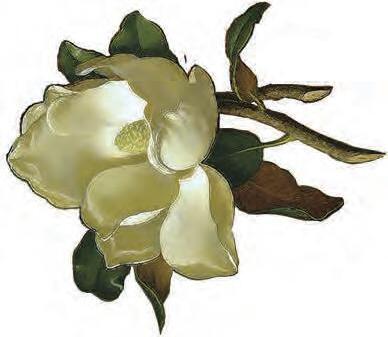
The Houses
Choctaw Hall
Dunleith
Ellicott’s Hill
Elms Court
Frogmore
Glenfield
Gloucester
Linden
Magnolia Hall
Rosemont
The Stone House
Sunnyside
The Towers
Fall Pilgrimage
Sept. 27 - Oct. 18
Year Round Tours 2025 Christmas Pilgrimage Nov. 22 - Jan. 3, 2026
littleeasytours.com or purchase tickets at houses

The Natchez Garden Club 215 S Pearl Natchez, Mississippi natchezgardenclub.org 601-443-9065
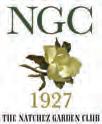
Art Quilts. Three quilts will be raffled. 11 am–4 pm. visitthenorthshore.com. 1
MAR 8th
FAST LANE
NEW ROADS CAR SHOW AND STREET FESTIVAL
New Roads, Louisiana
The City of New Roads & New Roads Main Street present the 16th Annual Spring Street Festival and Car Show, featuring over 300 participants, a raffle benefiting Pointe Coupee Homebound & Hospice, and awards galore. 8 am–3 pm. $40. bontempstix.com. 1
8th
SPRING SHOPPING
SHADOWS-ON-THE-TECHE ARTS & CRAFTS FAIR
New Iberia, Louisiana
Looking for a fun, family-friendly way to celebrate spring? Stroll through the Shadows-on-the-Teche Spring Arts and Crafts Fair in the gardens of the historic Weeks family home. Explore wares made by craftspeople from across the state, shop seasonal items, pantry staples, and clothing—and be sure to fill your belly
with delicious food from local vendors. 9 am–4 p.m. $5 for ages thirteen and above; free for children twelve and under. shadowsontheteche.org. 1
MAR 8th
GOOD EATS
DA CAJUN BURGER COOK-OFF
Morgan City, Louisiana
Chow down on burgers from local chefs and enthusiasts at Da Cajun Burger Cook-Off, held under the Highway 90 bridge in Morgan City as they gather to compete for the title of Best Burger in the Tri City Area. In addition to good eats, there will be live music, alcoholic beverages, and fun for the kiddos. 11am–6 pm. Admission is $10 and includes five sample tickets, plus one People’s Choice token to vote your favorite burger. cajuncoast.com. 1
MAR 8th
GOOD EATS NOT YOUR MAMA'S GUMBO COOK-OFF
Abita Springs, Louisiana
Nothing brings the people together like an old-fashioned gumbo cook off. Head


At NUNU, Anne Crownover and Janelle Hebert present an exhibition celebrating norm-breaking and risk-taking, led by creativity. Falling Out of the Box embraces the extraordinary and urges viewers to honor the unexpected. Opening reception March 14 from 6 pm–9 pm. nunucollective.org. Pictured above is Hebert's piece, "Rain Coming." Image courtesy of NUNU.
out to the Abita Springs Trailhead this weekend, and get lined up as early as 11 am. $10 gets you a wristband and a say-so in the People's Choice Awards. Besides the gallons of gumbo, attendees will also enjoy side items and beverages (adult and otherwise) provided for sale by local vendors and organizations. All proceeds will go towards city beautification projects, glass recycling, liter cleanups, and educational programs. Live music
until 3 pm. Details at the Keep Abita Beautiful Facebook Page. 1
MAR 8th
GREEN THUMBS
GARDEN DISCOVERIES: PLANT IT AND THEY WILL COME
Baton Rouge, Louisiana
“Plant It and They Will Come," hosted by the Baton Rouge Botanic Garden Foundation, is a butterfly-forward event


for gardeners led by Linda Barber Auld— known as the NOLA Bug Lady. Head to the Main Library at Goodwood to learn the ins and outs of crafting an oasis that will increase butterfly activity in your garden. 10 am. Registration available at ebrpl.co/events or call (225)-231-3750. ebrpl.co/garden. 1
SPRING SHOPPING
SPRING MERRY
MARKET
Gonzales, Louisiana
The Merry Market returns to Lamar Dixon Expo Center just in time for spring with a special, seasonally-appropriate market—featuring more than 350 booths offering clothing, jewelry, home décor, candles, toys, Christmas décor, food, bath and body products, art, and more. Saturday from 9 am–5 pm, Sunday from 10 am–5 pm. $10 admission, with a portion of the proceeds going to the Sparrow Foundation. Children under ten are free. $25 for advanced VIP Shopping, which grants early entry from 8 am–noon. There will also be a Kidz Zone to keep the tinies busy while you shop, featuring the Easter bunny, crafts, face painting, and more. Parking is free. merrymarket.shop. 1
BEVVIES
UNCORKED
FOOD & WINE SHOWCASE
Saint Francisville, Louisiana
Enjoy the best of St. Francisville cuisine, courtesy of the West Feliciana Chamber of Commerce, which will host an exciting "Uncorked Food & Wine Showcase" at The Mallory. The event will feature delicious food, fun cocktails, wine, and desserts from local restaurants. 3 pm–7 pm. $50; $40 for Chamber Members. business.westfelicianachamber.org. 1
PARADES
ST. PATRICK'S DAY
PARADE IN SLIDELL
Slidell, Louisiana
Join the festive spirit of the Olde Towne Slidell Merchants Association's beloved
St. Patrick's Day parade, starting at 1 pm. The fiftieth anniversary of this lively procession features over fifty floats, bands, dance groups, and plenty of Irishthemed throws from beads to ingredients for traditional Irish stew (that's right: thousands of heads of cabbage, onions, potatoes, celery, and carrots). Be sure to bring your pots to catch your supper. The excitement departs at City Hall. For inquiries, call (985) 641-1105. 1
MAR 11th - MAR 18th
ART OUTSIDE
SHADOWS-ON-THE-TECHE PLEIN AIR COMPETITION
New Iberia, Louisiana
"Plein air" describes the technique of creating art in the open air—a process that provides dramatically different results as artists adapt to a day's shifting weather patterns and angles of light. Nine years ago, the Shadows honored the artistic tradition that Weeks Hall began by establishing a plein air art competition, which returns to the historic house's grounds this month. In March, dozens of well-known artists from across Louisiana and around the South will come to town to have their blank canvases marked, then will head out into New Iberia and its surroundings to ply their pastels and work their watercolors. Artists' work will be exhibited and available for sale in the Shadows Visitor Center, when the competition winners will be announced on the evening of March 17. Complete details at shadowsontheteche.org. 1
MAR 13th
GREEN THUMBS
EBR MASTER GARDENERS
PRESENTS: POLLINATION AND NATIVE PLANTS
Baton Rouge, Louisiana
For those with green thumbs, or simply

those hoping to get a fresh start with their garden this spring as the weather warms up, stop by Jones Creek Library for an East Baton Rouge Master Gardener presentation. First, Master Gardener Carol Paine will discuss pollination, highlighting plants that pollinators love the most. Then, Master Gardener Gaynelle Wolf will introduce attendees to native plants ideal for a spring garden takeover, sure to help your garden thrive in the coming months. 6:30 pm. Free. ebrmg.wildapricot.org. 1
SPRING SIP, SOW, AND GROW
Mandeville, Louisiana
The St. Tammany Master Gardener Association's Spring Seminar at the Castine Center at Pelican Park in Mandeville brings gardeners together for a delightful morning filled with expert talks on horticulturalist subjects and delicious bites. This year titled “Spring Sip, Sow, and Grow,” the event will feature presentations such as "Louisiana Owns and Blooms," "Little Known Resources for Fruit and Vegetable Gardeners," and others on native plants and vermiculture, among other topics. 8 am–noon. $25. stmastergardener.org. 1


Beginning March 13th - 15th
MAR 13th - MAR 16th
FILM
FRENCH FILM FESTIVAL
New Orleans, Louisiana
The twenty-eighth New Orleans French Film Festival, one of the longest-running foreign language festivals in the country, will once again represent excellence in contemporary and classic Francophone cinema for audiences, this year at the Prytania Theatre Uptown. Live music and lectures will accompany a curated selection of short and feature-length French-films, all of which will be screened with English subtitles. Film passes are $85 and get you free admission into all in person festival screenings. neworleansfilmsociety.org. 1
MAR 14th - MAR 15th
GOOD EATS
JXN FOOD & WINE FESTIVAL
Jackson, Mississippi
Foodies'll be heading north the second they sniff out this new culinary festival in the heart of the up-and-coming food city of Jackson, Mississippi. This year, the festival kicks off on Friday with an exclusive dining experience at Jackson
chef Nick Wallace's restaurant, The Hen & Egg. Saturday brings the fullforce festival, featuring dozens of local and regional chefs offering small plates, samplings of wine, beer, spirits, and mocktails; a demo stage, and live music. Doors open at 6 pm, with early VIP arrival at 5 pm (which also includes an exclusive VIP area with hors d'oeuvres, an open bar, dedicated restrooms, and a celebrity chef meet and greet).
A portion of the proceeds will benefit the Mississippi Restaurant Association Education Foundation. Tickets start at $90. jxnfoodandwine.com. 1
MAR 14th - MAR 15th
BOOKWORMS
FESTIVAL OF WORDS
Grand Coteau, Louisiana
Grand Coteau's annual Festival of Words returns this year with three featured authors and two days of wonderfully wordy events—all for free. On Friday, writers A$iaMae, a Black, non-binary Southern poet, humorist and cultural worker; professor and author Darrell Bourque; and poet Tyler Robert Sheldon
will take part in a community reading with Q&As at the Hive, and then on Saturday will host writing workshops at the Thensted Center. Details at festivalofwords.org. 1
MAR 14th - MAR 15th
CULTURAL CELEBRATIONS
ACADIAN MEMORIAL
HERITAGE FESTIVAL
Saint Martinville, Louisiana
Looking back on more than 250 years of history, this celebration of all things Acadian—or Cadien (Cajun)— centers in Evangeline Oak Park, where there'll be jambalaya, gumbo, cracklin demonstrations, theatre, Cajun dance lessons and music, mask making, storytelling, Longfellow readings, kids’ activities, and more. A re-enactment will take place commemorating the historic arrival of the deported Acadiens into Attakapas Territory. Free. acadianmemorial.org. 1
MAR 14th - MAR 15th
CULTURAL CELEBRATIONS
CELTIC BAYOU FESTIVAL
Lafayette, Louisiana
The annual Celtic Bayou Fest returns, bringing the very best in traditional Celtic music and entertainment to
Lafayette. Downtown will be seeing green with cultural events including an Irish Whiskey Tasting, a Guinness Cook-off, a Pub Crawl, a Bailey's bake-off, a children's area, and more—all of this happening against a background of Acadian & Celtic medleys sparking inner urges to kick up your feet. Green attire encouraged. Friday Pub Crawl starts at 5 pm at the Grouse Room for $25; Kick-Off Party at $10. $20 in advance for Saturday Festival Admission; $25 at the door. $40 for full weekend passes. celticbayoufest.com. 1
GOOD EATS
AMITE OYSTER FESTIVAL
Amite, Louisiana
A staple of the local economy as well as the local palate, oysters have good reason to be celebrated in Amite. The festivities typically start up with the annual Chili Cook-Off and live music on Friday, followed by a full-day on Saturday of parading, oyster-eating, and twostepping, with a headlining performance by Rock Show NOLA. Sunday, get started with a church service and more live music performances, and enjoy a day of carnival rides, local food and drink, and pageantry galore—not to mention a healthy (or maybe not so healthy) portion of fresh oysters, all in Downtown Amite. amiteoysterfestival.com. 1

MAR 14th - MAR 22nd
PERFORMANCES
MARIGNY OPERA BALLET
PRESENTS: DUSK
New Orleans, Louisiana
Marigny Opera Ballet presents the world premiere of DUSK, a contemporary ballet by choreographer Cassi Abranches. The ballet is accompanied by an original score performed live by New Orleans indie rock group, People Museum. Held at the Marigny Opera House in New Orleans, the ballet engages with beginnings, endings, and hope. 8 pm. $60; $40 for students and seniors. marignyoperahouse.org. 1
MAR 15th
PARADES
COVINGTON
ST. PATRICK'S DAY PARADE
Covington, Louisiana
Irish blood runs thick in Covington, Louisiana—and even those who can't claim it have eagerly celebrated the heritage of St. Patrick's patronage in Louisiana since 2018 with the birth of the Covington Celtic Club and annual St. Patrick's Day Parade. The route runs from the Columbia Street Tap Room, and concludes with a block party at the corner of New Hampshire and Rutland Streets, where ladies and leprechauns alike may dance the afternoon away
for a St. Patty's block party. Noon. covingtoncelticclub.com. 1
15th
THE GREAT OUTDOORS
LOUISIANA TRUST FOR HISTORIC PRESERVATION
SPRING RAMBLE
Covington, Louisiana
Nothing like rambling along the small town roads on a gorgeous spring day. Join the Louisiana Trust for Historic Preservation for this seasonal tradition, featuring a self-guided tour of historic sites around the Northshore not typically open to the public. This year's ramble includes stops at Villa de la Vergne, Haller-Ward House, Waldheim Gardens/ Jahncke Estate, Otis House at FairviewRiverside State Park, Madisonville Cemetery, Dendinger House, Madisonville Museum, H.J. Smith & Sons General Store and Museum, Covington Presbyterian Church, Mann House, Katz House, and Christ Episcopal Church and Chapel. Start the day at Christ Episcopal Church, where you'll receive an introduction, an informational booklet, and details about each site. 9:30 am–4 pm. $50; $15 for students and teachers, includes a boxed lunch. Register at lthp.org by March 10 to reserve your spot. 1
THE GREAT OUTDOORS
AFTON VILLA GARDENS SPRING SEASON OPENING
Saint Francisville, Louisiana
Celebrate one of the most beautiful corners of Louisiana in full bloom with the Afton Villa Gardens Spring Season Opening, held at Afton Villa Gardens in St. Francisville. Take a stroll, enjoy a self-guided audio tour, and take pictures. Heirloom Cuisine will be on site serving beverages and lite bites. 11 am–2 pm. $40; free for children under 12. aftonvillagardens.com. 1
ART EXHIBITIONS
LAFAYETTE
STUDENT ARTS EXPO
Lafayette, Louisiana
The annual Student Art Expo in Lafayette, hosted by the Acadiana Center for the Arts and the Lafayette Parish School System, is back celebrating the talent of student artists from across the parish. The event pairs schools and businesses to host visual arts exhibits, performances, activities, and more throughout the day all throughout downtown. Expect an art parade, live painting demonstrations, a student artist market, and an interactive dance

HIGHLIGHTS FROM THE GREAT HIGHLIGHTS FROM THE GREAT AMERICAN SONGBOOK II AMERICAN SONGBOOK II

activity. 10 am–6 pm all over town. Free. acadianacenterforthearts.org. 1
CELEBRATIONS
PATTY IN THE PARC Lafayette, Louisiana
One of the biggest Saint Patrick's Day parties in South Louisiana—Patty in the Parc returns to downtown Lafayette starring local favorites DJ Digital, LVVRS, Dustin Sonnier, Wayne Toups, and Cupid. Gates open at 4:30 pm. $20 in advance; $25 at the gate. Visit Patty in the Parc's Facebook Page for tickets. 1
FARM TO TABLE DINNER Saint Francisville, Louisiana
Get ready for some good eats. Bayou Sarah Farms is hosting a farm to table dinner, which includes guest Chef Andy Roberts of Blue Moon Farms cooking over an open fire, and featuring forest-raised pork and grassfed water buffalo. Be sure to sample a complimentary cocktail (Sarah's famous fresh-squeezed margaritas) and take a tour of the farm. 4 pm. $175. Email sarah@bayousarahfarms.org to reserve a space. 1
THURSDAY, MARCH 20, 2025 SONGS OF THE SOUTH SONGS OF THE SOUTH
THURSDAY, MARCH 20, 2025

SATURDAY, MARCH 29, 2025 SATURDAY, MARCH 29, 2025



BB, KING OF THE BB, KING OF THE MISSISSIPPI BLUES MISSISSIPPI BLUES
THE MAGIC FLUTE THE MAGIC FLUTE
SATURDAY, APRIL 26, 2025
SATURDAY, APRIL 26, 2025
FRIDAY, MAY 2, 2025 FRIDAY, MAY 2, 2025 SLAVIC SERENADE SLAVIC SERENADE

THURSDAY, MAY 8, 2025

SATURDAY, MAY 10, 2025 SATURDAY, MAY 10, 2025
THURSDAY, MAY 8, 2025 ALWAYS…PATSY CLINE ALWAYS…PATSY CLINE



THE HEAVENLY LIFE: THE HEAVENLY LIFE: MAHLER- SYMPHONY NO. 4 MAHLER- SYMPHONY NO. 4
WHITNEY HOUSTON… WHITNEY HOUSTON… ALWAYS LOVE YOU! ALWAYS LOVE YOU!
THURSDAY, MAY 15, 2025
THURSDAY, MAY 15, 2025

SATURDAY, MAY 17, 2025 SATURDAY, MAY 17, 2025

Beginning March 15th - 19th
MAR 15th
ARTS & CRAFTS
CRAFTIN' CAJUNS CRAFT SHOW & MARKETPLACE
Houma, Louisiana
Benefit from the outsized ingenuity of a Cajun craftsperson at the HoumaTerrebonne Civic Center. The Craftin' Cajuns indoor craft show and marketplace features over two hundred vendors from 9 am–5 pm. houmaciviccenter.com/craftshow. 1
15th
PARADES
WEARIN' OF THE GREEN PARADE
Baton Rouge, Louisiana
Whether it's blue skies or pounding rain, this wildly popular Baton Rouge tradition will roll through the Hundred Oaks neighborhood and Perkins Road overpass area, spreading green goodwill to the thousands who come out in support of the Irish holiday. Come early to claim a spot on the "Wearin of the Green" route; parade begins at 10 am on the corner of Hundred Oaks and Acadian. wearinofthegreen.com. 1
MAR 15th
TREE HUGGERS
FESTIVAL OF LIVE OAKS
New Iberia, Louisiana
Louisiana loves its live oaks, and with good reason. Their beauty inspires, their branches offer shelter from the sun, their roots run deep. The Annual Festival of Live Oaks in live-oak laden New Iberia will offer arts & crafts, music, workshops, barbecue cook-off, and children’s activities—including face painting, pony rides, and more. 9 am–3 pm in New Iberia City Park. iberiatravel.com. 1
MAR 15th
CULTURAL CELEBRATIONS
CLOVER & KILTS FEST
Biloxi, Mississippi
This year, Clover & Kilts Fest— Formally Grillin’ On The Green—will feature award-winning barbecue, live entertainment, contests, craft vendors, and a prize for the best kilt at Biloxi’s Town Green. Be sure to catch the Irish Beard Contest, and Lucky Leprechaun Costume Contest, too. And, in the middle of the festivities, the Hibernia
Society’s annual St. Patrick’s Day Parade will pass by the festival area at 2 pm. 10 am–5 pm. Free. (228)-435-6339 or mainstreet@biloxi.ms.us. 1
MAR 15th - MAR 16th
DIY-ERS
PONTCHARTRAIN HOME SHOW & LOUISIANA FOOD FEST
Kenner, Louisiana
Explore the latest trends in kitchens, remodeling, flooring, outdoor living, and more, while tasting mouthwatering food samples at the 35th annual Spring Pontchartrain Home Show & Louisiana Food Fest, presented by JAAS Productions at the Pontchartrain Convention Center. 10 am–5 pm. $8. bontempstix.com. 1
MAR 15th - MAR 16th
SPRING SHOPPING
BATON ROUGE SPRING CRAFT AND VENDOR MARKET Gonzales, Louisiana
Hop on over to the Tanger Outlets in Gonzales for an all-things-spring market. Local vendors, seasonal treats, and other items for all occasions are sure to please. 10 am–4 pm Saturday; 10 am–5 pm Sunday. Free. See the Baton Rouge Spring Craft & Vendor Market Facebook Page for details. 1
MAR 15th - MAR 30th
THEATRE THEY PROMISED HER THE MOON Covington, Louisiana
In a new production by Playmakers Theater, the first American woman to test for space flight, Jerrie Cobb, steps into an isolation tank for a record-breaking nine hours as her memories unfold before her, from learning to fly a plane as a child in Oklahoma, to testifying in Congressional hearings about the under-the-radar, allfemale Mercury 13 space program. Based on a true story, They Promised Her The Moon is a compelling drama about the challenges of sisterhood and fighting for the greater good. Fridays and Saturdays at 7:30 pm; Sundays at 2 pm; Saturday March 29 at both 2 pm and 7:30 pm. $15–$20. bontempstix.com. 1
MAR 19th - MAR 23rd
BOTTOMS UP NEW ORLEANS BOURBON FESTIVAL
New Orleans, Louisiana
Are you known to bend an elbow? Then here's the fest for you. The New Orleans Bourbon Festival (that's the drink, not the street) brings food, spirit, and culture together. Events include






bourbon seminars, dinners, tastings, tours, live music, and beyond—all celebrating brands like Cathead, Four Roses, Maker's Mark, and more. Proceeds from the tickets go toward Kids Can NOLA, a nonprofit organization that benefits the welfare of local children. Single-day, food-only tickets start at $79, seminar-access tickets start at $89, with various bundles and VIP opportunities from there. Location TBD. Visit neworleansbourbonfestival.com for a full schedule and tickets. 1
MAR 20th
PERFORMANCES
"PORTRAIT OF LUDMILLA AS NINA SIMONE" AT THE ACA Lafayette, Louisiana
In this stunning French-language performance at the Acadiana Center for the Arts, Senegalese-Cameroonian singer Ludmilla Dabo tells the story of the life and music of jazz icon Nina Simone. Dabo uses theatrical tributes and musical performances to honor one of music's most legendary figures in a powerful performance. 7:30 pm. $35. acadianacenterforthearts.org. 1
MAR 20th - MAR 22nd
GOOD EATS
IOWA RABBIT FESTIVAL
Lake Charles, Louisiana
Not the state, but the small community of Iowa, near Lake Charles—where bunnies should beware, lest they come the stars of the show in a rabbit gumbo or jambalaya, especially at the Burton Coliseum Complex this weekend. Celebrating the economic and culinary impact rabbits have in Southwest Louisiana, this annual fest is a one-ofa-kind event, from the rabbit gumbo to crowning the new Miss Bunny, who will represent the festival at other state-wide festivals and competitions. Thursday is free admission night, where the carnival and vendors will be open, but Burton will be closed. $10; 12 and younger free. iowarabbitfestival.org. 1
MAR 20th - MAR 23rd
GOOD EATS
LOUISIANA
CRAWFISH FESTIVAL
Chalmette, Louisiana
Celebrating its fiftieth anniversary this

year, the Louisiana Crawfish Festival returns to St. Bernard Parish, where it has sustained a sense of community and generosity for half a century now. Expect hungry festival-goers to arrive by auto, air, bus, and train to enjoy 30,000 pounds of boiled crawfish with all the fixin's, as well as crawfish bread, crawfish pasta, crawfish pies, crawfish rice, and crawfish jambalaya. There's live music galore, arts & crafts vendors, and a carnival midway as well. All the eating takes place at the
Sigur Cultural Center. Free Thursday; $20 Friday; $10 Saturday and Sunday. louisianacrawfishfestival.com. 1
MAR 20th & MAR 29th
SOUND ON NATCHEZ FESTIVAL OF MUSIC
Natchez, Mississippi
Every May since 1991, the Natchez Festival of Music has been making Mississippi musical, staging a month-

long whirlwind of operas, operettas, Broadway musicals, jazz, and special concerts in historic venues around the city. Full schedule and details at natchezfestivalofmusic.com. 1
BEVVIES
WINE DOWNTOWN
Natchez, Mississippi
At Natchez Food & Wine Festival's newest event, Wine Downtown, participants will travel to over fifteen local shops in Downtown Natchez with their passport, which includes one glass of wine or beverage and a small bite at each location. 6 pm–8 pm. $75. bontempstix.com. 1
SPRING SHOPPING
ABITA SPRINGS WHOLE TOWN
GARAGE SALE & FLEA MARKET
Abita Springs, Louisiana
Each year in March since 1994, hundreds of Abita Springs residents have had their garage sales on the same day. If you fancy snatching up a bargain in this small-town celebration, come by Saturday between 8 am and 3 pm and
IS THIS THING ON?
TUNICA HILLS
MUSIC FESTIVAL & JAM
Saint Francisville, Louisiana
Once again, the hills come alive for the annual Tunica Hills Music Festival and Jam. Three stages welcome over thirty bands for concerts, jam sessions, instruction, and celebration of the arts. Bring your blankets, chairs, coolers, and of course your instruments and settle in for a beautiful day. 10 am–10 pm. Free. Details at the Tunica Hills Music Festival Facebook Page. 1
GET-TOGETHERS
WASHINGTON COMMUNITY
FESTIVAL
Washington, Louisiana
For decades, the whiskered fish was the guest of honor every year at the Washington Festival Grounds. Today, the spirit of the old Washington Catfish Festival remains strong, reincarnated into the Washington Community Festival, featuring many of the beloved activities and programming of the old fête, on Washington's Main Street. Expect blocks of vendors, live music, an antique car
Baton Rouge, Louisiana
The cups runneth over during the LSU Rural Life Museum's best-lubricated annual event, which definitely calls for designating a driver. The 20th annual Zapp’s International Beer Festival brings tastings of more than two hundred domestic and international beers and ales to the grounds of the museum, plus more than a few home brews, which always end up being a festival highlight. Non-alcoholic beverages will be available for those (heroic) designated drivers. Bottoms up because all proceeds benefit the Rural Life Museum. Don't forget your I.D.—participants must be twenty-one, for obvious reasons. 3 pm–6 pm general admission. $45; $20 for designated drivers; $65 for early admission. Tickets available at bontempstix.com. 1



brings Louisiana's unique stories to a worldwide audience through its annual exhibition of locally-made films. At Parkway Cinema 6, the jam-packed day will include several screenings, Q&As, panel discussions, and an awards ceremony to close out the event. 11 am–4 pm, with a VIP Celebration Party from 6 pm–10 pm at Riverside Reserve. Free. caneriverfilmfestival.com. 1
NATCHEZ FOOD & WINE FESTIVAL PREVIEW DINNER
Natchez, Mississippi
For the second annual Preview Dinner, the Natchez Food and Wine Festival is partnering with Church Hill Variety Restaurant, which boasts an open kitchen with indoor and outdoor seating, combined with a farm store stocked with grab-and-go meals, homemade preserves, produce, farm eggs, and ice cream. The dinner will feature Fan and Johnny’s Restaurant Owner Chef Taylor Bowen Ricketts of Greenwood and Caylen Caldwell of Wishes Bakery in Natchez. Wine and cocktail pairings will be provided with each course, along with domestic beer. 6 pm–9 pm. $125.



Beginning March 22nd - 26th
MAR 22nd - MAR 23rd
SPRING SHOPPING
MARKET AT THE RIVER ARTS & CRAFTS SHOW
Covington, Louisiana
Enjoy the serene, centuries-old riverfront property of The Rivers Retreat Center while stocking up on local, hand-crafted goodies—from pottery to prepared foods to jewelry. Presented by Shallow Water Stalkers, Lindsay Richardson Jones, and the Southern Handmade Crafter, this market will not only make for great shopping, but a beautiful day. 9 am–5 pm. $2. visitthenorthshore.com. 1
MAR 22nd - MAR 23rd
ARTS
ACADIANA OPEN STUDIO TOUR 2025
Lafayette, Louisiana
In perhaps one of the most far-ranging arts events in the region, Open Studio Acadiana annually presents more than one hundred artists and craftspeople, presenting simultaneously at over thirty studios or galleries throughout Acadiana, but with most of the artists concentrated
in the Lafayette area. The event has roots dating to the 1970s, George Rodrigue being the first ever Open Studio Acadiana participant. Many of the galleries and studios will have artists and craftsmen at their sites, and most will have works for sale—some still in progress. 10 am–4 pm both days. A special party to conclude the event will be held at the Sans Souci Gallery on Jefferson Street in downtown Lafayette, at 6 pm on Sunday. Free openstudioacadiana.com. 1
25th
FUN-GUYS
MEDICINAL MYCOLOGY
Baton Rouge, Louisiana
The LSU Hilltop Arboretum, partnering with the Louisiana Master Naturalists of Greater Baton Rouge, will offer "Medicinal Mycology" as part of its "Discover Nature" program. The talk, featuring biological engineer Jordan Gros, will introduce Louisiana medicinal mushroom species. Learn how to find and identify the mushrooms, as well as how to incorporate them into a healthy lifestyle.

6:30 pm–8 pm. $15; $10 for members. Register online at lsu.edu/hilltop. 1
MAR 25th - MAR 27th
ART OUTSIDE PLEIN AIR WORKSHOP WITH PEG USNER
New Orleans, Louisiana
This two-day Plein Air Workshop with Peg Usner dives into the spring beauty of Longue Vue's vast estate, allowing participants to set up easels in the gardens to capture the enchanting nature surrounding them. Usner will instruct and guide students through the sessions, which are perfect for beginning or advanced oil painters. Artists are expected to bring oil painting supplies. 9 am–noon. $160; $150 for Longue Vue members. longuevue.com. 1
MAR 25th - MAR 28th
CULTURAL CELEBRATIONS
DEWEY BALFA CAJUN & CREOLE HERITAGE WEEK 2025
Eunice, Louisiana
Learn first-hand from masters of Cajun and Creole music, dance, cuisine, and culture in a very Louisiana setting— Lakeview Park & Beach in Eunice. The Dewey Balfa Cajun and Creole Heritage Week (also known as "Balfa Week"), put on by the Louisiana Folk Roots
organization, is a true cultural immersion experience that includes workshops, jam sessions, featured artist presentations, and evening dances featuring some of the state's finest Cajun and Creole/ zydeco bands. Workshops in accordion, fiddle, guitar, Cajun and Creole vocals, local dance, and Louisiana foodways are on offer, with an instructor roster that features a who's who of Louisiana artists. Find all the details, including up-to-date schedule information, at lafolkroots.org. 1
MAR 26th - MAR 30th
INKLINGS
THE TENNESSEE WILLIAMS LITERARY FESTIVAL
New Orleans, Louisiana
The Tennessee Williams/New Orleans Literary Festival returns, presenting the thirty-ninth annual celebration of the city's astonishing literary legacy. The five-day fête offers a range of diverse speakers and performers, most of whom will shout "Stella" with enough encouragement. Most events (far too numerous to detail here, but which range from master classes and walking tours to theatre, food, and musical offerings) will take place in the French Quarter. Ticket prices vary depending on the activities or combination thereof. tennesseewilliams.net. 1

















Story by Jacqueline DeRobertis-Braun

Thhis spring, there are plenty of opportunities to join other gardening enthusiasts, newbies included, across the region at plant sales large and small, where you'll surely find inspiration and plenty of new flora for your home garden.
March 7–9: Baton Rouge Spring Garden Show and Plant Sale Green-thumbers (and all the others), rejoice: the 22nd annual Baton Rouge
Spring Garden Show will be held at the John M. Parker Coliseum on LSU campus, featuring a bountiful selection of herbs, flowers, native plants, fruit trees, and more. This year, the AgCenter will also host a speaker series, with topics including “Blackberry and Raspberry Production in Louisiana,” “Edible Plants of the Gulf South," “Conservation Corridors," and more. The talks will be held in the Nelson Memorial Building on the LSU campus just behind the Parker Coliseum, and are free and open to the public. 5 pm–8 pm Friday; 9 am–4 pm Saturday; 9 am–3 pm Sunday. $10; free for children twelve and under, and for students with an LSU and Southern University ID. For more information, call Brayden Echols at 225-578-1890, or email at MEchols@ agcenter.lsu.edu.
March 22: Livingston Parish Master Gardener Spring Plant Sale
Just in time for warmer weather, the Livingston Parish Master Gardener Program will host its annual plant sale at Southeastern Literacy and Technology Center in Walker. Peruse offerings from local plant vendors, including a varied assortment of herbs, vegetables, natives, pollinators, and more. Proceeds support community outreach and educational programs focused on sustainable gardening practices. 8:30 am–2 pm. Find more at the Livingston Parish Master Gardeners Facebook Page.
March 28–29: Southwest Louisiana Garden Conference and Expo
This regional conference and expo is perfect for the gardeners out there ready to jumpstart their yard for spring. Held at the Burton Coliseum in Lake Charles, the event features more than sixty vendors selling a variety of plants and outdoor decor, Master Gardeners with a plant health booth, and a flower show, among other attractions. 9 am–5 pm. $3; free for children twelve and under. swlmg.weebly.com/gardenexpo.html.
March 28–29: Northshore Garden & Plant Sale
Presented by the St. Tammany Master Gardeners Association, the Northshore Garden & Plant Sale is the ideal destination for anyone hoping to get a head start on their spring garden. Vendors specializing in roses, native plants, daylilies, vegetables, shrubs, and trees will be available (among others), and attendees will have the chance to explore garden art, plant material, and outdoor furniture options. Expect activities for the kiddos, educational speakers, and food concessions as well. 9 am–3 pm, both days. $5; free for children and first-responders. stmastergardener.org.
March 29–30: Spring Garden and Pet Show
The third annual Spring Garden and Pet Show, presented by River Road Historical Society in collaboration with the AgCenter and Louisiana Master Gardeners, promises two days of excitement for plant enthusiasts. Held at the Destrehan Plantation, the event features plant nurseries, arts and crafts, small businesses, and more. Animal rescue groups will also be on site for pet adoptions—and don't miss a petting zoo, beekeeping demonstration, and a presentation from the LSU Raptor Rehabilitation Program. 10 am–4 pm each day. $5; free for children under five. destrehanplantation.org. •


MAR 27th
GREEN THUMB
EBR MASTER GARDENERS
PRESENTS: SUPER PLANTS AND PRUNING SHRUBS
Baton Rouge, Louisiana
East Baton Rouge Master Gardeners present two talks at the Bluebonnet Library to prepare for spring in the garden. The first talk, given by Master Gardener Debi O'Neil, surveys Louisiana Super Plants that thrive in our state. Then, stick around for Master Gardener Leo Borders to teach on which plants to prune now, and which ones will keep until later. 6:30 pm. Free. brmg.wildapricot.org. 1
MAR 27th - MAR 29th FILM
NATCHEZ LITERARY AND CINEMA CELEBRATION
Natchez, Mississippi
Back for another year celebrating Southern authors and filmmakers, this year's Natchez Literary and Cinema Celebration will be held at Natchez
Convention Center. Themed, “Follow the Frenchman through Natchez: The Farewell Tour of Lafayette, A Bicentennial Salute,” the festival will feature lectures and panels on topics like the life and contributions of Lafayette, the history of America, and more. Learn more and find the full schedule at colin.edu/ community. 1
TOURS
NATCHEZ SPRING PILGRIMAGE
Natchez, Mississippi
"The most extensive tours of the most extravagant antebellum homes in America." That's the way the Pilgrimage Garden Club describes the Natchez Pilgrimage—the spring and fall tour of homes that has kept visitors coming back to Natchez since 1932. The city has managed to preserve the extraordinary architectural legacy of that wealth, while also paying homage to the enslaved individuals on whose backs that wealth was created. Today, Natchez's streets

remain lined with palatial mansions and filigreed townhouses, and each year the families that occupy them allow guests to nose through two-hundredyear-old homes, meet descendants, learn about the city's history, and generally get a residents' eye view of life in this most genial of Southern cities. Find details on other special events, dinners, and tours at littleeasytours.com, natchezpilgrimage.com. 1
MAR 28th - MAR 29th
GOOD EATS COOKING IN CENTRAL Central, Louisiana Cooking in Central is back, this time

You’re free to live your life out loud! Because you’ve got the compassion of the cross, the security of the shield, and the comfort of Blue behind you.



in partnership with the City of Central to bring plenty of tasty food and entertainment to Amazing Place. The fun begins a 4:30 pm Friday with boiled crawfish and performances by Thomas Cain Plays and Parish County Line. On Saturday, festival gates open at 11 am with kids' entertainment and the carnival. Chris LeBlanc plays at 6 pm, followed by Lauren Lee Band. And of course, at the heart of the thing is the cook-off itself on Saturday, with competitions in categories of brisket, jambalaya, pastalaya, and BBQ chicken. The kids are invited to get involved, too—showing off their own culinary skills. Festival is free. For more information and cook-off entry forms, visit cookingincentral.com. 1
BOOKWORMS
THE SAINTS + SINNERS
LGBTQ LITERARY FESTIVAL
New Orleans, Louisiana
Since 2003, Saints + Sinners LGBTQ Literary Festival has grown into an internationally-recognized event that brings together a who’s who of LGBTQ publishers, writers, and readers from
throughout the United States and beyond. The Festival, hosted by the same folks who bring us the Tennessee Williams and New Orleans Literary Festival and held over three days each spring at the Hotel Monteleone in the New Orleans French Quarter, features panel discussions and master classes around literary topics that provide a forum for authors, editors and publishers to talk about their work for the benefit of emerging writers and the enjoyment of fans of LGBTQ literature. Featured speakers this year include Ezra Adamo, Jan Edwards Hemming, Anne Laughlin, Jeff Mann, and many more. Details at sasfest.org. 1
MAR 28th - MAR 30th
CULTURAL CELEBRATIONS
ITALIAN HERITAGE FESTIVAL
Kenner, Louisiana
They gave us cannoli. They gave us marinara. They even gave us St. Joseph's Altars, which are basically piles of beautifully arranged, scrumptious food. So how can we pass up an Italian heritage fest, where these culinary delights will surely be on the menu? This celebration returns to Kenner's historic Rivertown
for its twenty-third year, with live music, local crafters, Italian food and seafood specialties, a historic photo display, St. Joseph’s Altar, and opportunities to talk with genealogical specialists. Details at facebook.com/kenneritalianfest. 1
THEATRE CABARET
New Iberia, Louisiana
Set in a Berlin nightclub at the close of the 1920s, Cabaret delves into the chaotic life of Berlin's natives and expatriates against the backdrop of the emerging Third Reich. Don't miss this classic performance at the Iberia Parish Performing Arts League. 7 pm; 2 pm Sunday. $22.58. ipaltheater.com. 1
MAR 29th
FUNDRAISERS
CRAWFISH
COOKIN' FOR A CAUSE
Mandeville, Louisiana
For the fifteenth year, Crawfish Cookin' for a Cause will host its popular headsucking fundraiser at Mandeville's Lakefront Splash Park, benefitting local families affected by catastrophic illness. This year's beneficiaries are Grant's Gift Foundation and HARK. Tickets are $40 in advance, which gets
you a ton of crawfish. 11 am–5 pm. crawfishcookinforacause.com. 1
MAR 29th
THE LONG WAY HOME
BRITISH MOTORING FESTIVAL
Covington, Louisiana
Hold onto your hats, chaps. The British Motoring Club of New Orleans returns for the 33rd annual British Motoring Festival at the Tammany Trace Covington Trailhead and Firehouse Event Center for a day dedicated to British cars and motorcycles. Interested parties can enter their car or bike, or stop by to view the automotive excitement. bmcno.org. 1
ART EXHIBITIONS
ST. LANDRY PARISH STUDENT ARTS EXPO
Opelousas, Louisiana
Head to Opelousas's Courthouse Square for a celebration of area student artists, featuring performances by local school bands, choirs, and theatre groups, as well as visual arts exhibitions and an artist market. The event is a partnership between the St. Landry Parish School Board and the Acadiana Center for the Arts. 10 am–3 pm. Free. acadianacenterforthearts.org. 1


MAR 29th
GET-TOGETHERS
COMMUNITY
HISTORY FESTIVAL
Pride, Louisiana
The Pride-Chaneyville Branch of the East Baton Rouge Parish Library hosts this community history festival for the fifteenth year. It's a day of fun, food, and games. This year's theme is "Country Crafts." There will also be a marketplace with a variety of local vendors. The Louisiana Lagniappe Dulcimers and the Upbeats will provide music, and once an hour it's time for the ever-popular oldfashioned Cake Walk. 10 am–1:30 pm. ebrpl.com. 1
MAR 29th
BLOOMS
GARDEN WORKSHOPS: SPRING FLOWER ARRANGING
New Orleans, Louisiana
Head to Longue Vue for this Spring Flower Arranging gardening workshop, directed by greenhouse operations lead Leigh Gradiz. Sip prosecco while arranging springtime blooms—ideal for a creative afternoon with friends or family. Open to all ages, but children must be accompanied by a ticketed adult, with a two-children maximum. 1 pm–3 pm. $85; $75 for Longue Vue members. longuevue.com. 1
MAR 29th
HOOK, LINE, SINKER
BIG BASS FISHING RODEO & FISHTIVAL
New Orleans, Louisiana
The Louisiana Department of Wildlife and Fisheries (LDWF) and New Orleans City Park will host the 76th annual Big Bass Fishing Rodeo and Fishtival in New Orleans City Park. The tournament is catch-and-release, with anglers vying to land the largest bass of the competition. The Battle for the Bass competition is also open to students in seventh through twelfth grades, offering an opportunity for them to represent their schools.
Kayakers and other paddlers can compete in the Boats on the Bayou competition on Bayou St. John. After the competition, the Fishtival will commence with live music, jambalaya for sale, exhibits, and activities for kids. Fishing competitions begin at 6:30 am, Fishtival is from 9 am–noon. Find more information at bigbassfishingrodeo.com. 1
MAR 29th
GOOD EATS
LOUISIANA CRAWFISH BOIL CHAMPIONSHIPS
Marrero, Louisiana
For twenty-three years now, Louisianans have clambered over one another to prove themselves as the best crawfish boiler
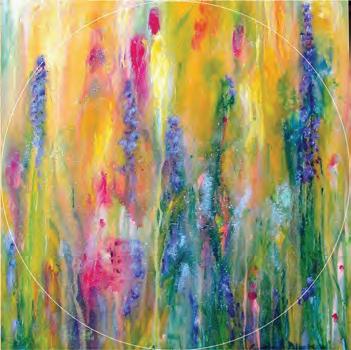







in the state at the annual Crawfish Boil Championships, held at the Immaculate Conception School in Marrero. The event is sanctioned by the State of Louisiana as the official competition for boiling, and this year it's looking like over sixty teams will be heating up their pots to serve an estimated 40,000 pounds of mudbugs.
A $30 ($18 for students) wristband gets you all the crawfish you can eat, with options to purchase other food, beer, and refreshments onsite. Details at the Louisiana Crawfish Boil Championships Facebook Page. 1
MAR 29th
GOOD EATS WORLD CHAMPIONSHIP CRAWFISH ÉTOUFFÉE COOK-OFF
Eunice, Louisiana
The étouffée extravaganza has Eunice simmerin' again this year with crawfish and good times galore. And though we're pretty sure places like Germany, Thailand, or Chile aren't competing in the cook-off, we like the sound of world championship, too. The Cook-Off kicks off at the Northwest Pavilion at 10 am. While live Cajun and zydeco music play in the background, get to tasting. And don't miss the arts and crafts vendors, live music, and family fun while you're out there. Free. etouffeecookoff.org. 1
MAR 29th - MAR 30th
RETAIL THERAPY
SLIDELL SPRING STREET FAIR
Slidell, Louisiana
In the heart of Olde Towne Slidell, upwards of two hundred vendors gather to peddle antique furniture, glass, vintage clothing, jewelry, collectibles, handmade crafts, and things to eat. It's a colorful, walkable opportunity to find a wide range of merchandise, and typically draws around 10,000 people each year. 10 am–5 pm. Free. slidellstreetfair.com. 1
MAR 30th
SOUND ON ABITA SPRINGS
BUSKER FESTIVAL
Abita Springs, Louisiana
If you brake for buskers, don't miss the Abita Springs Busker Festival at the Trailhead. This festival showcases the talents of young musicians honing their craft on Louisiana's street corners and far beyond. Plenty of food, and of course Abita beer, will be available at the event. 11 am–7 pm. Free. louisiananorthshore.com. 1
For more events, visit countryroadsmag.com/eventsand-festivals.








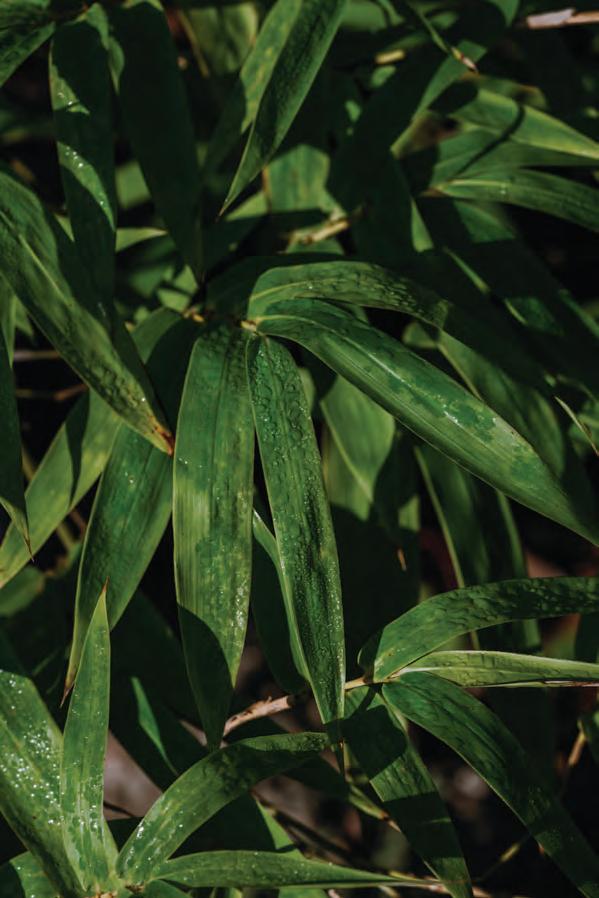

Mbecoming a New Orleans bamboo icon, but paying off student debt can lead to unexpected vocations.
It began with a two-storey house that loomed over Sanders and his then-wife’s backyard, removing any semblance of privacy for the couple when spending time outside. Sanders, who already had an affinity for gardening, remembered there was a type of non-invasive, clumping bamboo that could provide a natural screen when planted in a line. He found a supplier and purchased $100-worth of bamboo—an amount that
“So I decided to sell a few plants and upcharge them a little bit, and then make a bit of my money back,” Sanders recalled. “As soon as I posted an ad for those plants online, they sold out. And I thought, ‘Wow, that was an easy way of making money.’”
He turned his initial $100 investment into $200, which he turned into $400. “And then I scaled up, and started learning about propagating bamboo,” he said. “I learned that I could take one plant and turn it into two plants. So instead of doubling my earnings, I would start making vastly more on each sale.”
Selling bamboo from his backyard turned out to be a convenient way to pay off his student loan debt—with the added bonus that propagating bamboo was something he actually enjoyed. After a few months, his thenwife suggested he officially start a business, since he seemed to derive so much joy from the venture.
In December 2015, he purchased an inexpensive property in the lower 9th Ward, which was still reeling from Hurricane Katrina’s catastrophic flooding a decade before. Sanders, a journalist by profession with no formal horticultural training, then set about learning to grow and maintain a plant nursery.
It was just the beginning of what would become an unlikely gardening destination in the city—not just for those seeking guidance on different types of bamboo, but also for anyone searching for a little peace, greenery, and shade amid the chaos of everyday life.
“I can be somewhat compulsive, by which I mean I'll get an idea, and no matter how impossible it seems, I cannot let go of it until it happens,” Sanders said. “There is really no practical business reason why I should spend so much time trying to create this sort of urban jungle in an infrequently visited part of town.”
Sanders’s childhood was idyllic, filled with memories of lush outdoor adventures. He grew up in northern Alabama—a city child, but one who lived on the edge of a forest.
“Ever since I can remember I've always loved spending a lot of time outside,” he said. “My mother is a master gardener, and so being outside, being with my mom in the garden, was just … my ideal way to spend the day.”
Those youthful experiences forged within him a dedicated, constant yearning for physically and intellectually stimulating endeavors, and a drive toward careers that would push him outdoors (he has a master’s degree in archaeology). According to Sanders, he has spent time in about a dozen states and traveled extensively, even traveling to New Zealand as a teenager. This urge to explore, coupled with apparently boundless energy, would serve Sanders well as a journalist. And his eagerness to learn about new subjects and delve more deeply into every facet of them would also ultimately contribute to his passionate escapades as a gardening guru.
“When I was a child, I was never very good in school, but I was always somewhat proficient at learning things on my own,” he said. “If I found something that I liked, I would get hyperfixated on it.”
For the past ten years, the something has been bamboo—and that interest has grown into a larger captivation with horticulture and landscape design.
Now the editor of BAMBOO Magazine, the official publication of the American Bamboo Society, Sanders immerses himself full-time in the nuances of the plant and spends his time talking to experts who gladly fuel his interest. He doesn’t expect everyone who visits the nursery to know everything (or even anything) about bamboo, and he has a spiel prepared for hesitant buyers.
“Not all bamboo is invasive,” Sanders said. “There are over 1,400 species of bamboo in the world and counting, because new species are still being discovered all the time. And many of them do not become invasive.”
Those non-invasive varieties grow in a clump, a clus ter of contained shoots ideal for privacy screening pur poses. Say you wanted a twenty-foot privacy screen; five plants, about four feet apart from each other, would cre ate a wall of soaring greenery. For his purposes, Sanders searches for diversity in the bamboo he carries, though he primarily focuses on the types that will best flourish in South Louisiana and the Gulf Coast environment.
Once you account for climate zones and humidity, things get more interesting. Sanders carries some plants that only reach twelve feet tall, while others tower at six ty feet when fully mature. Some of his bamboo is pow der blue, some yellow, some green, some variegated; some are thick and robust, others are thin and stately. The clear favorite among his customers is called, some what whimsically, graceful bamboo ( gracilis)—ideal for smaller yards and urban settings.
Apart from a successful business venture, the nursery also quiets what Sanders describes as an active mind, creating a haven for contemplative thought and the relief of something real, tangible, and present.
“I always have these monkeys in my brain that are just doing somersaults and running around and playing,” Sanders said. “And being in a garden helps calm down those monkeys. Being in a plant nursery also helps calm down the monkeys. Being in people's yards and beautiful spaces helps do that.”
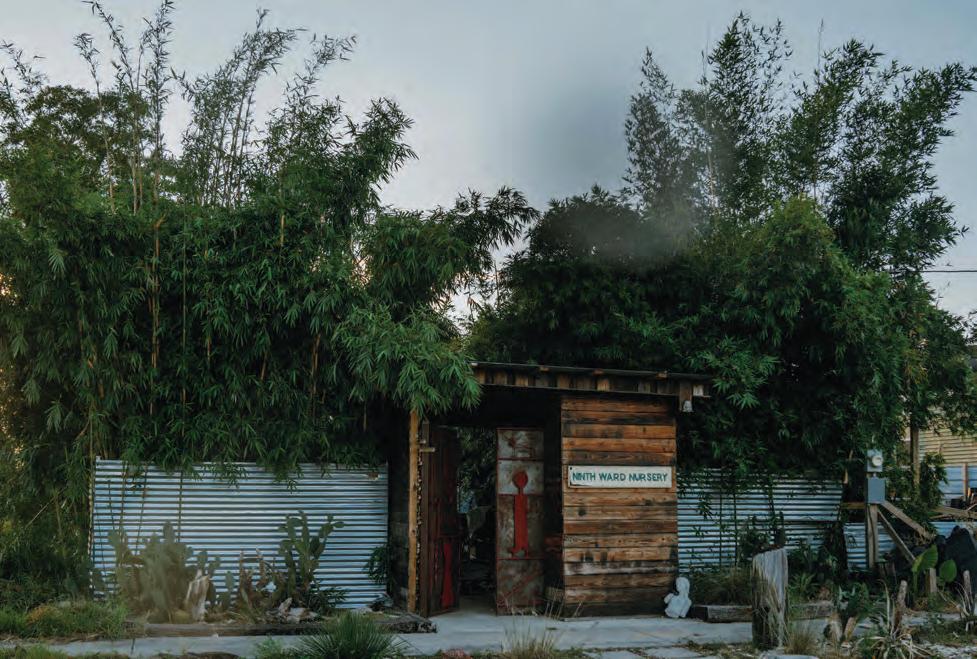

In many ways, Sanders has always been dreaming about someday-plants and their homes. He cites a litany of sites that have inspired him visually over the years, from temperate forests in New Zealand to botanical gardens he has sought as a refuge on his many travels: Denver Botanic Gardens, Marie Selby Botanical Gardens in Sarasota, and Fairchild Tropical Botanic Garden in Coral Gables, among others.
These are the gardens that danced through his mind, in riotous color, when the coronavirus pandemic stilled the world in 2020 and early 2021. He had already expanded his initial operation, incorporating tropical plants in addition to the thousands of varieties of bamboo, in 2018. But now, Sanders decided his nursery would morph into “a botanical garden where the plants are for sale.” That became his mission during lockdown—to build out the nursery, drawing on landscape design that inspired him.
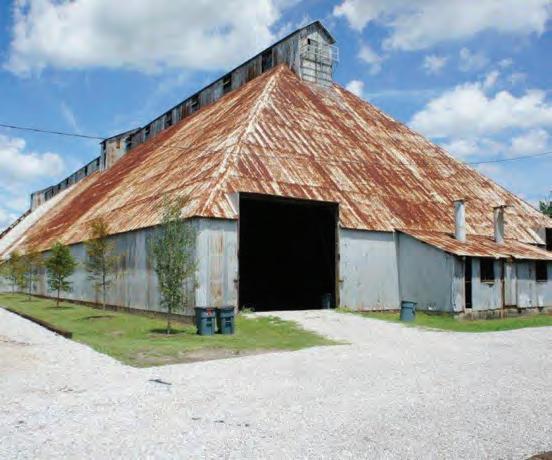



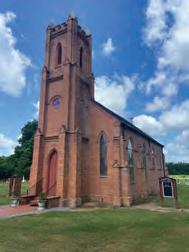
“I think of landscape design as art that you can walk through,” Sanders said. “It's multi-dimensional. It's multi-sensory. You can smell it, you can see it, you can hear it, things on the tree you can taste, you can touch things. There's so many different tactile things in a garden, and that's what really continues motivating me.”
Arranging plants in a pleasing, interesting way has stirred Sanders’s imagination for decades. As far back as 2003, when he first bought a house in South Florida, Sanders would spend large blocks of time sitting in



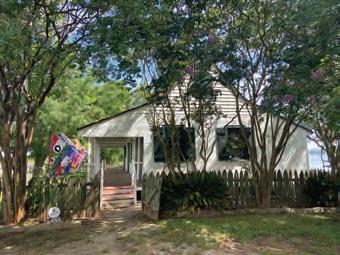



a lawnchair in his backyard, studying the blank stretch of grass (save a lonely kumquat tree) and envisioning his future garden.
Eventually, he would mow the grass as short as possible—”like a crazy person”— and take a can of spray paint, deliberately marking spaces on the lawn where he wanted to place different plants.
Today, Sanders continues to search for small moments of drama in the grand design of the nursery. Since he has no formal training, part of his practice involved reverse engineering the processes other people underwent to create their exterior spaces and gardens. The intentionality, from colors and textures to height and topography, fascinates him.
“You can do a lot with hills … little hills and little ponds,” he said. “God, you can create a crazy garden. I've often said that if I was not running a bamboo nursery, I would be designing miniature golf courses.”
Rather than rows and rows of plants laden with price tags in an impersonal, martial line, Ninth Ward Nursery is a communal experience, a peaceful pause, a space for positivity. Since Sanders’s transformation of the space, the nursery has become a sort of magnet for creative types intrigued by its tropical, escapist feel, or simply enamored with its beauty. A music video has been shot there, along with a film and several dozen photo shoots. Sanders has (quite proudly) hosted a friend’s birthday party, and even arranged a petting zoo there. The buying and selling of bamboo in such an environment feels almost incidental, a fact that does not appear to bother Sanders.
“I’ve always looked at gardens as a sort of refuge, and I know that I'm not alone in that,” he said. “I know that that's a very common thing, and so being in these places, it's hard not to be inspired.”
The Friday after the historic snowfall in New Orleans this past January, Sanders was in a bad mood. His tropical plants, which he had tried to keep warm and safe during the freeze, had been exposed to the icy temperatures when he was stranded and unable to tend to them for two days.
“The good news is, the bamboo is fine. It looks a little beat up, but it's fine,” he said. “The bad news is, the tropical plants are absolutely just … they just got destroyed.”
Undeterred, he took to the company’s social media to mourn, but also to dutifully remind customers concerned about their purchases that their bamboo is “stressed, not dead” from the cold.
Sanders is not one for complaining, and he knows other folks had it worse than he did, but he was not thrilled by the outcome. He envisions the nursery as a haven, a sanctuary in a part of the city that was flooded with feet of water during Hurricane Katrina when the levees failed along Industrial Canal; he feels strongly about keeping it lush and vital as a part of the community it has claimed as its own. Amid the crumbling remnants that linger even twenty years after the hurricane, the nursery is a sign that things grow again.
“Block after block after block, you will see foundations of homes that are no longer there, and then right in the middle of it is this little oasis that takes up two residential lots and is completely walled in, and is surrounded by bamboo on the inside, and it's filled with boardwalks, and water features, and antique statuary, and a collection of antiques, and a couple cats, and a sign that says, ‘Ask us for a free popsicle,’” Sanders said. “As much as I like doing business with people, I genuinely want people to come to the nursery, and even if they don’t buy anything, to have a pleasant experience in this little oasis.” • ninthwardnursery.com

• 2 to 3” layers of composted organic matter will fuel soil organisms. Create a forest ecosystem under your tree.
• Improve soil health (de-compact, aerate, improve drainage).
• Apply continuous small doses of elements, less nitrogen, more phosphorus, potassium, calcium, magnesium and beneficial soil microbes.
• Remove competition: remove turf, vines, shrubs, and other competing canopy.
• Expand resource space. Mulch open soil space.
• Prune to reduce mass (reduce exterior crown weight). Support mass and control movement via installing tree support system, TSS’ (cables, brace rods, guys, and limb props).
• Protect high value trees from lightning.
• Manage against insects and disease infection.
• Minimize injury and soil damage. Keep people and machines away.

Story by Kristy Christiansen • Photo by Paul Christiansen

Off the beaten path in New Orleans’s Central hCity, a rose-adorned fence offers glimpses hof a secret garden through its wroughtiron pickets. Behind these gates, Jeanette Bell lives out her retirement dream, tending her flowers and herbs (and supplying both to restaurants and florists around town) in her beloved Fleur D’Eden.
“I’m eighty, and I’m retired, but I have a good reason to continue working because I enjoy the people I meet,” explained Bell, who is a neighborhood fixture and often toils alone in her 9,000-square-foot garden. “I mean, I’m selling flowers to a chef who won the James Beard Award!” She’s talking about one of her latest clients, Chef Serigne Mbaye of the award-winning Senegalese restaurant, Dakar NOLA. Her flowers adorn the tables in the restaurant.
Bell’s floral adventures began forty years ago in Detroit, where she and her husband moved from her home state of Mississippi. Originally a teacher, Bell took a break to raise her children and became involved with her neighborhood garden, where a love for flowers bloomed. Deciding she wanted to plant commercially for the City of Detroit, Bell dove into horticulture studies and successfully passed the city’s exam and interview—though alas, she didn’t get the job. Undeterred, she started a small business planting flower beds for commercial establishments.
“My first account was with an advertising agency,” reminisced Bell. “I planted the window boxes with hanging geraniums, and then I would go once a week,
take a hose, and water them from the ground floor. People started calling the agency because the window boxes were so pretty.”
Bell’s business spread through word of mouth, and she soon began providing flowers for tables at small restaurants in the area. “Forty years later, I’m still doing that,” she grinned. After leaving Detroit, the family briefly came to New Orleans, where Bell grew bedding plants in their rental’s backyard and sold them at the farmer’s market across the Mississippi River. Then, they headed to California, and Bell started teaching again and working as an administrative assistant, while still dabbling in gardening. In 1990, they returned to New Orleans—this time to stay. Bell took a job with Scholastic while selling flowers at the farmer’s market.
“I started following the Harvard Study on Aging,” Bell explained, proudly adding that her daughter went to undergrad at the university. “They advocate that while you’re still working, [you should] decide on the job you want in retirement, because it’s very important to retire to a job. So, while I was working for Scholastic, I started preparing for this job.”
She set about growing her flower business by acquiring a blighted property on Baronne Street in 2003 and naming it Fleur D’Eden. She moved her flowers over from the community garden and started transforming her new property into a rose garden.
“I loved roses all my life,” explained Bell. “I wanted to write a book about roses because so many people don’t know much about them. They think the long-stem bud
form is how you get a rose. So, I set up the garden with around 500 bushes and got a photographer here. I was writing the text when Katrina came.”
After evacuating during the hurricane, Bell returned to the city and discovered the area’s chefs were having difficulty finding fresh herbs—a need she could fulfill.
One of her first clients was Chef Ian Schnoebelen at his restaurant Iris, and later, Mariza. “He always wanted basil—cinnamon and lemon basil, Lacinato kale, thyme, parsley, mint, and each year, I would grow him a selection of peppers,” she detailed. “He wanted a variety of hot peppers to make a pepper sauce for oysters. He would can it, and you would see it displayed in the restaurant. He always wanted them as close to ripe as possible because they were sweeter that way.”
When Chef Steve McHugh was at Restaurant August and then Lüke, Bell provided him with fresh bay leaves. “He had such an aversion to dried bay leaves that he wanted to acquire land to grow them himself,” she laughed. “He also wanted five pounds of fresh dill per week.”
Even making room for the herbs, Bell still maintains 300 rosebushes in Fleur D’Eden. Kathleen Currie
of Smoke Perfume makes a rose glycerite out of Bell’s Cramoisi Superior rose, a crimson flower that dates back to the 1800s. “I call it my garden mascot because it covers the whole front of my garden,” said Bell. “It was given to me by a friend who died at 100 years old the year after Katrina, so it always reminds me of him.”
Bell and her garden have been featured in two books, Grace Bonney’s Collective Wisdom: Lessons, Inspiration, and Advice from Women over 50 and American Roots: Lessons and Inspiration from the Designers Reimagining Our Home Gardens by Nick and Allison McCullough and Teresa Woodard. “When I said yes to American Root s, little did I know I would be in a book with million-dollar gardens,” Bell giggled. “I haven’t read it myself because I don’t want to intimidate myself by looking at what other people have. I just want to focus on what I do.”
Even at age eighty, Bell is still trying new things in the garden. She is determined to grow a Medallion rose; an heirloom known for its massive, apricot-colored blooms. “It’s my favorite rose,” she explained. “I grew it as a test rose over forty years ago in Detroit because I wanted a beautiful plant that I could look at out the window while washing dishes. I’ve tried to grow it ever since, and I’ve failed miserably. It’s the only rose I cannot grow successfully, but this year, I will spend any amount of money to buy that rose again because I really want to enjoy it.” In the meantime, Bell will keep living her dream, gardening amidst the flowers she loves and sharing them with others. •
March is Colorectal Cancer Awareness Month
For lots of folks, turning 50 represents an exciting landmark—the beginning of a new chapter, a renewed sense of self and a refreshed dedication to adventure. But among the celebrations, don’t ignore another vital milestone: getting a cancer screening. Sure, a colonoscopy doesn’t match a splurgy trip or an epic birthday party, but scheduling one when you turn 50 can turn out to be a real lifesaver.
Just ask Clinton, Louisiana, general contractor Christopher Hitchens, Sr.
Following his first colonoscopy in July 2023—two months after his 50th birthday—Chris was shocked when his gastroenterologist reported finding a mass on his colon. The physician advised aggressive additional screening and treatment, and a subsequent CT scan revealed that the cancer had spread to Chris’s liver. Chris was placed in palliative care, which eased pain and provided comfort and stress relief while he subsequently underwent treatment.
“At that point, the results of all the scans said that I was Stage 4,” Chris recalled. “I thought, ‘this is a blow.’ ”
Chris experienced no symptoms. He exercised regularly, ate well and limited fried foods. Although the father of three still felt in his prime, Chris was part of a worrisome trend that has seen higher numbers of younger Americans being diagnosed with colorectal cancer. While rates have been declining slightly among older people since the mid-1980s, they increased by an average of 2.4% each year between 2012 to 2021 in patients younger than 50 years of age, according to the American Cancer Society.
“The crazy thing was I felt great,” he said. “It was a huge shock.”
Chris didn’t let the grim news deter his fight, though, and neither did his medical team at Mary Bird Perkins Cancer Center. Within two weeks, his doctors designed an individualized treatment strategy, including chemotherapy and surgery to remove eight inches of colon and about three inches of small intestine. The small amount of cancer detected in his liver was also surgically removed.
Throughout his treatment, a Mary Bird Perkins patient navigator helped Chris understand what was happening, connecting him with support services to facilitate the journey. His team also included a nutritionist who designed a diet program to help minimize the side effects of chemotherapy while ensuring that Chris kept getting enough protein.
Remarkably, Chris succeeded in remaining positive throughout his treatment, leaning on his family, his friends, and his deep Christian faith. Maintaining a strong, future-focused mindset was made easier by Mary Bird Perkins’ patient-centered culture, he says.
“They treated me not as a number, but as an individual,” Chris said. “I felt like they genuinely cared.”
Following his surgery and treatment, Chris has been cancer-free since February, 2024. He returns to Mary Bird regularly for scans, which have shown no sign of cancer, and maintains a healthy diet and exercise regimen—along with lots of prayer, he adds. Chris says he’s grateful to the healthcare professionals at Mary Bird Perkins for springing into action with such clarity and compassion.
“I could not have picked a better team of individuals to care for me,” Chris said. “From the person who greeted me when I walked in the building, to the person in the lab taking your blood, to Medical Oncologist Dr. Ryan Shows and his team, and to the nurses in the infusion lab—I mean, it was absolutely stellar.”
Above all, Chris says, he’s grateful for the science of early detection. Although reaching a 50th birthday is surely a milestone worth celebrating, when it comes to saving lives, a timely colonoscopy sometimes turns out to be the most important gift of all.
To determine if a screening is right for you, talk to your primary care physician or visit marybird.org/get-screened to access a free screening provided by generous community donors.


BUILDING A FLOWER FARM IN KILN, MISSISSIPPI FROM SCRATCH
Story by Mimi Greenwood Knight
When Teri Wyly decided to start a flower farm, after ending her forty-year career as an environmental attorney, she had never grown anything before. “I was never a gardener. In fact, I used to pay a service to keep the plants alive in my office,” Wyly laughed.
You’d never know it to visit the 500 lush acres of her property, La Terre Farm in Kiln, Mississippi. Named for the nearby Bayou La Terre, what was once virgin timberland is now crisscrossed by walking trails, dotted with artesian-fed ponds, and proffering fresh flowers and greenery for the local community. The aptronym La Terre translates from French to “the earth,” connecting the environmental passions that directed Wyly’s first career to her desire for communion with it, which inspired her second.
Operating the farm with her son Connor, Wyly has endeared herself to their Coastal Mississippi neighbors not only with a CSA-type flower subscription but by hosting agrotourism events ranging from mother/ daughter teas to yoga wellness retreats, from flower arranging workshops to open-air concerts and school field trips. Today, they also take their flower trailer off site for a build-your-own-bouquet experience at baby showers, farm-to-table dinners, and other events.
The origins of the enterprise are a bit serendipitous. It began more than forty years ago when Wyly’s car broke down right in front of a Bay St. Louis real estate office. She went in to call a mechanic, and while waiting on repairs, inquired about any local farmland for sale. “The agent showed us a VHS tape of a timber farm twenty minutes away in Kiln,” Wyly said. “It was unique property with a spring-fed creek, rolling hills, and old-
growth oaks and magnolias,”—not to mention a legacy as the rumored site of high-quality moonshine stills in a county once known as “The Moonshine Capital.”
“We were immediately smitten,” she said. “We bought it that afternoon.”
The original property consisted of eighty acres of timberland. As contiguous land came up for sale, they bought it as well and continued to build onto their farm. Wyly says that while her friends’ husbands spent weekends on the golf course, her husband, “Bubba,” a fellow attorney, spent his on the farm. “It would be time to pay tuition for one of the kids and I’d wonder where all the money had gone,” she said. “Then, I’d find out Bubba had purchased another fifty acres.” She nicknamed his tractor “Peaches” and laughs about driving to the farm to pull him off of “her” so he could get ready for weekend social engagements. “You can take the boy off the farm, but you can’t take the farm out of the boy,” Wyly said.
In late 2021, as Wyly was preparing for retirement, she began wondering what the next chapter of her life would look like. “One day, Connor said, ‘We’re farmers. We have these 500 acres. Why don’t we farm?’” Wyly remembers. Until that point, they’d only harvested timber from the property. “Bubba’s family are row-crop farmers in North Louisiana, but Connor and I had certainly never farmed. I told him to do some research and pictured him heading to the library to make his way through the Dewey Decimal system.”
Instead, Connor utilized the search bar on Google. A few hours later, he had the answer—cut flowers. By February 1, 2022, they’d signed a contract to build their barn. By April 1, they’d broken ground on what they call “the event house.” The pandemic shutdown was still in effect, so the two would-be flower farmers began taking classes online. “We did a farmer’s workshop and a floret class,” Wyly said. “But it was all online, so it was strictly academic. We found out the hard way that many of the flowers we’d studied won’t grow in the heat and humidity of Coastal Mississippi.” So, they harvested what they had aplenty—slash pines, cedar, magnolias, and holly—and constructed garlands and wreaths as their first products.
Wyly considers that first year a “mulligan.” They grew a few sunflowers, but they were too tall and the stems too thick. When they tried their hand at cold-weather flowers, Wyly decided the seedlings were too cold and needed to be mulched. They did not. “We planted bachelor buttons, poppies, snapdragons, delphinium, carnations, and ranunculus. I mulched them and they all died.”
That’s when a lot of folks would have given up. But Wyly and Connor pressed on into year two. They started taking the flowers they had managed to grow to local farmers markets. But it was in dribs and drabs, as they were ready. Then, they began cold calling New Orleans florists. “We’d show up with a bucket of flowers and some native greenery and say, ‘Here, play with these.’ We weren’t out the door before we had an order.” Before they knew it, they were supplying fresh flowers and greenery to local hotels and high-end restaurants as well. Their motto was “Grown, Not Flown” to emphasize the freshness of the flowers. But that freshness turned out to be a double-edged sword. “The point of buying flowers locally is that they didn’t spend weeks getting to you,” Wyly said. “You could buy flowers today that were in the field yesterday. But that also meant they’d stay fresh so long that you didn’t need to buy more for some time.” Farmers market patrons would tell them excitedly that they didn’t need flowers or greenery this week because the ones they had bought the previous week still looked great.
Still, the flower farm was off and, if not running, at least moving forward. Wyly and Connor hit a spark
when they expanded the agrotourism side of the business. “’Pivot’ became our favorite word,” Wyly said. “At the end of each year, we’d say, ‘Well, this seemed to work but this definitely did not!’ Eventually, agrotourism began to pay the light bill.”
Sourdough bread-making classes were popular, especially when followed by a stroll around the farm. Wyly designed a Mardi Gras Mask and Mocktails class. In October, they welcomed families to the farm for pumpkin picking. Come Christmas, girlfriend groups began booking up the wreath-making classes. They hosted local chefs for farm-to-table style dinners, with all the floral arrangements grown onsite. “People seem to love the idea of you-pick-it, so we want to offer more of that,” Wyly said. “And we want to start incorporating picnics on the farm.”
Recently, there was another pivot—perhaps the biggest one yet. Last year, the Wylys sold the home in Bay St. Louis where they’d lived for forty years and moved into the event house at La Terre. “We were right downtown in the Bay and, while we welcome all the revitalization, it’s not the quiet, little town we used to know,” Wyly said. Since moving to the farm fulltime, Wyly and Connor have begun drawing up plans for a new venue, a French greenhouse designed specifically for classes, workshops, and dinners. “We also love the idea of farmto-table events set right out among the flowers on the farm,” Wyly said. “And we have many lovely spots for bridal and engagement photo shoots.”
Other ideas in the works include farm days where families can come hike the trails, fish in the ponds, stroll the creek, commune with the farm animals (including Joe Burrow, the donkey), pick their own sunflowers and blueberries, then go home with local honey from the apiary and eggs from the resident free-range chickens. “Our overarching theme is fresh and local,” Wyly said. “We’re looking forward to seeing where that will take us.” • Teri

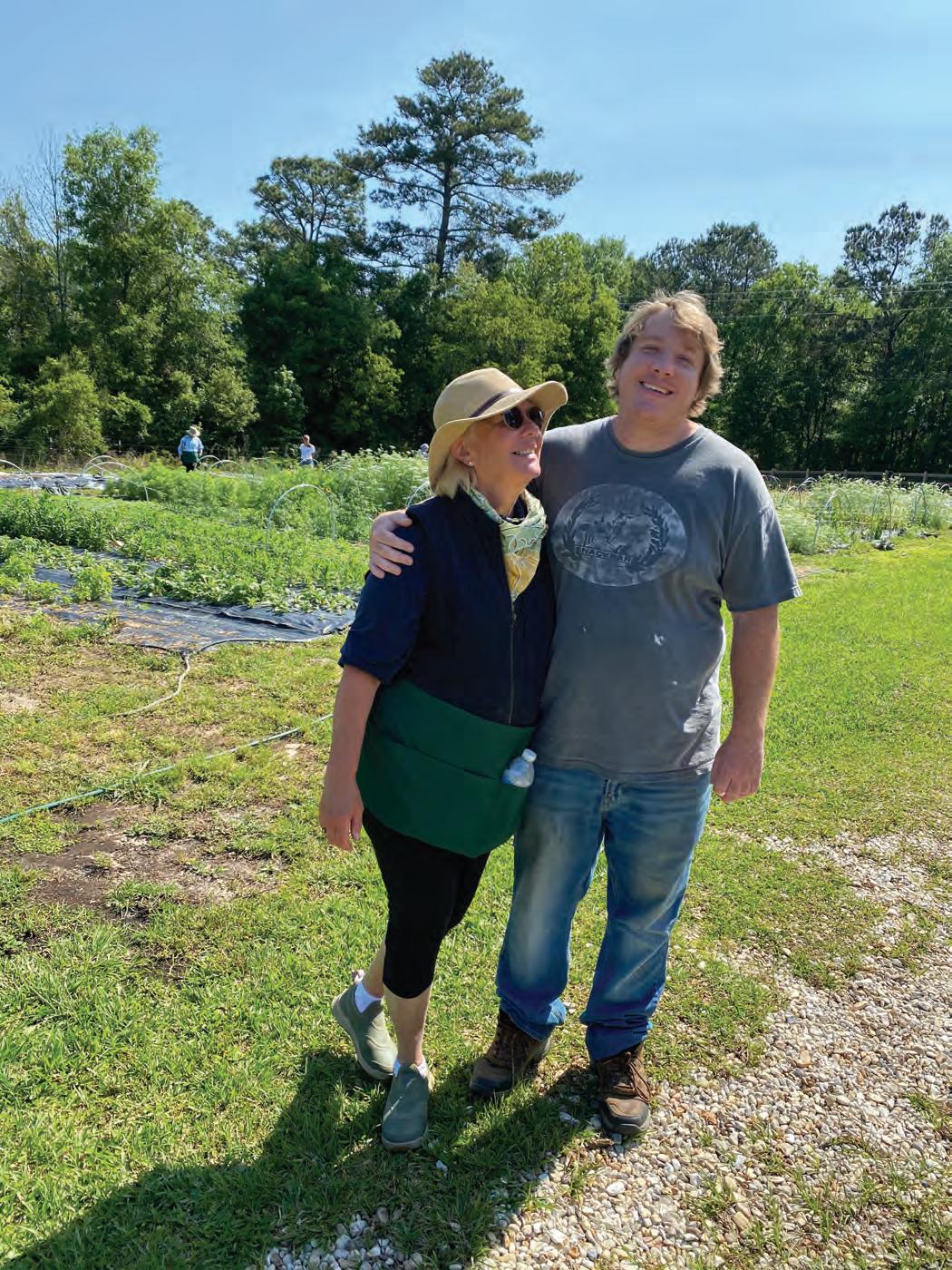

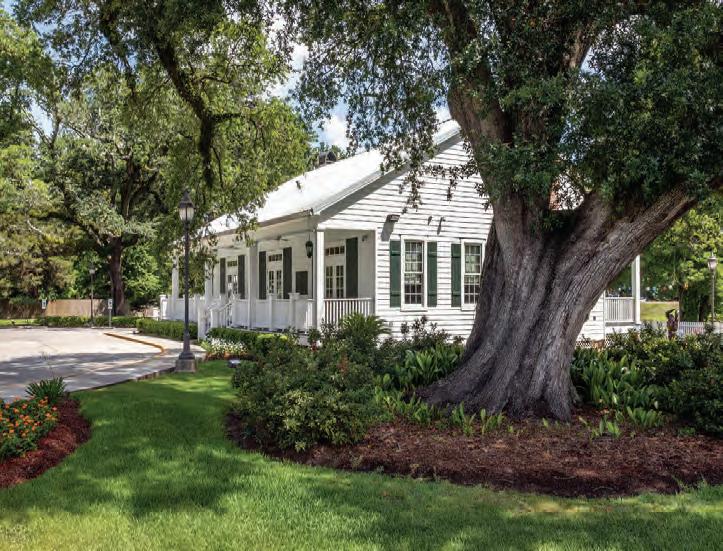
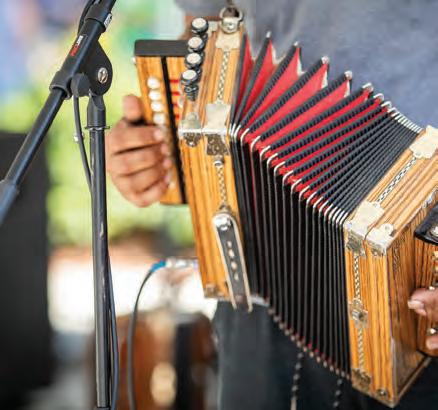


FROM TIKI FARM TO LAB TO TABLE
Story by Beth D'Addono • Photos by Stephanie Tarrant

What happens when an attorney, who is also a flavor-obsessed selftaught cook, teams up with a creative industrial designer with a penchant for power tools?
This is the story of Suis Generis, a quirky forty-seat café in the Bywater neighborhood of New Orleans. Ernie Foundas is the Willy Wonka of this tale, an imagination-fueled co-founder and co-proprietor. His partner is the router queen Adrienne Bell, whose talent for design takes a hard left at tropical aesthetics and all things tiki.
The couple is local to New Orleans; Foundas grew up Uptown and was friends with one of the Brennan kids. “We’d play in the courtyard at Commander’s when Paul Prudhomme was chef,” he recalled. “I was in awe of him. He’d show me things in the kitchen, showed me how to make a roux when I was ten years old.” Although he never acquired formal culinary training, Foundas has worked in restaurants since he was fifteen, first as a dishwasher, then cooking on the line. In college, he worked at the well-regarded Jasper’s in Boston, where the late chef Jasper White gave him a piece of advice. “He told me either to go to culinary school or graduate from col-
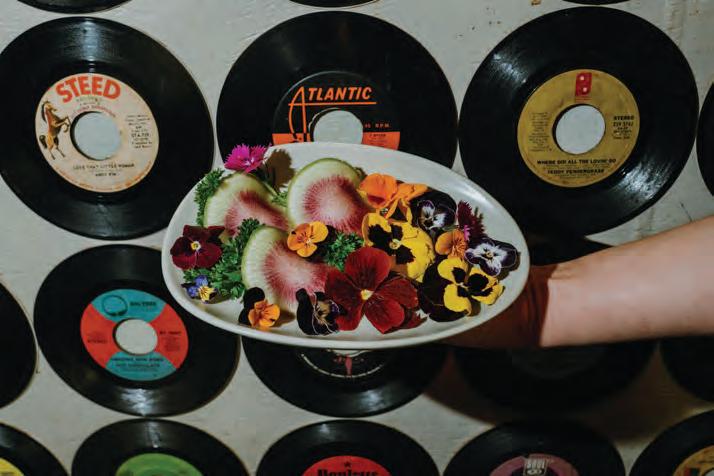

lege and learn more about cooking and the business side of running a restaurant. That’s what I did.”
In 2002, Foundas and Bell bought a building at 3219 Burgundy, intent on rehabbing living spaces upstairs and opening a restaurant on the ground level. Hurricanes, floods, and fire delayed their dream for a decade. The result, hewn from their own hands, finally opened its doors in 2012.
The couple’s vision for the restaurant is well defined by its name, which means “of its own kind” in Latin.
Suis Generis caters to adventurous eaters who don’t like to plan ahead. If you’re in the mood for a steak tonight, there’s no telling if that’s what you’ll find at Suis Generis. The menu changes weekly. It’s never the same, ever.
Each dish is informed, not just by seasonal local produce, but by the very specific harvest of the couple’s four-acre Tiki Farm in Pearlington, Mississippi. Situated along a bayou that flows into the Pearl River, forty-five minutes northeast of New Orleans, the Tiki Farm is host to crops that are largely tropical, inspired by the
couple’s travels and love of the South Pacific. Visit the farm with its mad scientist fermentation Food Lab, and Pee-Wee’s Playhouse comes to mind.
The property is anchored by a 1.5-acre lake, untamed and lovely, home to alligators, frogs, bugs and various water birds. There’s a silver UFO-looking thing made from a renovated oil rig pod, soon to have a second life as an Airbnb; same for a vintage houseboat anchored off a dock by the Food Lab. “We wanted people to have a place to stay after the food experiences,” said Foundas, an erudite science nerd with an endless interest in the natural world.
There is a greenhouse full of fruiting plants like mango, starfruit, jackfruit, bananas, dragon fruit, turmeric, red African peach, and papaya. Smaller yurts and raised beds set the stage for herbs, edible flowers, and micro greens. A raised “Chapel of Tiki”—sounds so much better than shed—houses mowing equipment and other tools.
There’s a beehive in one corner of the property, a rack of kayaks in another. The outhouse is textured with reeds and thatching. All the plants are labeled, in what can only be Foundas’s own bold script.
Mad Scientist at Work
Alchemy comes in many forms. Foundas and Bell opened the Food Lab in 2023, the original idea being to offer cooking classes and chef’s tasting menus in a cozy, intimate second floor setting overlooking the lake.
In the process, Foundas developed a fascination with fermentation—though, not just the kind that turns apples into wine. He’s brewing everything from mushrooms to foraged duckweed, creating umami rich elixirs like kosho, fish sauce, and miso. Like a mad scientist with his bubbling beakers and test tubes, Foundas has amassed an impressive number of glass bottles, each labeled in his hand with the date the aging process began.
He's good at it, too. In fact, he is a presenter at this year’s Kogicon, a collaboration of international fermenters happening virtually from February 17–March 2.

“We grow koji and make miso, soy sauce, gochugang, vegan cheeses, wine, and vine gar from scratch,” he said. He and Bell also educate people on microbe and probiotic rich foods that are good for the body and promote brain health.
The curious can take advantage of this through classes on how to ferment the funk in their own kitchens. There’s one March 15 on how to make kosho, “the magical condi ment,” that includes a six-course tasting menu for $100. On May 17, it’s “The Invasive Spe cies Menu: Eat the Invaders!”—featuring eight courses incorporating plants like chick weed and dandelion, for $125. And on June 21, Foundas and Bell will offer, “The Smells of Extinction,”—a six-course menu based on re-created scents of extinct species, for $125.

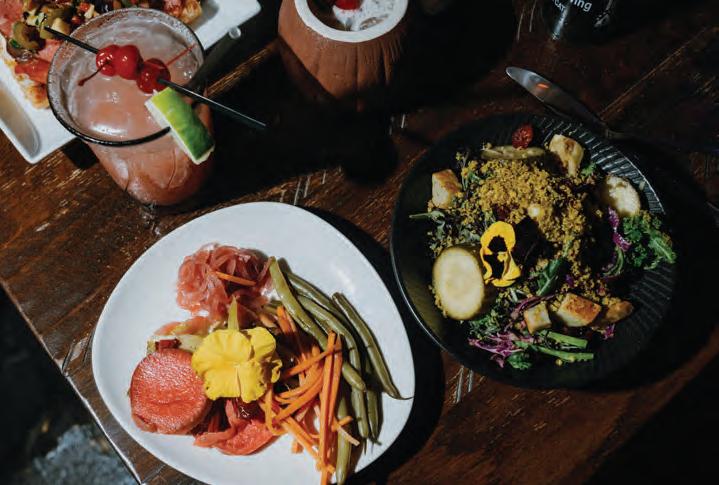
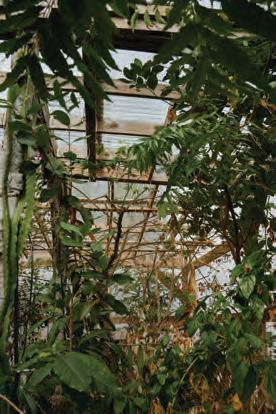


When visiting the Tiki Lab, guests are, on occasion, treated to live performances by local New Orleans band Pink Teddy Bear, who perform original songs matched to each of Foundas’s specialty menu items as he prepares them.
Pink Teddy Bear was the first band to record on Foundas’s record label, also called Suis Generis—which he created in 2023 in collaboration with Pink Teddy Bear bandmember Carlos Grasso. Grasso, who art directed music videos for bands like R.E.M. in a past life, collected field recordings from the Tiki Farm, capturing the sounds of bugs, frogs, and alligators along with the sizzle of food in a pan and the syncopation of chopping on a cutting board. Then he matched the farm’s soundscape with grooves performed by the band.
The resulting album, Welcome to the Tiki Farm (available on Bandcamp and suisgenerismusic.com,) is inspired by classic exotica of the 1950s and 60s, Latin/African/Arabic/Indian grooves, hip-hop, electronic music, film scores, sci-fi, and the pure rhythms of nature. “Music and food are so intertwined in New Orleans, matching the two seems to make sense. I didn’t just want an experimental soundscape,” said Grasso. “There is rhythm in animal sounds, a tempo in nature that communicates. The idea is to use nature as a collaborator in making actual music.”
What Foundas and Bell raise, ferment, and coax into life on the Tiki Farm directly informs the Suis Generis menu from week to week, which they develop with assistance from co-chefs Matthew Erickson and Chris DeBarr, familiar to fans of the long-lamented Green Goddess in the French Quarter.
Dinner, served from Friday through Sunday evenings,
unfolds in a cozy space, with its red solo cup ceiling, retro electric log fireplaces, funky art and, of course, a tiki bar. Divided into smaller dishes, large plates, and happy endings, the menu is not for the plain of palate. The descriptions are epic, long and detailed with a lot of ingredients. On the night I visited, the farmer's salad was made with Tiki field greens, mesclun greens, warm mirliton, rutabaga, parsnip and beet hash, dried apricots, white pepper almonds, and Vidalia onion, all tossed in golden Moroccan dressing. Buffalo milk burrata was served with charred shishito peppers, pumpkin brioche French toast, Tiki bee honey, and artichoke baba ganoush. A perky pickle plate serves a changing array of pickled veggies. And the main course might be garlic-injected lamb T-bones, quick seared ahi tuna, or king trumpet mushroom “scallops”—just one example of the regular vegan offerings. Dessert always includes housemade ice cream flavored with exotics like coconut, ginger, and macadamia. Prices are typical, with starters in the $10–$18 range and mains in low $20s to high $30s.
The Suis Generis kitchen is committed to creating zero waste, with every speck of food either consumed, used as a building block for another dish, fermented, pickled, or composted to make nutrient dense soil. “By fully committing to a changing menu, the ingredients we have dictate what we offer every week,” said Foundas. “I see it as food evolution.”
Suis Generis has certainly evolved since it opened thirteen years ago. Its owners remain intent on experimenting with flavor science and a grab bag of creative projects conceived squarely outside the box. As Foundas likes to say, ‘We’re the only restaurant in the world with a Food Lab, Tiki Farm, and record label.” He speaks the truth. • suisgeneris.com tikifoodlab.com.
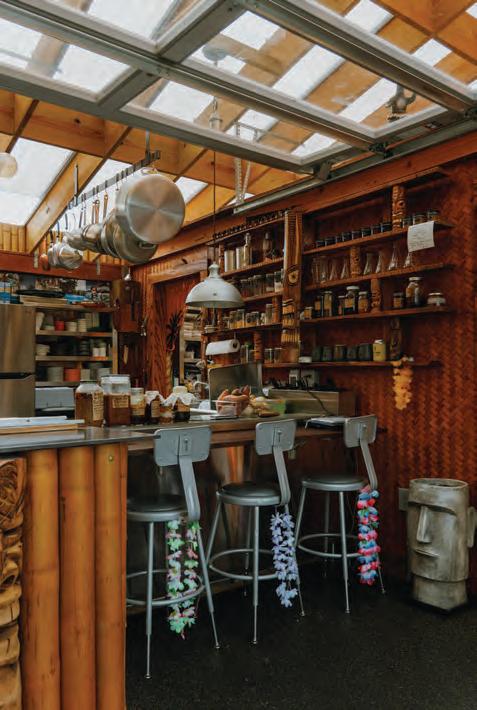
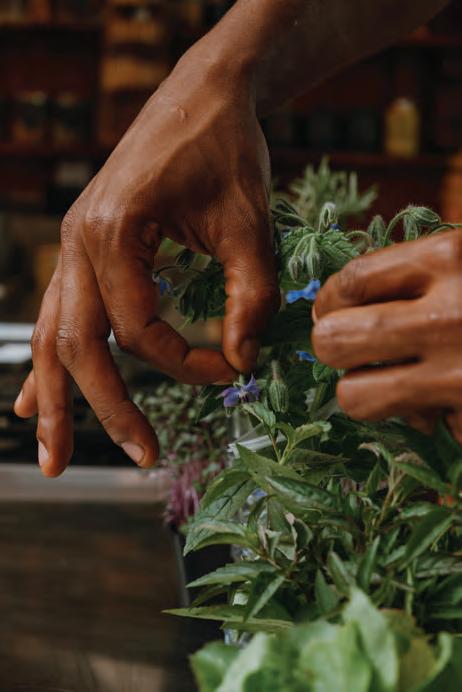

FOR OVER 20 YEARS, homeowners have turned to Window World for durable, high-quality windows, doors, and siding that stand the test of time.
And with our NO-INTEREST FINANCING* and a LIFETIME WARRANTY that actually means a lifetime, it’s no wonder we’re the one name everyone calls. Offering the best is more than a job. It’s a calling. So, call today for your free estimate.
*With approved credit. Certain restrictions may apply.
For a free estimate, scan the QR code, call (225) 446-2007, or visit GetWindows.com Se Habla Español. Visit our Showroom: 8405 Airline Hwy. Baton Rouge, LA 70815
By CR Editorial Staff
On a Thursday last month, celebrity chef Guy Fieri brought Flavortown to Baton Rouge for a meet and greet at Total Wine & More in the Siegen Village Shopping Center to promote Santo Spirits, the star’s award-winning tequila brand, which he co-founded with Rock and Roll Hall of Famer Sammy Hagar.

Fans lined up to have their pictures taken with Fieri as he autographed their Santo bottles. The 100% blue Weber agave tequila is carefully crafted in a third-generation Mexican distillery with varieties including Blanco, Reposado, Añejo, and Mezquila—purportedly the world’s first tequila and mezcal blend. Attendees sampled Blanco in the form of melon and berry cocktails while buzzing with excitement. One young foodie, gleefully white-knuckling her bottle, remarked, “I grew up watching Diners, Drive-Ins, and Dives with my mom, so there’s no way I would have missed this.” santospirits.com
A roaster, barista, and a branding walk into a coffee shop
Baton Rouge has a new coffee shop! Located downtown, the space at 227 Florida Street is now home to a collective of sister-businesses—the multimedia studio Digital Knomad, Smoky Bean Roasters, and House Brew, which has been operating as a pop up out of Pelican to Mars in Mid City since the summer. Co-owners Manning Bergeron and Joe Foster’s vision has been to offer high quality, handcrafted espresso drinks made from beans roasted onsite in a space designed to spark creativity and support local small businesses. On that front, in addition to seasonal espresso specials, customers can enjoy pastries from Mid City Bakery and herbal teas from Adornleaf Tea Co. Future plans for the space include a bookstore and darkroom, as well as educational programs around coffee roasting. smokubeanroastingco.com. housebrew.org
Earlier this year, the beloved restaurant at the St. Francisville Inn, The Saint, tragically lost its chef, Jaime Hernandez, to a vehicular accident. Since last April, Chef Hernandez has upheld the Inn’s reputation for comfortable opulence—serving seasonal, ingredient-driven recipes inspired by his Isleño Creole heritage and built upon a commitment to supporting local growers and suppliers. As expressed by the Inn and the entire St. Francisville community, he is already dearly missed.
In his stead, The Saint’s former chef Michael Dardenne—who during his tenure earned the restaurant recognition as one of the Top 100 Restaurants in America by OpenTable, twice—has officially returned to the Inn. A Baton Rouge native who has built up a resume cooking in Baltimore, Atlanta, New York, and London, he was initially drawn to The Saint for its small town community feel, and many of his dishes became St. Francisville classics during the time he was there. On The St. Francisville Inn’s Instagram Post announcing his return, owners wrote, “His culinary expressions of fine dining meets comfort food create phenomenal dishes that every guest can delight in. We look forward to working with Chef Mike for many years to come.” louisianahospitalitygroup.com

A. A colonoscopy is an outpatient colon cancer screening procedure that is good for detecting both colon cancer and polyps. During your colonoscopy your gastroenterologist will remove any polyps that are found, so that the polyps never have a chance to develop into colon cancer. By detecting and removing polyps, a colonoscopy can prevent colon cancer. Because of this, a colonoscopy is considered the gold standard test for colon cancer screening.





LUKE WAGNER'S SMALL-SCALE
Story by Jacqueline DeRobertis-Braun • Photos by Molly McNeal
Tho my daughters, my mother is “Honey”—a moniker evoking something simple and sweet. First a plaintive “On-yay” mustered by my eldest, and later a squealing “Honey!” on sight, the name oozes affection, doting attention, and easy comfort.
It is only fitting that my mother, who wears the title well, first discovered the honey house. She found the little wooden box in that endless sunshine time after becoming a new
grandparent, but before the magic of small, unexpected childhood surprises could fade. Often, she would push my daughter in her stroller down the road to the neighborhood park, pointing out trees and trucks along the way.
It was on a day like this that the honey house appeared at the corner of a dead-end street several houses away, whimsically painted with a cheerful yellow-gold honeycomb. Beside it, a sign boldly proclaimed “HONEY FOR SALE” in large, capital letters,

with a smaller “self service” addendum at the bottom. After opening a glass door, customers can help themselves to bottles of organic honey in two different sizes, along with honey and oatmeal milk soap. It was a treat that far surpassed the wonder of trees and trucks.
The honey house is one of six across the greater Baton Rouge area and the brainchild of 29-year-old Luke Wagner, founder of Bindi’s Bees Apiary. As Wagner tells it, beekeeping became an

unexpected hobby, later snowballing into a small business, after one hive purchased for his garden-loving father’s Christmas gift in 2019 turned into three, then twenty—and eventually, eighty-five.
Wagner didn’t initially intend to take over his father’s hive and dive head-first into the world of beekeeping, but researching the gift early on piqued his interest and sparked an unexpected passion.
“I was like, ‘Oh, man, this is really cool,’” he said. “Learning about nature and learning about how bees work. And the more you learn about bees, the more you realize that they are very intelligent creatures.”
Wagner knew from the start he didn’t want to purchase bees from a supplier, but rather draw the bees to a hive himself. So how does one tame
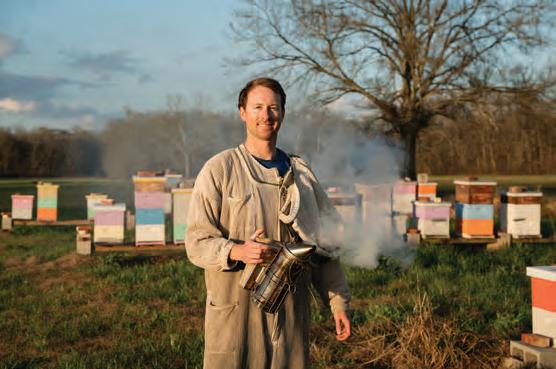

wild bees and entice them to make a new home? He learned that around the second week of March, in the Baton Rouge and Lafayette areas, bees begin to procreate, swarming as half the hive leaves with the old queen to find a new dwelling.
Setting out wooden boxes containing a little honey, Wagner was able to coax those bees scouting for a new home inside, where they settled down to make a new hive. Now, he places around twenty boxes in different locations on his properties, catching one to two swarms in each box annually.
What began as a labor of love (and fascination) naturally grew into a small business when Wagner found himself positively inundated with excess honey. And Wagner has something that he believes elevates his product—a commitment to keeping his bees and honey all-natural, avoiding the chemicals and oils some apiarists use to protect their colonies from pests. Instead, he works to keep his hives healthy and his bees strong enough to withstand pest invasions.
“I don't feed them with sugar water or anything like that,” he added. “Whatever they have, they got themselves. So everything's from nature.”
With an “organic” label, and a catchy, alliterative name (“Bindi” is the name of his Australian Cattle Dog who has romped along beside him to catch swarms and check hives over the
years), the honey just needed a home. Cue the honey houses. Wagner knew what he wanted and hired a woodworker to create something “oldschool,” commissioning his cousin, Danielle Blanchard, to paint the boxes with playful images of honeycombs and bees.
Working full-time in marketing by day, Wagner has learned about beekeeping without any formal training, instead finding information on his own by watching YouTube videos and attending Capital Area Beekeepers' Association meetings. After several years of beekeeping, he has become the goto in the association when someone wants to start a hive themselves.
“You just absorb it over time when you're in the beekeeping community,” Wagner said of the wealth of information on running an apiary. “When you're in it, you're in it.”
His eighty-five hives are spread across three locations: about half are off South Harrell’s Ferry Road and Jones Creek Road, the other half on River Road, and a few in his own backyard in the Bluebonnet area. Last year, Wagner harvested about thirty-five pounds of honey per colony— and this year, he expects to double his production.
Harvest usually commences the first week of July, around the Independence Day holiday weekend. “I do it then be-
cause it's at the end of the big honey flow,” Wagner explained. Honey flow, also known as nectar flow, is a period of time (usually in the warmer months) when plants release an abundance of nectar—ideal for bees to collect for honey-making.
“The Chinese tallow flow goes from about mid-May through June, and that's when we're really packing in the honey,” he added. Mid-April through the first week of May is when the ligustrum blooms for a smaller collection, while the flow from goldenrod and fall asters is harvested in October. “[There’s] a whole bunch of other things blooming. It’s just these are the main nectar producers.”
Wagner’s is largely a solo operation, save when it’s time to harvest the honey in that first week of July. Luckily, the date falls near Wagner’s birthday, meaning he can harness the goodwill of friends and family for a honey-processing party. Usually around six people come with him to pull the honey, taking it off the colonies, while four people work as extractors. Wagner estimates it takes about two eight-hour days. “There’s a lot of free tastings if you come and help,” he quipped.
Besides the honey houses, Bindi’s Bees products can be purchased at various brick-and-mortar locations, including Goodwood Hardware, Red Stick Pharmacy on Old Jefferson, and a few other locations. Wagner also said
he is willing to ship honey to interested purchasers, who can contact him through the company’s Facebook page. At this point, he’s not sure if he will expand his business to a full-time operation; close to one hundred hives is a lot to keep up with, and he isn’t sure if he could handle more. In the meantime, he’s spending his days “test-driving” a honey chapstick.
“We’re all connected. Giving back to nature is just my part of the puzzle,” Wagner said. “I feel like as organisms, we take a lot, you know. If there’s something we can give back, I’d love to be a part of that.”
As for my mother, a small pot of Bindi’s Bees honey lives on her counter, and has remained (regularly replenished from the neighborhood honey house) for the last couple of years—a mascot of sorts. When she visits, my daughter scampers across the kitchen for a taste. In her mind, she has never lived in a world without readily available honey, just around the corner. •
Wagner’s honey houses can be found off Jones Creek Road, on Antioch Boulevard through the Shenandoah neighborhood, near Jefferson Terrace Academy, off Kenilworth, in the Oak Hills area, and in Old Jefferson. Keep up with Bindi’s Bees on their Facebook Page.



EIGHT EXOTICS THAT BELONG IN YOUR GARDEN
By Jess Cole
Anyone who knows me knows that I am particularly passionate about native plants—plants that have been in our area for millennia, co-evolving alongside our other species of life, creating hsustainable symbiotic relationships that are crucial to our local ecosystems. Native plants have been altered very little by the hand of man; Native plants are going to support the most life, always. They are the greatest participants in our natural systems.
That being said, I am no purist, and also adore, cultivate, and learn from many non-native species. In fact, one of the most exciting things about gardening in Louisiana is that we can grow such a variety of plants year-round. So many interesting tropicals from Central/South America and Asia thrive here and have helped shape the natural history and landscapes of southern Louisiana.
Recent years have brought several unprecedented weather extremes—from a polar vortex at the end of 2022, with temperatures staying below freezing for forty-eight hours straight; to a summer drought that killed enormous numbers of magnolias in the region; to the blizzard just a few weeks ago, which blanketed our landscapes with the most elegant pure white fathomable. I nerd out on times like these, as I observe my garden and how it responds to these phenomena.
When such bizarre weather extremes hit us, I obsess over seeing who dies, who lives, and who flourishes. And these past few years, I have noted with interest the non-native species that have seemed untouched, trudging along happily alongside our native flora—all the while, not harming or reducing our native ecosystems. The list below comprises exotic plants that I believe have a place in our gardens. I have found each of them to be of great ease and utmost wonder.
Olive, Olea europaea: These trees are outstanding. They are lovely small evergreens native to the arid climates of the Mediterranean and Africa. This fact makes them outstanding in drought. Their petite stature and stout form make them a great tree to keep in a large terracotta pot, adding something special to any porch or courtyard. They also work well as an airy and textured privacy screen lining a fence. For such a drought tolerant plant, my olive is generally unphased by our great rainfall and flooding. Once established, it also does fine through our random hard freezes. My friends over at Suzanne Turner Associates harvest their fruit to cure and consume. Rumour has it that some universities out there are studying the tree for a potential olive oil crop in Louisiana.
Mexican Salvia, Salvia leucantha: I plant and design with this perennial more than any other exotic plant. One of the prettiest and most robust salvias I have ever known, Mexican Salvia returns year after year with vigor and is an absolute hummingbird and bumblebee mag net. This plant thrives in drought and, like the olive, is unphased by our humid climate. Great en masse or standing alone, the plant’s gorgeous giant purple flower spikes bloom from spring to late fall. I cut it back at least once a summer to help it bloom even more. I plant these in gardens that get intense afternoon sun, are surround ed by excess hot cement, or for clients I know will not water well during the establishment phase.
Chaste Tree, Vitex agnus-castus: Another Mediter ranean native, drought-tolerant beauty is the vitex tree, with its prolific purple blooms that carry on for months and attract all sorts of pollinators. It’s a medium-size de ciduous tree that grows incredibly fast and has an inter esting form. Its growth is a bit rigid, with interestingly straight and architectural branching patterns. I have a lot of fun with my vitex trees, capitalizing on the bizarre branching angles and pruning them to almost look like large bonsai of sorts. They do well in a cottage garden, as well as alongside other more arid, drought-tolerant plants with similar muted colors, such as the aforemen tioned olive and salvia. The berries are edible and, when dried, resemble in look and taste, peppercorns.


Creeping Sedum: I inherited this lovely crawling succulent with the cottage I purchased three years ago. Ninety-five-year-old Ms. Peggy had it growing in all of the gardens she created over the past forty years. We changed the gardens completely, never trying to save any of this sedum—but it regrew everywhere. The plant is not invasive, but it seems to offer its services up in just all the right places, such as the edges of paths, and acting as a ground cover and weed suppressant in empty spots of the garden. It grows amongst my perennials in a fun and symbiotic way. I have transplanted it to dozens of clients' homes, and I grow it in my hanging baskets. The sedum handles filtered shade to full sun. It seemingly never has to be watered, yet is fine with however much rain it receives. No cold snap seems to affect it.


Chocolate Plant, Pseuderanthemum alatum: This wild perennial native to Mexico and Central America has spotted brown, shiny leaves with deep purple blooms—a rare color combo assuredly. It can grow in almost full shade and reseeds beautifully, making almost a ground cover of sorts. It’s dainty, bizarre, and quite whimsical. My plant mentor, Lindsey, grows it in her shady back yard alongside other magical shade-loving perennials such as ajuga, jewels of opar, and varieties of begonia. She gave me a small bucketful a decade ago that I have spawned thousands from. It’s one of those weird plants I feel compelled to give away constantly and plant in every shady spot.
Pineapple Guava, Acca sellowiana: This is perhaps my favorite non-native fruit tree. A small and fast-growing evergreen with silvery foliage, its fruits make the perfect tiny tropical snack. Neither drought nor deluge seem to negatively affect the guava. She loves sun and, especially when pruned lovingly, grows into the most elegant branching form that makes her a focal point in the edible or permaculture garden.

Night Blooming Cereus, Epiphyllum oxypetalum: The Queen of the Night! This sprawling cactus is just pure delight and magic and one of those plants that brings people together. If you are a gardener, you almost assuredly have given or received a broken off piece somewhere along the way. Just stick the cutting in some dirt or water, and it always roots. As the name implies, epic blooms open boldly as the sun sets, then fade away in the new morning. The blooms are somewhat rare, making it that much more special. Hawk moths drink from and pollinate these flowers, an epic sight to behold. Nightblooming cereus prefers a bit more shade but surprises me often in full sun. Protect them from freezing temps. I love to fill pots and hanging baskets on my porch with the cuttings I am gifted. They grow fast and are very drought-tolerant, making them a lovely choice for a container.
Angels Trumpet, Brugmansia sauveolens: I’ve saved the best for last—Angels Trumpet is technically a small tree, but depending on where you are in the


state, the tale changes. You will find it in tree form in New Orleans and warm corners of Baton Rouge. In St. Francisville, it expresses a more perennial nature, returning from the earth each year. To me, this plant is of divine order; it is so very special to southern Louisiana and the old gardens we have cultivated here. You can often find one of these planted generations ago on old properties. Almost every Louisianan I know has a childhood memory made of banana plants and angel trumpet trees. They are another joy to bring you outside at night when their giant, sweet trumpet flowers burst open to entice large moths and bats to visit. The pollinator commotion surrounding the angel's trumpet is a show in and of itself. •
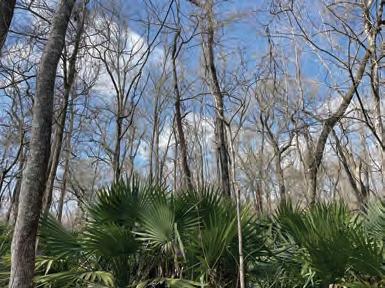
There is perhaps no greater example of flora in all of southern Louisiana. The dwarf palmetto lines our swamps, roads, and our hearts. This medium-sized shrub belongs in every garden as far as I see it, adding excellent texture and accent. Beautiful as a single specimen or en masse, this plant is evergreen, a fast grower, and can handle full sun to full shade, making it an excellent structural plant for any garden. Though it is known as a swamp dweller and characteristic of floodplains, once established it is excellent in dry times as well. I like to capitalize on the plant’s long root system to help stabilize eroding hills or areas that get washed away in floods. Wildlife depend on it for nectar, fruit, protection, and building materials, and Louisiana’s native peoples used the fronds to cover their homes and make baskets.

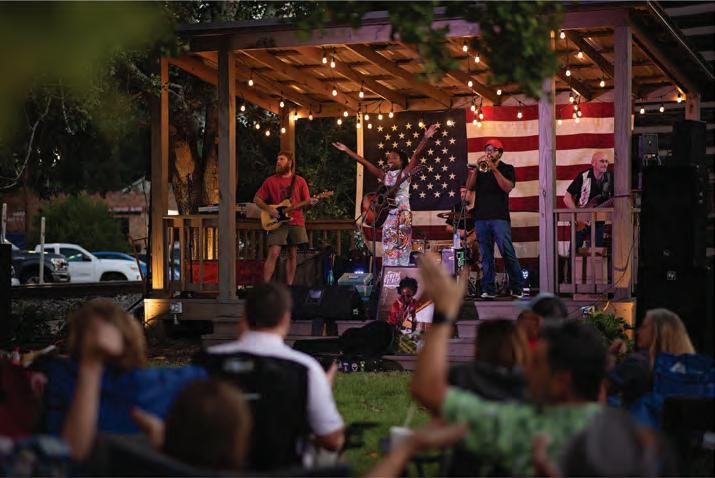
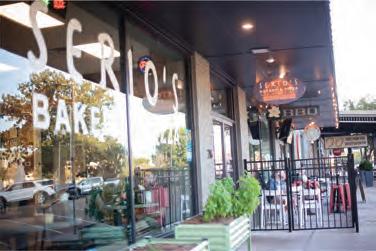





Thhe monarch butterfly has long been an object of wonder. Its dramatically contrasting orange, black, and white aggressively capture the eye, possessing the mystery of starting life as one creature and morphing into another. And then, there is the improbable specificity that dictates this insect’s little life—from what it eats, to where it flies, to where it dies.
The typical migration of monarchs is a multi-generational journey that, for the Central Mexican population (part of the Eastern population of monarchs, as opposed to the Western, which overwinters along the California coast), begins high in the oyamel fir forests of Mexico’s Sierra Madre mountains. Millions of monarchs spend their winters in these high forests between 7,875 and 11,800 feet. The wetness of the forest provides much needed moisture to aid their survival. Cooler temperatures allow them to slow their metabolism and conserve fat reserves as they gather together for warmth and protection.
When spring approaches, the hibernating monarchs awaken and begin their search for a mate. Then, they start their journey north and east, typically mid-March. Females will lay their eggs on milkweed plants along the Southern Gulf Coast of the United States, producing the first generation of the wintering Mexico monarchs.
After about four days, the caterpillar will hatch, ingesting its egg casing before devouring more milkweed leaves than you can imagine. At about two weeks old, the caterpillar will find a place to attach itself, hanging in a J formation, ready to form a chrysalis and begin the process of metamorphosis.
From the outside, it looks like nothing is happening. However, over the next ten to fourteen days, new tissue growth is being nourished by a specialized set of cells. The brain, the heart, and digestive tract form; flight muscles and com-
pound eyes develop, legs grow long, and sturdy wings emerge. When the bright green chrysalis turns black, it means the monarch is about to emerge. Long legs hang onto the shell of the chrysalis as the new insect pumps its wings, causing them to expand. The wings must dry before the butterfly is able to fly.
After feeding on flowers, the monarchs will mate and move further north, where females will lay eggs on a new patch of milkweed. This first-generation monarch will only live two to six weeks, dying after laying its eggs. Males typically die shortly after mating.
The cycle continues, traveling and birthing and being born and traveling yet some more, until the final generation reaches the Northern U.S. and Southern Canada; this can sometimes take five generations. The last spawns a super butterfly, which will live up to eight times longer than its mother, grandmother, great-grandmother, or greatgreat-grandmother. If all goes according to plan, the super butterfly will fly all the way from wherever it emerged to the Mexican oyamel forests to overwinter. When he/she makes this long trek, they enter a physiological state known as diapause. Their reproductive organs do not develop until after the next winter, making them lighter and more efficient fliers for their long journey.
For years, scientists have warned about the alarming decline of the monarch butterfly—whose population in North America has decreased more than eighty percent since the 1990s. This loss has many causes, but the most prominent are habitat loss caused by increased logging and development, and the loss of milkweed breeding grounds.
As recently as December 10, 2024, the United States Fish and Wildlife Service announced a proposal to list monarchs as threatened under the Endangered Species Act, with species-specific protections such as prohibiting anyone

from killing or transporting the monarch and protecting properties with milkweed. (The public comment period for the proposal ends on March 12.)
The battle cry has long been “Save the Monarchs! Plant Milkweed!” And many people, captivated by these fascinating creatures, have answered the call.
The problem, according to ongoing research, is that people are planting the wrong species of milkweed.
The milkweed most available at local nurseries, known as tropical milkweed (Asclepias curassavica), is native to the Caribbean—attractive because it can easily survive our region’s mild winters, flowering and leafing year-round.
However, unbeknownst to most monarch-lovers, tropical milkweed is more likely than natives to harbor a parasite called OE (ophryocystis elektroscirrha), which can be deadly for monarchs.
If, when a female monarch lays her eggs on a milkweed plant, she or the plant is infected, the disease will be passed along to her offspring as they hungrily munch away on the leaves. Infected butterflies may be too weak to emerge from their chrysalides, or may make it out deformed or with crumpled wings, unable to fly.
In some cases, the monarchs might look normal but not be healthy enough to live long or survive migration. If, by chance, the new butterfly survives and can fly, it will be infected and will pass along the parasite spores to mates and other milkweed plants it lands on. This is a vicious cycle with devastating impacts to the population. The OE spores can only be detected with a microscope, making it more difficult for conservationists to target and fight.
According to Dr. Andy Davis, Research Scientist with the Odum School of Ecology, University of Georgia, who has studied monarchs for twenty-five years, OE can be found on native milkweed as well as the tropical species, but
remains on non-natives longer, allowing the spores to accumulate. “But in areas of extreme OE prevalence,” he said, “there is OE on every milkweed on the landscape.”
A major hotspot, and an alarming interruption in the monarch migratory cycle, is the Gulf Coast. Thanks to the citizen science program, Project Monarch Health, run by the University of Georgia, we know that destinations along the Gulf Coast are experiencing extremely high rates of OE-infected milkweed. In parts of New Orleans, OE prevalence rates have been found in 100% of samples tested.
In addition, because tropical milkweed doesn’t always die out at the same time that native milkweed would, the monarch’s migratory and reproductive rhythms can be affected.
“There’s a real fear in the scientific community that these non-native milkweeds, especially in the southeast, are basically telling the monarchs not to migrate,” said Davis. “People are planting non-native milkweed thinking that they are helping. This results in the monarch laying eggs in their non-breeding season when they should be migrating to Mexico.”
Dr. Davis recommends that residents of the Gulf Coast avoid planting any milkweed, especially the tropical milkweed, to help lower the high OE infection rate. He also discourages people from raising monarchs in captivity. “Basically, you are rearing infected monarchs, releasing them into the wild to contaminate more milkweed,” he said.
Dr. Davis recommends, instead of milkweed, that people grow nectaring plants to provide fuel for the monarch’s long, arduous flights, encouraging them to continue to migrate, while preventing yards from becoming infection hotspots.
Right now, “Monarchs just need humans to let them do this on their own,” said Dr. Davis. •











46 THE HISTORY OF LSU'S SHIRLEY C. TUCKER HERBARIUM // 48 THE LOST BLUE OF LOUISIANA // 52 REMEMBERING ACADIANA'S "PEPPER SAUCE" BASEBALL LEAGUE MARCH 2025
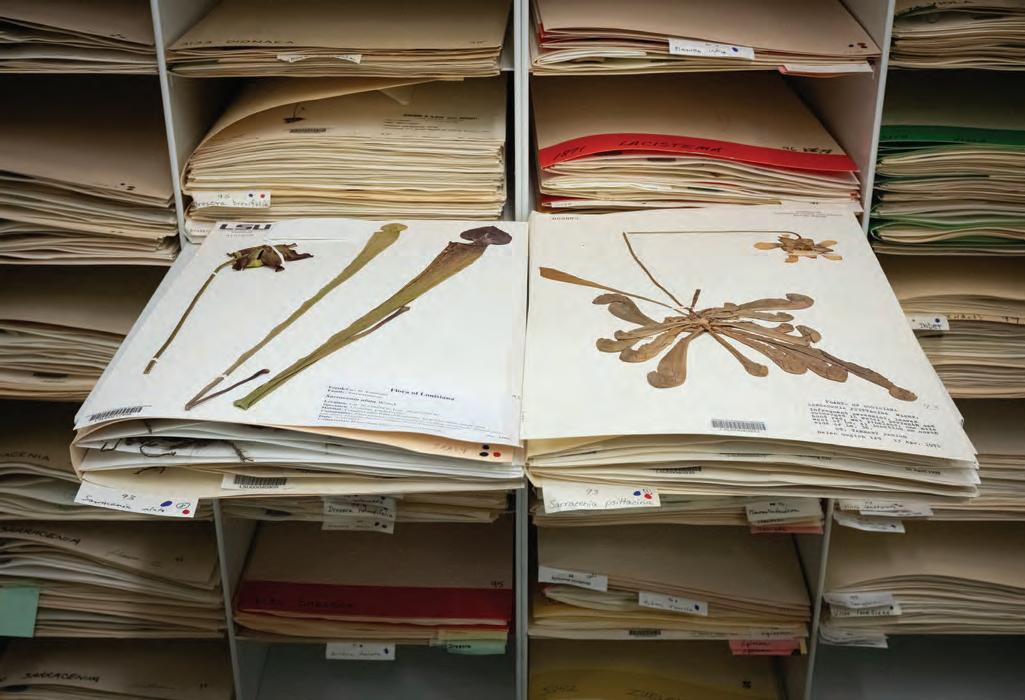
INSIDE THE SHIRLEY C. TUCKER HERBARIUM, THE LARGEST
COLLECTION OF PLANTS AND FUNGI SPECIMENS IN LOUISIANA
Story by Ed Cullen • Photos by Molly McNeal
In the annals of LSU’s Shirley C. Tucker Herbarium, there is this story: On October 15, 1869, fire licked the walls of the seminary building on LSU’s original campus in Pineville. Americus Featherman, a professor of languages and the university’s first botany instructor, rushed out of the burning building—“his arms full of wildflowers.”
Two weeks later, the Louisiana State Seminary of Learning and Military Academy began the move to Baton Rouge.
Building the LSU Herbarium Collection
Featherman had founded LSU’s first herbarium the same year as the fire, and in the years to come he built up a collection of specimens documenting plant life in Louisiana in the post-Civil War years.
The first long term director of the LSU Herbarium was the renowned botanist Clair Brown, whose Wildflowers of Louisiana and Adjoining States remains a popular guidebook more than fifty years since its publication by Louisiana State University Press. Brown himself contributed over 8,000 specimens to the herbarium, which at the time was housed on the third floor of the Life Sciences building in a 400-square-foot room.
Under the direction of Lowell Urbatsch, an Iowa native who came to LSU in 1975 by way of the University of Texas with a specialty in plant taxonomy, flora of the region, and grasses, the collection grew in size from 40,000 specimens to almost 200,000. This sudden growth required a move in 2001 to a 6,000 square foot space in the new Life Sciences Annex to accommodate the growing collection, and allow space for future growth.
In 2016, the LSU Herbarium absorbed the Tulane University Herbarium and its

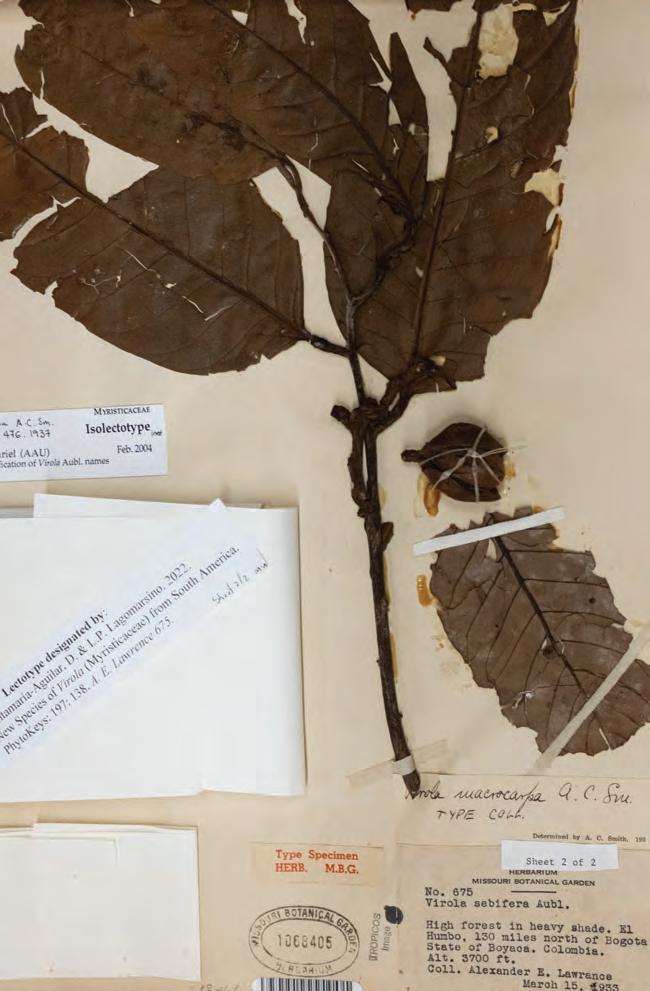
holdings, which included nineteenth century specimens collected by botanists like Josiah Hale, William Marbury Carpenter, and John Leonard Ridell.
The LSU Herbarium Today
Today, under current Director Laura Lagomarsino, the Shirley C. Tucker Herbarium remains on the second floor of the Life Sciences Annex and is home to more than 380,000 specimens—making it the largest collection of plants and fungi in Louisiana. One of the oldest specimens can be traced back to the voyages of Captain James Cook in the 1700s. Carl Linneaus, the eighteenth century Father of Taxonomy, would smile at the similarities between his cabinet cataloging system and the specimen cabinets at the Tucker.
Lagomarsino credits Urbatsch—who, though now retired, still makes near daily visits to study plant specimens—with demonstrating to the university the importance of an herbarium. “There was no kickback when he said his replacement should be a faculty member trained in botany,” she said. Lagomarsino has a Bachelor of Science in genetics and plant biology from UC Berkeley and a doctorate in organismic and evolutionary biology from Harvard University. As Director of the Herbarium and an Assistant Professor at the University, Lagomarsino’s duties consist of teaching, researching tropical plants, supervising the collections manager, pursuing grants, and advocating for the herbarium.
While most research conducted at The Shirley C. Tucker Herbarium is pure science with no commercial implications—“knowledge generation for the sake of knowledge generation and student training,” as Lagomarsino puts it—the work done here also lays the foundation for drug discovery, according to Jennifer Kluse, Collections Manager. The researchers at the herbarium have recently supported LSU faculty
research on anti-cancer properties of native plants.
The DNA of preserved plants in the LSU collection, sometimes called “vouchers,” can provide precise comparisons when it comes to identifying new plants and their properties, Lagomarsino said.
In an effort to continue expanding the collection, herbarium botanists, students, and LSU scientists in related fields make an annual specimen collecting trip to locations in Louisiana and Texas, in addition to collecting excursions to places like Costa Rico, Peru, Columbia, and Australia.
The LSU Herbarium is named for former LSU Boyd Professor Emerita Shirley C. Tucker, now ninety-seven and living in Santa Barbara, who rose from a lecturer at LSU to one of the first women to receive the university’s highest faculty ranking. In addition, her personal lichen and bryophyte herbarium is one of the largest of its kind in the southeastern United States. In 2015, Tucker gave $2 million to the LSU Herbarium and plant systematics program in the College of Science’s Department of Biological Sciences. With an almost $1 million supplement from the Louisiana Board of Regents, Tucker’s donation supports the herbarium, a chair in plant systematics in her name, and graduate student scholarships.
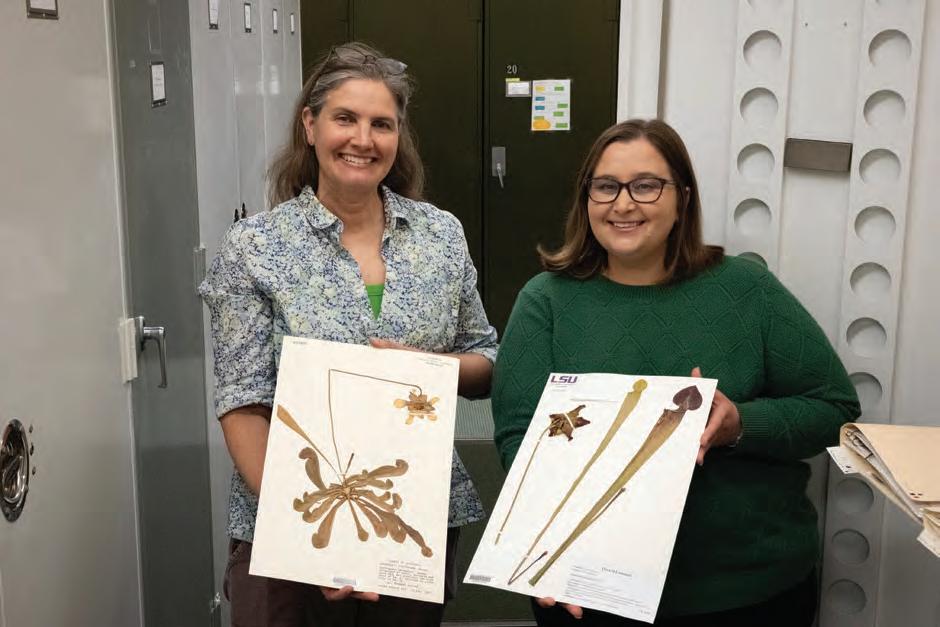
Since her donation a decade ago, the herbarium has continued to build its collections and garner support. In 2022, the Shirley C. Tucker Herbarium’s holdings were entirely digitized—providing a data record of every single specimen in its massive collection.
For more information or to schedule a tour of the Shirley C. Tucker Herbarium, visit lsu.edu/herbarium.
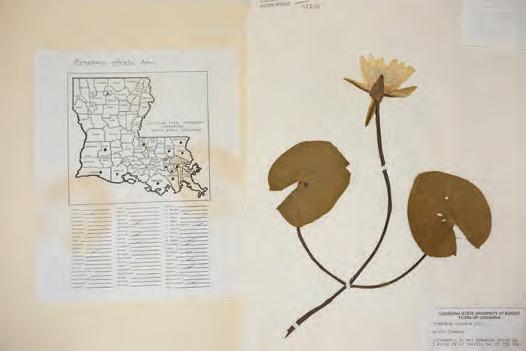





Story by Jordan LaHaye Fontenot


In a legend that has been passed down within the Canneci Tinne Apache Tribe (formerly known as hthe Coco Tribe of Canneci Tinne), a coyote steals a white dress, only to find himself dragging it through a series of mishaps into salty, ashy water. When he emerges, though, he discovers that the dress is a brilliant blue.
The Canneci word for “blue” is tatxe On the tribe’s medicine wheel, tatxe represents the South. This holds significance for the Canneci, who are the easternmost descendants of the Lipan Apache Nation—residing since the early eighteenth century in the South, in the Prairie Marronne and Bayou Tortue areas around St. Martin and Lafayette Parishes.
“Blue for us is a southern color,” said Nant’a (Chief) Kugr Goodbear. “And it

represents water”—which the Canneci historically relied upon in South Louisiana as a source of nourishment and transportation. To this day, tatxe is worn on traditional garments as an homage to the region the tribe calls home.
The Canneci is not the only native tribe in the surrounding region to incorporate the color blue into its textiles—the Tunica-Biloxi and the Choctaw both also hold the color as part of their traditions. Before the rise of synthetic dyes in the late nineteenth century, blues would have had to be sourced from plants—most commonly: indigo.
And before the Europeans arrived with their ships loaded down with Indigofera tinctoria seeds from Asia, ready to tear open Louisiana’s prairies to make room for plantations, Indigenous people had
developed traditions and processes using native “false” or “wild” indigos (of the genus Baptisia) as well as one species of "true" indigo, Indigofera suffruiticosa
This knowledge, combined with that of African artisans forcibly brought here from across the world, would ultimately be exploited by the European planters, who would build fortunes on their backs.
Indigo has its place in Cajun history, too. When the Acadians arrived in this strange new land, they brought with them skills in textile-making. Here, instead of wool, they had cotton. And unlike wool, cotton didn’t absorb the colors of most plant-based dyes without a mordant. The only dye they could get to
stick was blue, from indigo. For this reason, most traditional Cajun textiles held only three colors—brown, coton jaune; white, from cotton; and blue, from indigo.
In most accountings of Louisiana history, indigo is relegated to a brief chapter in the legacy of the plantation era, which ultimately yielded to the more notorious cotton and sugarcane industries. But the plant, and its distinctive blue, grows at the intersection of this region’s ecological history, its Indigenous history, colonial history, and the history of the African diaspora via the transatlantic slave trade. It grew, wild and plentiful, in the unplowed, unpoisoned prairies; colored the textiles and stained the hands of the people who lived here long before Europe discovered the Americas. The global desire for blue is the very thing that launched Louisiana’s plantations; the work of processing it created the demand for free labor, and the lore of the skilled dye masters in West Africa was part of what brought the slave traders to those shores.
Today, growing concerns about the health and ecological effects of synthetics have spurred a renewed appreciation for nontoxic plantbased dyes across the globe, with indigo once again at the forefront. This revival—undertaken by artisans, farmers, and designers— sparked in the Carolinas, where the indigo industry was most prominent in North America. But over the course of the last year, a collective interest in the plant, and its dye, has also taken hold closer to home in Acadiana, where scientists, artists, and historians are recalling Louisiana’s particular relationship with le bleu perdu.
It all started with a collaboration between LSU biologist Benjamin Dubansky, Ph.D. and curators at the Mingei International Museum in San Diego, who were putting together the exhibition Blue Gold: The Art and Science of Indigo, currently on display through March 16, 2025. The show is part of PST ART, a Getty initiative that facilitates program activations at museums and institutions across California exploring, this year, the intersections of art and science. For their expertise in integrating the two
disciplines, the National Academies of Sciences invited Dubansky and longtime collaborator Brandon Ballengée, Ph.D., an artist and biologist working out of Arnaudville, to act as consultants on PST 2024.
Fascinated by the prospect of the Mingei’s exhibition, Dubansky set out to bring indigo into his lab at LSU, where he and his wife Brooke Dubansky, Ph.D.—an award winning histologist—researched eighteenth century procedures used to dye cells for visualization under microscopes. Before it was replaced by cheaper synthetic alternatives, indigo was one of the most popular dyes used as a stain. Though this process was practiced for about a century, the stains themselves—preceding the advent of color photography—have been lost to history.
Together, the Dubanskys wanted to replicate the process, from dye extraction to tissue staining, and create high resolution photographs of the resulting microscopic slides to contribute to Blue Gold.
Dubansky saw an opportunity to draw in an ecological and cultural layer to his project and reached out to Ballengée who, for the past six years, has been renaturing Cajun prairie habitat with his wife Aurore at their nature reserve in Arnaudville, Atelier de la Nature. The Dubanksys would recreate lost technology of indigo; the Ballengées would reclaim the lost landscape. In the springs of 2023 and 2024, the Ballengées hosted public prairie plantings at the Atelier—planting native wild indigo (Baptisia) seeds, as well as native “Guatemalan” indigo (I. suff ruticosa), along with a host of other native plants. Together, the scientists harvested the leaves, extracted the dye, and the Dubanskys used these Louisiana indigos (supplemented by some purchased natural indigo—"The yield is very very low, and the process is labor intensive. This is why the industry required slave labor," said Ben) to create their slides.
But then, they found themselves pushing further, consulting local experts in fields ranging from textile arts to colonial history. “It’s so multidimensional,” said Aurore.
“The more we dug, the more this plant just seemed so important to the history of this place, from a biodiversity standpoint, from the Indigenous standpoint, from the cultural standpoint,” said Brandon. “And then, it’s just so aesthetically fascinating. The chemical reaction that occurs in front of your eyes, this transformation from when it oxidizes and starts to turn that blue. It’s really incredible.”
The use of the indigo plant for dyeing is a phenomenon that occured in ancient societies all across the world, most of whom had no contact with each other. Historically, where indigo plants were available, humans unveiled its potential for blue. “It’s interesting, because it’s a complicated technique to turn a plant that looks green into a blue dye,” said Sarah Franzen, Ph.D., an assistant professor of geography and anthropology at LSU, who has a specialty in African American agricultural systems. “The process emerged in multiple different points around the globe, within multiple different cultures, with different species of the plant, and even different genuses of the plant.”
Records of indigo’s use in Louisiana prior to the colonial era are sparse, but there is plenty of evidence that native species of Baptisia and Indigofera suff ruticosa were being used by Indigenous people as a dye in the Americas—especially Central and South America. Because certain native tribes here in Louisiana were known to incorporate the color blue into their traditions and garments, it can be deduced that indigo, the most potent of plant-based dyes, was used.
Colonial records do reveal that Indigenous people in the Gulf region used these plants for medicine. Other records suggest that, once the indigo plantations were in operation, certain Native peoples were specifically selected for enslavement, likely for their knowledge of the plant and how to process it.
European reliance on the knowledge of Indigenous populations to grow and process indigo dye was a key factor across the global colonial scheme. In Louisiana in the early 1700s, the
French were ready to compete with the English and Spanish indigo plantations in the Americas; by 1719, they were actively sourcing seeds and enslaved labor from the Senegambia region of West Africa, which had a long history of growing indigo and producing valuable textiles with it. “There is strong evidence, from colonial letters, that colonizers were specifically asking to find enslaved persons from the Senegambia area because of their expertise,” said Franzen.
In a book published this past January by Imani Perry called Black in Blues: How a Color Tells the Story of My People, Perry imagines the colossal shift in meaning that would have occurred for the indigo artisans forcibly taken to the New World, “You might eye a fine indigo wrapper, so fine intended for a king, deep blue—and you experience an uncanny moment: you too are now a thing, not an agent but material for the use of rulers. Prisoner of war or prisoner of whites, or both—your counted value is now equivalent to what you once mastered.”
“For enslaved persons who ended up in Louisiana, indigo would have had that mixed meaning,” said Franzen. “It was used throughout West Africa culturally, as part of their heritage. But in Louisiana, it was created under the destructive plantation system.”
Louisiana’s climate and soil had already proven itself suitable for the growth of Indigofera suff ruticosa, though the Europeans’ trade relationships with Asian markets motivated them to instead buy and plant the Asian species Indigo tinctoria. Indigo plantations rose up in Louisiana along the Mississippi—among them Whitney and Destrehan.










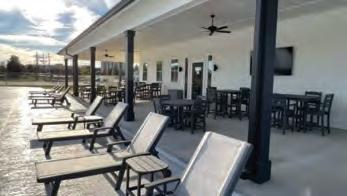





Throughout much of the eighteenth century, the colonial indigo industry was prosperous in Louisiana. The work was laborious and dangerous, and required more and more enslaved workers as the plantations grew.
“Indigo helped to incentivize slavery,” said Charles Ray Brassieur, Ph.D., a professor of anthropology at the University of Louisiana at Lafayette. “If they were going to do this, they needed more slaves. When they had enough slaves, that helped them believe that they could now grow cotton. And sugarcane.”
These other commodities became more attractive to Louisiana planters as the indigo industry suffered from war and tariffs; not to mention plagues and the toll commercial-scale indigo extraction took on the environment and the people who processed it. Enslaved people suffered health problems due to the fumes. Waste from the processing was often drained into nearby waterways, polluting drinking water and poisoning livestock.
By the late eighteenth century, cotton was reigning king in Louisiana. Within a century, the entire global trade of natural indigo was supplanted by the discovery of synthetic indigo dye, which could be mass produced at a far lesser cost. The commercial incentives to cultivate indigo diminished, and eventually, so did the knowledge of how to use it.
Although indigo’s role in Louisiana’s history has been frequently reduced to a footnote, its traces remain: in Indigenous folktales, in the presence of African American families whose ancestors were brought here for their knowledge of the “blue gold,” and in the patches of Indigofera tinctoria growing across the region—descendants of an industry that once held the world in its grip.
The modern-day revival, according to Franzen and Brassieur, represents an interesting counter-movement to the plant’s colonial legacy. In opposition of the dye’s history as an ecological hazard, these indigo operations are frequently exercises in ecological stewardship and sustainability. “It’s interesting because the same plant can produce very different outcomes, depending on the sort of intention and processes and goals behind it,” said Franzen. “Companies are using nitrogen-fixing species, and processes that minimize toxicity”—ultimately causing far less harm than their synthetic counterparts and producing high-quality artisanal products that challenge the fast-fashion landscape.
e “Le Bleu Perdu” project is ongoing at Atelier de la Nature, which, in addition to its spring symposium, featured a presentation and workshop from Malian dye master Aboubakar Fofana in December 2024. Stay up to date with upcoming programming at atelierdelanature.org.
Blue Gold: e Art and Science of Indigo will be on exhibition at the Mingei International Museum in San Diego until March 16. You can peruse the exhibition highlights, including Moses’s camp dress and the Dubanksys’ histological stains, as well as a series of essays on various aspects of indigo, at mingei.org/exhibitions/blue-gold.


The revivals also join a national wave of reckoning with the destruction inflicted by colonialism and enslavement. Within these reckonings are invitations for Indigenous and African diasporic peoples to both mourn the suffering of their ancestors under the plantation system built around indigo and reclaim a tradition that their ancestors had mastered.

Hoping to facilitate multi-disciplinary interest and explorations on indigo in Louisiana, and to source existing local knowledge, last spring the Ballengées hosted a two-day gathering at the Atelier centered on “The Lost Art, Science, and Culture of Indigo” in Louisiana.
At the well-attended event, the Dubanskys presented a demonstration of their histological staining process. Brassieur and Franzen gave talks on the history and socio-cultural dimensions of indigo in Louisiana. Participants planted seeds and learned how to nurture their growth as part of biodiverse Louisiana prairie ecosystems. And Sandra Sarr, a local writer, read an original poem titled “The Road to Indigo.”
The climax of the weekend was a dyeing demonstration. Two local textile artists, Ellie Barker and Suzanne Chaillot Breaux, walked visitors through their process of extracting dye—using Baptisia from nearby prairies in one vat, Indigofera suff ruticosa from the New Orleans Botanical Garden in another, and Indigofera tinctoria from Louisiana State University’s campus in another.
Into the native Indigo suff ruticosa, LouAnn Moses, an artisan of the Canneci Tinne Apache Tribe, dipped a traditional “camp dress,” transforming the muslin into a rich, beautiful blue—just as her ancestors would have. According to Goodbear, Moses is the last tribal citizen with knowledge on how to sew ceremonial Canneci garments, which she has been dyeing using synthetic dyes.
“The symposium was like a reintroduction of indigo to our tribe,” said Goodbear. Since the event, the tribe has been working on securing a space to grow native indigo to use regularly for their ceremonial clothing. “So, when we go to Pow Wow or gatherings, we’ll actually have our traditional muslin, dyed with indigo.” The true blue. Tatxe



Elaine Larcade Bourque has been a textile artist in South Louisiana for almost forty years now, devoting herself to traditionally recreating Acadian brown cotton textiles—growing the cotton herself, harvesting it, spinning the fibers into thread, and then weaving it on a loom. While she was apprenticing under master weaver Gladys LeBlanc Clark in the early 1990s, Clark received some indigo seeds and a recipe to create dye. Because indigo blue was a crucial part of the traditional Acadian textile colorways, Bourque has since incorporated the cultivation and processing of indigo (Indigofera tinctoria) into her process, which she graciously shared with us for this story.
Plant your indigo seeds in full sun, when the soil is warm, after the last frost date but as early in the spring season as possible—between February to mid-April. Generally, by the end of summer (around September), you can strip the leaves, and they’ll grow back and give you another crop (by around November). If a frost is on its way, harvest—the leaves won’t survive extreme cold.
Step 1: In the late afternoon, stuff your leaves, tightly, into gallon glass jugs.
Step 2: Fill each jug to the top with water, ensuring all the leaves are wet.
Step 3: Let sit overnight.
Step 4: Get a very large pot and place it on the kitchen stove. Place a dish towel at the bottom of it. Place your glass jug with the leaves in the water. Very, very slowly, heat the water to 160 degrees. This usually takes around two hours. When it reaches 160 degrees, you should see some spots of purple, blueish color floating to the top of the jug.
Step 5: Take the glass container out of the water and strain the leaves into another container using a colander. Squeeze any excess liquid from the leaves with your hands and then dispose of them. You should have about a gallon of liquid.
Step 6: Cover your liquid and keep it at room temperature until you are ready to use it. Have your cotton, or other fabric or fiber, soaking in water for two or more days before you are ready to dye.
Step 7: When you are ready to dye, add a heaping tablespoon of baking soda to the solution. Incorporate thoroughly by passing the liquid back and forth from one container to another about ten times, until there is a froth at the top.
Step 8: Add three tablespoons of Rit Color Remover. Your solution should now be a brown color.
Step 9: Let simmer on the stove between 101–120 degrees for about thirty minutes to an hour. At this point, it should change to a yellow or tannish color, with a bit of blue at the surface.
Step 10: Drop wet cotton slowly into the indigo bath, avoiding incorporating much air. Leave soaking for thirty minutes.
Step 11: Pull the cotton up, squeezing out excess dye. Within sixty seconds, oxidation will occur and you will observe your cotton changing from a bright yellow to green to blue.
Step 12: Let dry in the sun.
Step 13: Rinse the textile in a bath of one tablespoon of vinegar per quart of water until the water is clear. This helps set the color and prevent bleeding.



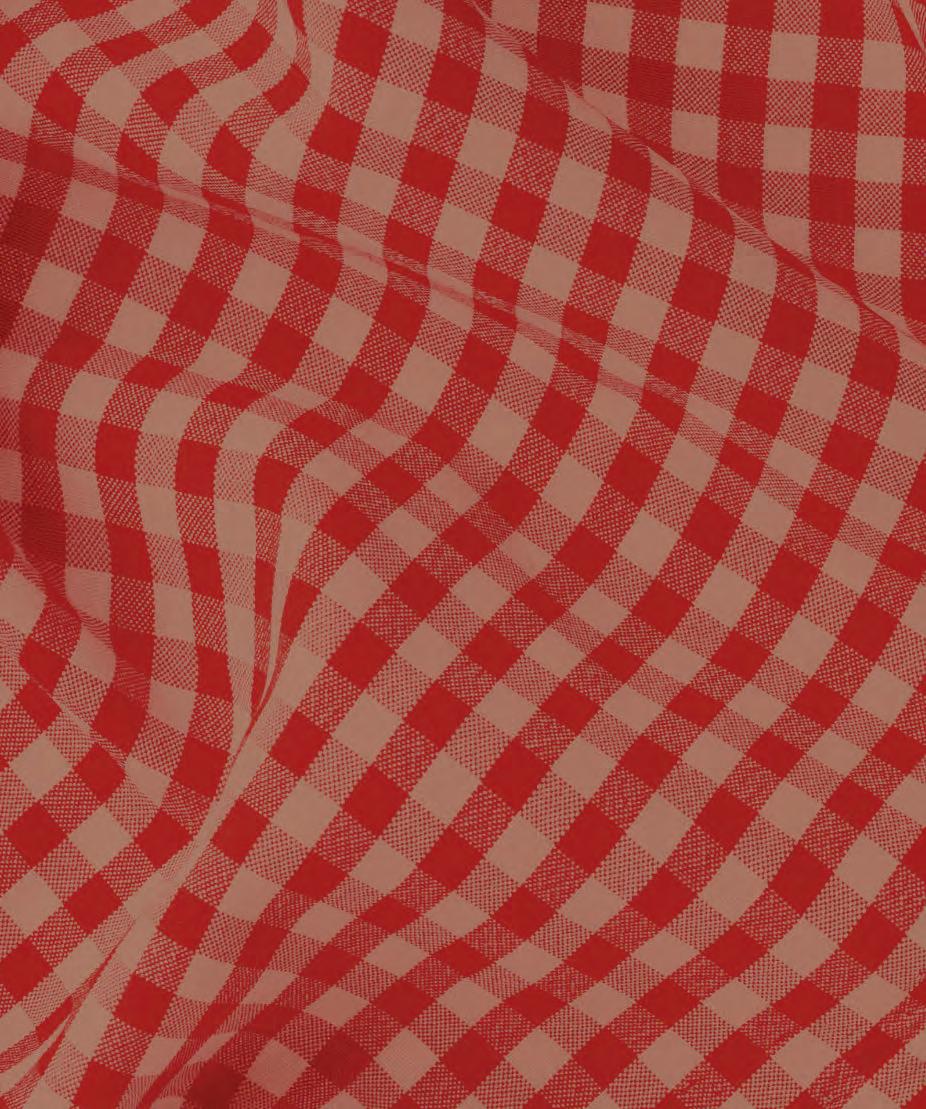







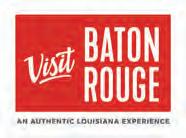













Story by Brian Altobello
Inhabitants of Acadiana revel in their often-untethered passion for life, their joie de vivre. It is a cultivated image, incongruous against the unsparing confines of the American Gothic South. This ebullience erupted in an unlikely place in 1934. Wrestling with the woes of the Great Depression, Lafayette and its sibling towns discovered solace from the rigors of a diseased economy in America’s pastime.
For the region’s modest but beloved baseball league, which came to be called the Evangeline League, a Class D (lowest classification) professional organization of teams was formed, assembled from
archenemy. But everyone’s bête noire was the White Sox of Lafayette. The hub city in Acadiana had the best ballpark, the coldest beer, and the most money—the “evil empire” of the Evangeline.
Still, profits were thin in 1934, the league’s inaugural year. All the clubs sold outfield fence space (usually $25), program ads, stock sales, and “corporate” season tickets. Opelousas, suffering from poor attendance, used a novel approach, arranging that $1 a week from each of the over-100 slot machines in town be dedicated to the Indians. At the urging of team secretary Austin Fontenot, who also happened to be the
"CROWDS APPEARED JUST TO SEE THE SHOW. IT MAY HAVE BEEN TO SEE FRANK MARTELLI, THE SKIPPERS’ HARD-HITTING FIRST BASEMAN, PLAY BAREFOOTED. . . WHEN THE ACTION LAGGED, FANS AMUSED THEMSELVES BY DROPPING CIGAR ASHES DOWN [THE BACKSTOP'S] COLLAR."
a nucleus of seventeen to twenty-fouryear-old semi-pro players who ricocheted around the bayou country of south Louisiana playing games for a few dollars on weekends.
The idea was born during 1933’s spring training. Tee Paul Leblanc, a lanky Lafayette fireballer, threw an eye-opening shutout in an exhibition game against the defending Class AA New Orleans Pelicans. “You know,” exclaimed Pelican manager Larry Gilbert in the fourth inning, “I don’t think we can beat this boy!” Tee Paul’s hometown crowd exploded with his last inning strikeout, and a hat was passed around, collecting for the smiling young hurler over $200.
Prominent businessmen were enlisted to invest in the league, and enthusiasm amongst them was abundant. Six teams were formed: The Lafayette White Sox, the Opelousas Indians, Rayne Rice Birds, the New Iberia Cardinals, the Alexandria Aces, and the Lake Charles Skippers. Rayne’s largest backer was a wealthy rice farmer who could neither read nor write, but he believed that his town would profit from its proximity (only twenty miles) to Lafayette. New Iberia and Opelousas also orbited tightly around Lafayette, by far the largest of the six with 14,635 residents. Heated rivalries were guaranteed, as between Opelousas and Alexandria, and when Jeanerette and Abbeville joined the league a year later, New Iberia was their
town’s attorney general, the machines displayed signs: “This Machine Operated for the Benefit of the Opelousas Baseball Club.” According to road secretary Frankie Deitlein, when a Life magazine reporter arrived to do a story on the Indians, Deitlein was assigned as his chaperone. His main task was to keep him from photographing the slots, which was the real reason for the reporter’s visit. Three days were spent in the little town, gambling, drinking, and visiting a brothel. “I gave him such a good time,” Deitlein revealed, “that he promised not to develop the photos.” Life never carried the story.
Meanwhile, the league was fast developing a reputation for the unorthodox, a badge proudly worn. Crowds appeared just to see the show. It may have been to see Frank Martelli, the Skippers’ hard-hitting first baseman, play barefooted. Or, to engage in some playfulness at the Rayne ballpark, where the backstop was just inches from the home plate umpire. When the action lagged, fans amused themselves by dropping cigar ashes down his collar.
threatening that the team would withdraw from the league if this umpire was allowed to continue calling games. More cheers. Police were called to escort the besieged ump off the diamond. The rest of the game was left to a single official, who presumably was quite apprehensive finishing the contest.
As for Stephenson, he was suspended, but once he returned to the lineup, so too did his recklessness. After each hit, he would wildly beat his chest while standing on base and yell, Tarzan-style. Before each game, he further enhanced his identity by scrambling up the backstop and screaming his patented yell to exhilarate his fans. It worked, not that they needed any additional influences, given that flasks of whiskey were as common in the stands as foul mouths and foul balls. Ladies and kids be damned.
Carl Gilmore, a pitcher, remembered that the plate umpire came to one game without his mask, so he had to position himself behind the pitcher on the mound. When he didn’t call an obvious strike, Gilmore angrily spit into the air. “The wind was blowing in hard that day. After the third spraying, he fined me $5.” Police, always present, had to rush the field to guard one official at a game in New Iberia in 1936 after a close call at second base. Threatened by enraged fans, four beefy cops escorted him out of the park, whisking him to a police car. A swarm encircled them. Police finally managed to drive the terrified ump away, leaving behind a squawking mob.
Sometimes assaults would happen hours after a game. In a smoky Opelousas pool hall one night, two umpires were relaxing. “Some guy walks over and, without ceremony, socks one of them,” remembered a bystander, starting “a regular brawl” inside the establishment.


to pour onto the diamond. After a long delay, the mayor finally persuaded everyone to return to their seats.
Abbeville, which, entered the league in 1935, soon contributed to the Evangeline’s reputation as the “Hot Sauce” League. At a game there against Lafayette, a close call at third went against the home team. Enflamed, fans charged the field in pursuit of both umpires, who received little assistance from local security.
President Frem Boustany of the White Sox refused to allow his team to play in Abbeville again unless Mayor Nelson Hollier promised state militia protection for his players and officials. Nelson refused, replying that he could not guarantee the umpires’ safety unless “they treated the fans in a gentleman manner.”
A compromise was reached, but in June, 1937, the loop’s umpires resigned en masse because of the increasing violence. For two days, teams’ bench players officiated games. League president Walter Morris met with the disgruntled men, and police protection was redoubled. Still, the unhinged territorialism prevailed.

Umpiring was hazardous. When one of them once missed a borderline pitch, White Sox catcher Walter Stephenson forever endeared himself to Lafayette’s fans after turning and punching him, knocking off his mask. When peace was restored, the public address announcer assured the tempestuous fans that a telegram was being sent to the league office

In another incident, J.A. Trotti, the popular mayor of Lake Charles, was watching a game in the grandstand and had to run onto the field to restore order. Furious fans had charged the official,
threatening







him after a bang-bang play at first. He was led away by security, but a throng continued
Charles game in a player’s car. Passing a watermelon patch, he ordered the driver

Salaries for these beleaguered officials were $35 per month in 1934 ($200 after the war) with no expense accounts. They purchased their own equipment and paid for travel themselves. Most did not have cars, and it was not uncommon for them to travel with team members to and from games in someone’s car or in a rented school bus. On one occasion umpire Monk Mollazzo stole a ride to a Lake Charles game in a player’s car. Passing a watermelon patch, he ordered the driver to stop. Mollazzo crawled under a fence, stuffed a ripe one under his arm, and returned to the car. Someone spotted him and fired a shotgun at the car as they zoomed away.




Players in 1934 were paid $135 per month, although this could be improved when owners paid their best athletes lagniappe under the table. Austin Fontenot would often hand players $10 before they came to bat for encouragement. Local merchants commonly offered “sponsorships” as well. One in New Iberia provided a free shirt and another a movie pass for a home run. Lake Charles barbers often allowed free haircuts to Skipper players. A café in Rayne awarded a “delicious” frog dinner for the first stolen base of the season. The first to beat out a bunt earned a “complete Shinola outfit,” and an electric fan went to the first player to strike out. In baseball’s version of tipping, hats passed hand-to-hand in the bleachers to reward a player for an exceptional play or winning hit—or something else. When a Lake Charles Skipper’s wife lost a child at birth, a collection at a game garnered the couple $96.35. Tom Patton, the White Sox radio announcer called it “a beautiful relationship.”
One Wisconsin-born Lafayette outfielder remarked: “If I took up everybody on all their dinner invitations, hell, I wouldn’t have been able to run.” When he tried paying for his meal at a restaurant, inevitably the waitress would tell him that someone had already paid for it.
Home fans were even good to opposing players. Larry Jones, an Abbeville pitcher, was forced to endure a heckler who would harass him, even at away
games. Once in New Iberia, his nemesis was in the stands yelling his usual insults. Nearby sat a New Iberia fan, also screaming at Jones. Between innings, the Abbeville fan approached the New Iberia howler, telling him to “shut his damned mouth!” Perplexed by this outburst, the New Iberia supporter replied, “You’re riding him too!” “Yeah,” retorted the Abbevillian, “but he’s a friend of mine!”
Shortstop Art Visconti recalled: “When we went down to Cajun country, we caught hell. They were real good, warm people. I’d ride them back when they’d ride me. I’d yell, ‘How you coonies doin’ tonight?’ They’d yell, ‘Man, you’re goin’ to lose tonight, ya!’ ”
The parks themselves were anomalies. In one, telephone wires were strung along the foul lines. A fly ball was considered “in play” if it deflected from a wire and could be caught for an out. The right field fence at Rayne’s park was just 220 feet from home, so a ball lofted over it was ruled a ground rule double. Still, over 1,000 fans attended opening day there against Opelousas in 1935, locked and loaded. Jeanerette, population 2,228, entered the circuit in 1935 despite the inconvenient placement of an 8’x10’ pumphouse in their home park’s right field. Officials had to determine whether a ball hitting it on the fly could be caught.
Many of the Evangeline players were castoffs from other leagues in other states. In the early years Lake Charles

even had an outfielder from Portugal on the roster, and shortstop Stanley Kravis, a Pole, played on several teams in the circuit. White Sox outfielder Zenon Ochoa was Mexican and spoke no English. When he was on first, his interpreter became his base coach. Considering their reputation for xenophobia, the Cajuns readily embraced non-Louisianans—as long as they could play! Abbeville, which entered the league in 1935, boasted several team members from Tennessee. They were astounded by the graciousness extended to them by the fiery fans from Vermilion Parish. Never, they told one reporter, had they found such hospitable folks, adding that there were more fans in Abbeville in proportion to the population than in any other section of the country they had visited. The town captured the coveted attendance trophy on opening day in 1935 with 1,463 fans. New Orleans sportswriter Bill Keefe did some arithmetic. Astounded by the league’s popularity, he compared attendance there with the Double A New Orleans Pelicans: “If New Orleans drew as much in a baseball way as Rayne or Abbeville … the Pelicans would have an attendance of 14 million …”
Until the 1950s, Acadiana’s African American baseball fans supported their own semi-pro teams, and new bleachers were expanded to accommodate their growing numbers in each park. Just as vocal and fervent as their white coun-
terparts, over one hundred regularly attended Rayne Rice Bird games in the early years. It wasn’t until 1956, nine long years after Jackie Robinson broke the color line in the majors, that five Black players appeared on the rosters of the Lake Charles and Lafayette clubs. Sadly, members of the league resisted this move toward integration, and voted to oust the two teams if they did not dismiss the players in question. Lafayette promoted theirs and Lake Charles declared their three “not good enough,” releasing them. One was Filipe Alou, who went on to play brilliantly for seventeen years in the majors. League President Ray Mullins claimed that racism had nothing to do with the decision.
World War II interrupted league play, which by then had expanded to Natchez, Mississippi and Port Arthur, Texas, both towns with legitimate Louisiana pedigrees. Thibodaux, Houma, Hammond, and Baton Rouge entered teams after the war as well, but with air conditioning, television, and a successful boycott of the games by Black fans after the expulsion of Alou and the others, the league barely survived the 1957 season.
It was a Camelot existence, however brief. The league demonstrated Acadiana’s exceptionalism and idiosyncracies, enhancing its enormous pride and energizing an identity for these mostly small towns during the grim days of the Depression and thereafter.















There’s an all-too-appropriate eccentricity to the elegance of the Louisiana Iris. Like a festival queen, the flower is all drama, bedecked in legacy. Out of the murky swamp, she emerges in the loudest of colors, long petals delicately unfurling to reveal a sweet throat beloved by the bees and the birds.

There are three hundred species of iris growing in the Northern Hemisphere, and many are native to Louisiana. But only five species, all closely related and only able to interbreed with one another, are considered true “Louisiana Irises”: the Zigzag Iris, or Short-Stemmed Iris (Iris brevicaulis); the Copper Iris (Iris fulva); the Dixie Iris (Iris hexagona); the Giant Blue Iris (Iris giganticaerulea); and the Abbeville Red Iris (Iris nesonii).
lovely) weed into a botanical treasure. Described once by The Times-Picayune as “amounting almost to a cult,” groups of iris enthusiasts were known to wander into the swamps and bogs of South Louisiana in search of these flowers in all of their varying colors, forms, and styles. Among these early obsessives were icons such as Mary Swords DeBaillon and Caroline Dormon, as well as Percy Viosca and Ira S. Nelson.
Around the 1930s, the Louisiana Iris Conservation Society (now the Louisiana Iris Conservation Initiative, LICI) was formed, followed shortly after by the Louisiana Iris Society (now the Society for Louisiana Irises, SLI) in 1941. Today, there is also the Greater New Orleans Iris Society, GNOIS, founded in 2000. In 1990, after years of advocacy by iris enthusiasts to have the iris
Story by Jordan LaHaye Fontenot
wild due to factors like habitat loss, saltwater intrusion, and climate change, as well as the increased use of herbicides. As it has for a century now, though, the flower maintains its champions; conservation organizations and societies have worked tirelessly to rescue seeds and seedlings in vulnerable areas and to reinstate them in secure locations, often with the goal of making them accessible to the public as a means of education.
Since 2020, the Louisiana Iris Conservation Initiative has published a Louisiana Iris Viewing Locations Map, integrated with Google Maps, drawing out a path to some of the best publicly-accessible destinations to see Louisiana Iris during blooming season, between lateMarch and late-April.

Using these locations, and a few more, I embarked on an iris hunt for the ages last spring—and am eager to send you out this year to experience the wonder yourself.
Welcome to the cult.
Editor’s Note: This trail takes you on a massive, almost-600-mile loop across Louisiana. It would be, frankly, impossible—even for the most ambitious iris hunter—to hit all of these locations in less than four days, especially because to see irises, you do, in fact, need sunlight. If you don’t have that much time to give, simply visit the destinations nearest you, or embark on a daytrip (or two) to cluster destinations on the Northshore, in New Orleans, or along the Bayou Teche region. Always check location websites and Facebook pages regarding potential closures, ADA-accessibility, and other concerns before you go.
LICI’s own map, with GPS-capabilities, should be available in early March. We’ll link it at our website as soon as it is available. During bloomtime, LICI posts frequent updates on the status of many of these iris destinations on their Facebook Page.
On this circa-1859 family homestead of Caroline Dormon—the pioneering naturalist and artist who was the first woman to be hired by the U.S. Forest Service—remain the bright blooms of her legacy as an iris cultivator. Dormon’s collection of Louisiana Irises, grown in the property’s Bay Garden, is one of the oldest in existence. There are more than 150 cultivars, many only existing at Briarwood. After suffering extensive damage during a 2019 tornado, the garden was finally partially re-opened to the public last year after careful restorations by onsite stewards, volunteers, and high school students. A new trail on the property also showcases thousands of Southern Blue irises (not a native Louisiana iris, but beautiful nonetheless). Note: Visits to Briarwood are by appointment only. briarwoodnp.org

Moncus Park
Lafayette, Louisiana
Ville Platte, Louisiana
I’d be remiss not to mention my hometown iris site, at the State Arboretum—a longtime dream of naturalist Caroline Dormon’s come to life. When it opened, she helped establish a vast collection of native Louisiana trees and shrubs for the 600-acre preservation area. And on the Wetland Trail, at the heart of it all, still grows, to this day, a stand of wild Louisiana Iris. You can also see a collection of hybrid varieties on display near the Arboretum’s entrance. friendslaarb.org
Since opening its gates in 2022, Moncus Park has been a dedicated site for Lou isiana’s native flora, and is now home to the state’s largest display of iris culti vars—which include a collection of over 10,000 Louisiana irises in a stunning, multi-colored display around Lake Reaux at the center of the park. Last May, the team facilitated a planting in partnership with LICI of 400 Giant Blue Irises, and in January received a generous donation from the Sunset estate of Richard Goula—a dedicated cultivar and historian of Louisiana Iris. The donation of 1,000 specimens included a collection of vintage plant identification tags that will provide vital knowledge towards preserving rare varieties of iris from the 1960s. The flowers are set to have their first bloom this spring. moncuspark.org

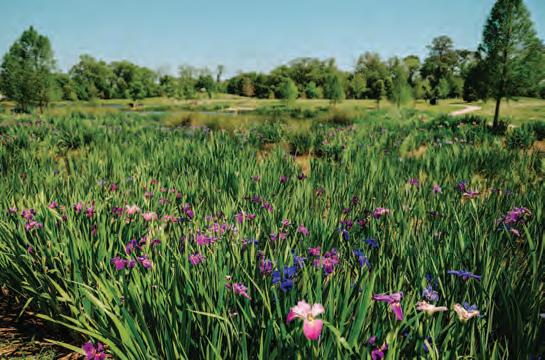
Abbeville, Louisiana
The rarest of all Louisiana Iris can be seen here on a short hike behind the Nature Center, which takes you directly, via boardwalk, into the cypress-tupelo swamp. This distinct, isolated, ecosystem is the only place where the Iris nelsonii, or Abbeville Red Iris, thrives. This large, red or red-purple (rarely a pale yellow) flower is Louisiana’s only endemic plant; it can’t grow naturally anywhere else in the world, with natural range restricted to a privately-owned swamp in Vermilion Parish. In 2011, staff from the Friends of Palmetto Island, Palmetto Island State Park, Louisiana Wildlife and Fisheries, and the Office of State Parks planted 100 rhizomes here in this swamp for public viewing. Come on April 5 from 11 am–4 pm for the annual Abbeville Red Bloom Event, featuring expert talks, photography opportunities, and more. lastateparks.com/parks-preserves/palmetto-island-state-park.

St. Martinville, Louisiana
Historically, Iris giganticaerulea, also called “Giant Blue Iris” or “Giant Blue Flag,” grew all along the Bayou Teche. In recent years, volunteers from LICI have worked to re-establish these populations—with a special concentration around the lore-laden Evangeline Oak Park. When I visited last year, in early April, the purple flowers dotted the bayou’s shoreline, ready to spring forth into their full bloom any minute.
New Iberia, Louisiana
On another section of the Bayou Teche, in the center of historic New Iberia, LICI has planted hundreds of Giant Blues, which have thrived in their new home. You can view them up close by walking along trails beside the bayou.
Centerville, Louisiana
On the Garden City Levee Foot Trail in this wildlife refuge near Franklin, visitors will find a boardwalk to take them to iris paradise—here, there are more Giant Blues per square foot than almost anywhere else in the state. According to the LICI Viewing Map, being here is like stepping back in time to when the swamps were practically purple with the blooms. fws.gov/refuge/bayoy-teche.




Morgan City, Louisiana
Follow the Teche to Morgan City, where you’ll find the Cajun Coast Tourism folks situated on a classic stretch of Louisiana cypress swamp. All around the building are Giant Blues the LICI transplanted from endangered areas around the region. cajuncoast.com.
Houma, Louisiana
This one mile out-and-back trail, great for beginners and taking about twenty minutes to complete in total, will guide you through a narrow hardwood forest and into the swamp. Off-the-beaten path, you’ll likely have your run of the place. This swamp’s native iris population has suffered due to storm surges from hurricanes in recent years, but LICI has been adding more Giant Blues to the population each year. fws.gov/refuge/mandalay.
Lockport, Louisiana
This well-maintained boardwalk is in the middle of absolutely nowhere—you’ll question yourself a few times on the way, no doubt. But as soon as you find the parking lot, you’ll know you’re in the right place because of the wild bloom of Iris fulva, or “Copper Iris” in the ditch. On the actual boardwalk itself, which is a brief 440-foot finger into the serene swamp—kind of like stepping into the wardrobe for just a moment— the Giant Blues that once grew here have all but disappeared. But when I visited, right at sunset, I noticed a single flower glowing from within the lush mass of greenery.
For the committed, to be sure—this detour from the trail to New Orleans will set you back more than two hours round trip. But if you embark on the journey, you’ll find an iris bog along the boardwalks that is still in recovery from damages by Hurricane Ida, growing back thicker and more vibrant by the year, with thousands of blooms. The flowers attract travelers from miles ‘round. Come at just the right time, and you’ll catch the Migratory Bird Festival while you’re there.
Marrero, Louisiana
The Bayou Coquille Trail is one of the first swamp boardwalks built in the region, one of the earliest opportunities for the public to step into this ecosystem and see it up close—making it at one time one of the only ways for city-dwellers to see blooming

irises in the wild. Today, despite the damages of saltwater surges entering the refuge during hurricanes and tropical storms, the Coquille Trail is still brightened by clumps of Giant Blues, and you can even see Copper Irises growing along the roadways. nps.gov/jela/planyourvisit/barataria-preserve.
Braithwaite, Louisiana
A designated stop on the American Wetland Birding Trail, this state park just outside of New Orleans, right on the Mississippi River, has Giant Blues growing near the picnic pavilion, as well as along the 2.7 mile State Park loop trail (recent hikers have warned that though the accessible parts of the trail were lovely and well-maintained, they couldn’t complete the loop because of closures). lastateparks.com/ parks-preserves/st-bernard-state-park
New Orleans, Louisiana
Longue Vue’s Wild Garden, which was designed by pioneer landscape architect Ellen Biddle Shipman and contains iris contributions from Caroline Dormon, holds the oldest consistently maintained Louisiana Iris collection in New Orleans. Though the collection suffered a massive loss during Hurricane Katrina, it has slowly been nurtured and revived to now contain over 3,500 plants that make magic of Shipman’s pathways. Among these, you’ll find all of the Louisiana Irises, as well as over 130 named historic and contemporary hybrid cultivars. Each April (scheduled this year tentatively for April 8), Longue Vue partners with GNOIS to host the Louisiana Iris Day at peak bloom time, featuring free admission and refreshments. longuevue.com
New Orleans, Louisiana
The Sydney and Walda Besthoff Sculpture Garden is an especially lovely place to wander in the spring, and it is a great spot to witness a vast number of native irises in bloom, mostly donated by the GNOIS. You’ll also find extensive beds of Louisiana Iris cultivars in the older section of the sculpture garden. Then, walk on over to the Louisiana Children’s Museum, where an impressive collection of Giant Blues rests in the lagoon.
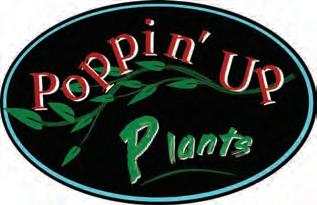
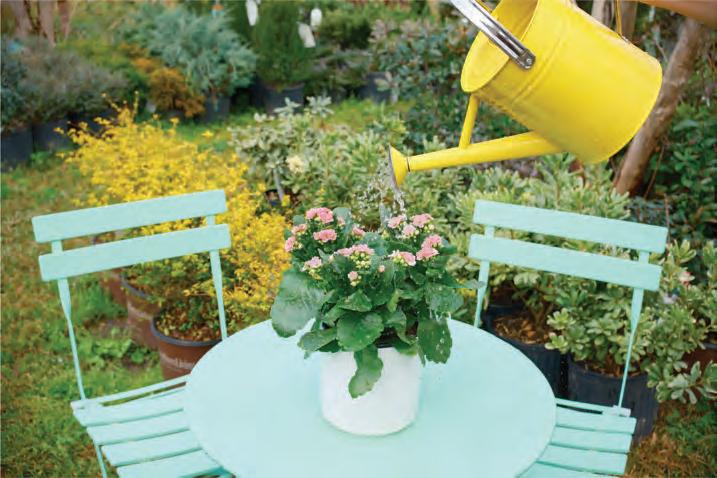

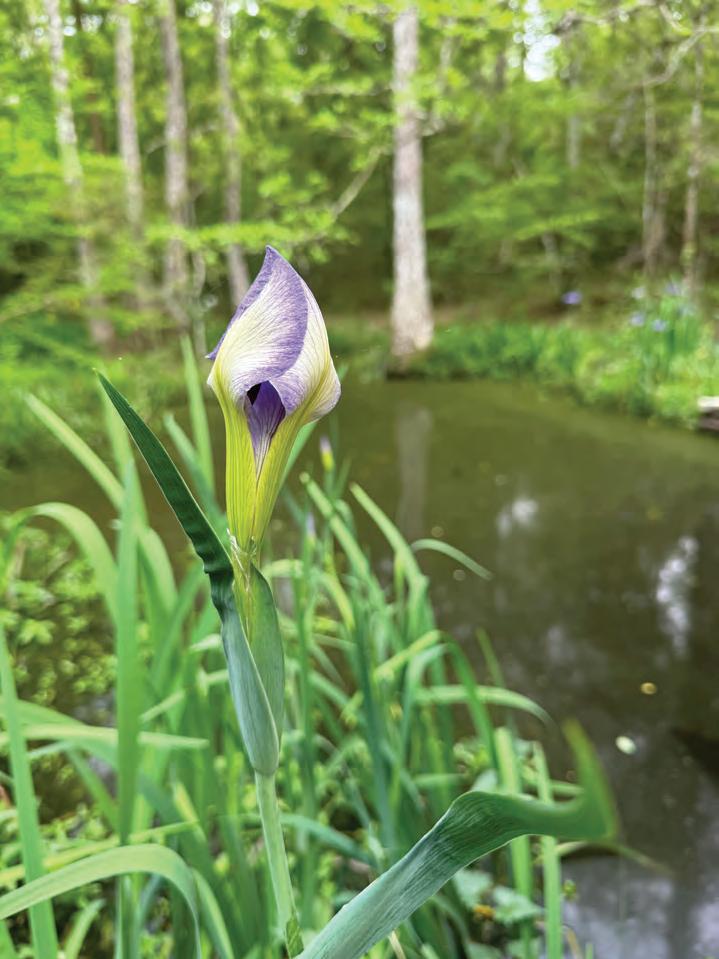
City Park will also host the Louisiana Rainbow Iris Festival on March 31 from 10 am–3 pm, featuring the height of the bloom and the opportunity to speak with iris experts on site.


Lacombe, Louisiana
Long a beloved place for iris fanatics to come and ogle at the showstopping Giant Blue blooms, which occur here naturally, this half-a-mile looping boardwalk trail is a gorgeous excursion in its own right. When I visited in early April last year, none of the famed irises were yet blooming. I found out later that for some mysterious reason, these are always the last irises to bloom in Louisiana—so if you’re hunting late in the season, this is a must stop. fws.gov/refuge/big-branch-marsh
Mandeville, Louisiana
In December, experts from LICI were estimating a bloom of 12,000 irises at Fontainebleau State Park this year. Situated to the left of the picnic pavilions near the beach area on the shore of Lake Pontchartrain are the iris bog and adjacent trail; you can drive right up to them. It’s a remarkable view, the purple flowers shooting out over the lake’s horizon. When I visited last year, over half of the irises had only been planted a year prior and were too young to flower. Even still, the display was full of wonder. This year, in full bloom, the sight should be unforgettable. lastateparks.com/parks-preserves/fontainebleau-state-park
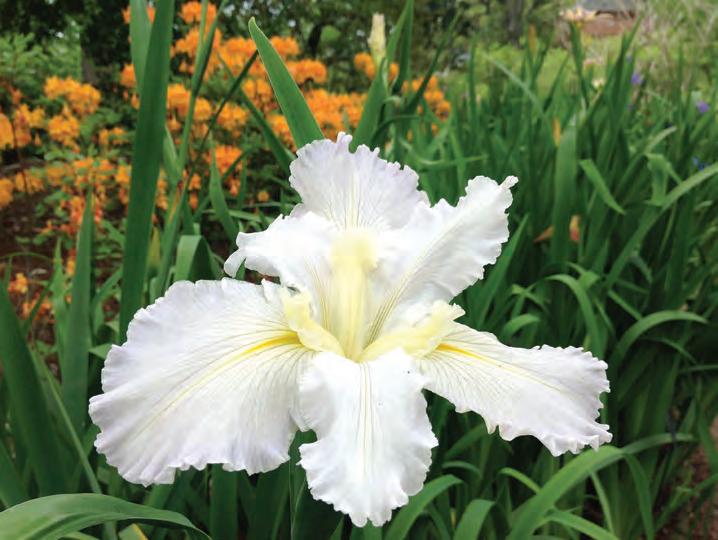
Mandeville, Louisiana
This is the most demanding stop along this Iris Trail excursion, requiring about a (very pleasant) mile’s walk down the wooded Clubhouse Trail to reach the main iris display at Iris Cove. About half a mile in, I wondered if I was going the right way, and then crossed a family holding a bunch of iris in their hands. “How far is it?” I asked them. “Right around that bend,” they said. The collection at Northlake, largely planted by GNOIS


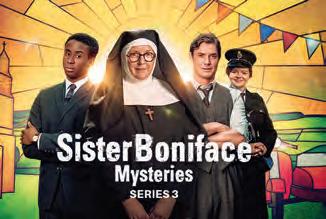

in 2017, originally included all five Louisiana Iris species. On my visit, I noted Giant Blues, some Copper Irises, and Dixie Irises. Despite being intentionally cultivated, the Iris Cove has an especially magical, fairyland quality—a sparkling pool of swampwater shining bright in the sun, with bursts of color everywhere you look. northlakenature.org
Mandeville, Louisiana
In this more developed setting, surrounded by baseball diamonds, LICI
has been utilizing retention ponds near the Silver Field and Gold Field as places to safely grow rescued irises for use in restoration projects—adding more irises each year with the help of volunteers and allowing them to multiply. In the meantime, visitors can enjoy the masterpiece of hundreds of irises all easily visible at once. According to reports by the LICI, plans are underway for the bogs to double in size for this year’s bloom. pelicanpark.recdesk.com
Madisonville, Louisiana
To get to the trail, drive on past the campgrounds all the way to the back. A small sign announcing “Swamp Trail” will usher you onto a .4-mile in-and-out boardwalk that takes you from the parking lot into another dimension. Cypress knees burst from the ground, the canopy quivers above you, and Spanish moss is draped everywhere. And if you look closely, you’ll spot the unmistakable pops of color of Giant Blue Irises. This past January, the park’s late manager Marvin Steinbeck was memorialized in a planting of over 500 new irises, bringing the swamp’s total number up to 1,000. lastateparks.com/parks-preserves/ fairview-riverside-state-park



Baton Rouge, Louisiana
A project begun in 1991 through initiatives of BREC and the Baton Rouge Botanic Garden Foundation, the gardens in Independence Community Park feature a dedicated Louisiana Iris Garden at their center. All along blissful strolling paths, the garden displays all five native species of Louisiana Iris, as well as several hybrids in honor of the late Baton Rouge iris hybridizer Joseph Mertzweiller. brec.org/botanicgarden
Baton Rouge, Louisiana
Across the gorgeous property at Burden, you can find irises of different varieties during season. But the best showcase is along the 2.2-mile-long Black Swamp Trail Boardwalk hike—where GNOIS has planted Giant Blues and Abbeville Reds throughout the rain-fed swamp. You can also find clumps along the edges of the Barton Arboretum Pond. lsuagcenter.com •



Alexandria, LA
Alexandria Museum of Art 53
Baton Rouge, LA
AllWood Furniture 37
Art Guild of Louisiana 9
Baton Rouge Ballet Theatre 20
Baton Rouge Blues Festival 59
Baton Rouge Clinic 39
Baton Rouge Epicurean Society 51
Becky Parrish 59
Blue Cross Blue Shield 22
East Baton Rouge Parish Librar y 64
Elizabethan Gallery 9
Lagniappe Antiques 57
Louisiana Nursery Showplace 10
Louisiana Public Broadcasting 58
LSU Online and Continuing Education (OLLI) 47
LSU Rural Life Museum 21
Mary Bird Perkins Cancer Center 33
Pennington Biomedical Research Center 7
Tiger’s Trail RV Resort 49
Window World of Baton Rouge 38 WRKF 89.3 FM 58
Biloxi, MS Coastal Mississippi 2
Brookhaven, MS Brookhaven Tourism Council 43
Destrehan, LA Destrehan Plantation 16
Erath, LA The Acadian Museum 23
Folsom, LA
Giddy Up / Far Horizons Art Gallery 50 Hammond, LA Tangipahoa Parish CVB 63 Jackson, LA Galvez Rum 47 Lafayette, LA AllWood Furniture 37
& J Exterminating 13
Crafts Guild 25
Park 14 Mansura, LA Avoyelles Commission of Tourism 30
City, LA Cajun Coast CVB 49 Natchez, MS Natchez Convention Promotion Commission 43 Natchez Festival of Music 15 Natchez Garden Club 11
New Iberia, LA Iberia Parish CVB 5
New Roads, LA City of New Roads 12 Pointe Coupee Parish Tourism Commission 29 Wine Down 56
New Orleans, LA Longue Vue House & Gardens 55 New Orleans Jazz and Heritage Foundation 41
Opelousas, LA St. Landr y Parish Tourist Commission 17
Pass Christian, MS Art in the Pass 19
Plaquemine, LA Iber ville Parish Tourism Department 35
Ponchatoula, LA Ponchatoula Strawberry Festival 24
Port Allen, LA
West Baton Rouge CVB 18 West Baton Rouge Museum 50
Port Arthur, TX Visit Port Arthur 6
Raceland, LA
Louisiana’s Cajun Bayou 26, 27
Scott, LA
Bob’s Tree Preservation 31
St. Francisville, LA
Afton Villa Gardens 13
Azalea Polo Classic 45 Bank of St. Francisville 3 Cross Quilter 57
Poppin Up Plants 57 Town of St. Francisville 55
Zachary, L A Lane Regional Medical Center 40



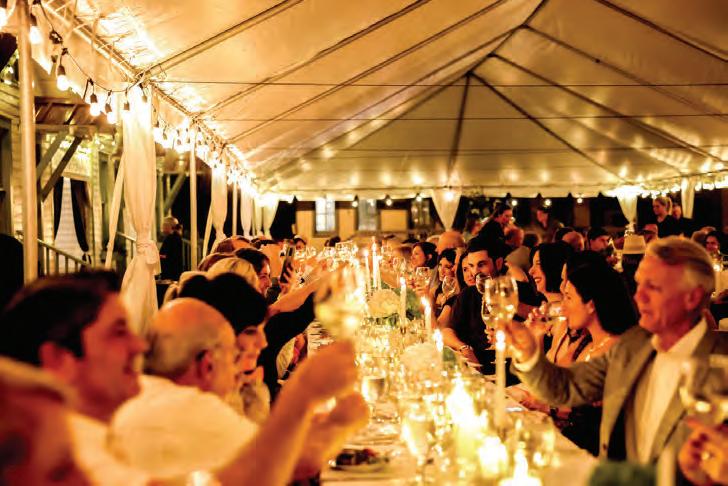
Sponsored by Tangipahoa Parish Tourism
PERSPECTIVES: ART OF OUR STATE
PRINTMAKER LESLIE KOPTCHO IS MAKING ART FROM THE ECOLOGICAL ENEMY
By Jordan LaHaye Fontenot

Artist Leslie Koptcho’s process begins in her backyard on the banks of Bayou Duplantier, where she can spot an invasive plant hevery direction she looks. There’s Japanese climbing fern, paper mulberry, giant salvinia, water hyacinth, alligator weed, and countless others. These notorious plants, each destructive in its own way here in Louisiana, are the subject of Koptcho’s latest project, Botanica Collectanea
Koptcho has worked in printmaking for decades now, treating the artform of multiples as a medium for examining the subtleties of individuality in living organisms—much, as she describes it, “like a comparative biologist.”
Studying these invasives of the Gulf Coast region, she sees a story in each plant: there is beauty, and there is strength, despite their capacity to harm our local environment. She saw an opportunity to bring awareness to the physicality of these plants—what they actually look like and the harm they can cause—by creating prints of them.
After harvesting the plants, often from her backyard, then photographing them, Koptcho photographs and draws them in various compositions based on the features she finds most intriguing—“I find them beautiful, tenacious,” she said. “They have such strong characteristics and properties.”
Koptcho uses intaglio printmaking techniques—

etching and transferring her drawings onto copper and photopolymer plates, coating them in ink, cleaning them off, then running them through a press with paper for the final print. For Botanica Collectanea, which is funded in part by LSU’s Provost’s Fund for Innovation in Research, she is creating a suite of such prints inspired by botanical studies like those in Margaret Stones’s Flora of Louisiana and The Temple of Flora by Robert John Thornton, and later by Jim Dine. To accompany each print, she is also compiling botanical notes and personal observations about the plant and its place (or imposition) in our local environment.
“I find herbals [botanical studies] especially alluring and challenging for their aesthetic qualities,” Koptcho writes in her artist’s statement. “And because they often comprise much more than basic plant identification; they can embody storytelling and magic, provide insights into cultures and place, and reveal mysterious operations of nature, malevolent or benevolent.”
Koptcho wanted to push things one step further, though. How can these plants be used, and through their use, mitigated? Each print will not only depict the invasive plants that have so captured Koptcho’s imagination but be printed on paper made from their very fibers.
“I got really excited about producing the paper itself and making an image that was not only on paper, but of paper,” she said.
When I visit Koptcho in her studio in the base-
ment of LSU’s Hatcher Hall, she has a pile of Johnson Grass arranged on a stand in front of studio lights. The fast-spreading Asian weed is known to choke out natives and crops, and to even kill livestock who eat too much of it. From a stack of multi-colored, hand-hewn papers, she pulls two different examples of the paper she’s made from the fibers—one from the leaves, one from the stems. The colors in her stack range from deep green (Hydrilla) to black (water hyacinth), and everything in between. When a plant fiber turns out to be too weak to stand as paper on its own, she’ll mix in other stronger fibers, such as paper mulberry, to create a blended result she refers to as “Swamp Paper.”
In LSU’s papermaking studio down the hall, she’s got a pot of Asian Jasmine that has been cooking down for days. “It’s tough,” she says. “But that means it’s going to produce a nice, strong paper.” After the plant matter is sufficiently cooked down, it goes into a Hollander beater to be transformed into pulp, which is formed into sheets over a sieve, pressed, and finally dried.
Because there are no available records of anyone else turning many of these plant fibers into paper, every step is an experiment for Koptcho. “It’s like cooking,” she said. “Every plant has different properties, different cooking and beating times. I feel like a pioneer. And I can leave this research behind for future papermakers to take even further.” •
lesliekoptcho.com











